HIDDEN TREASURES
GEOMETRY AND NATURE BETWEEN PAST AND PRESENT
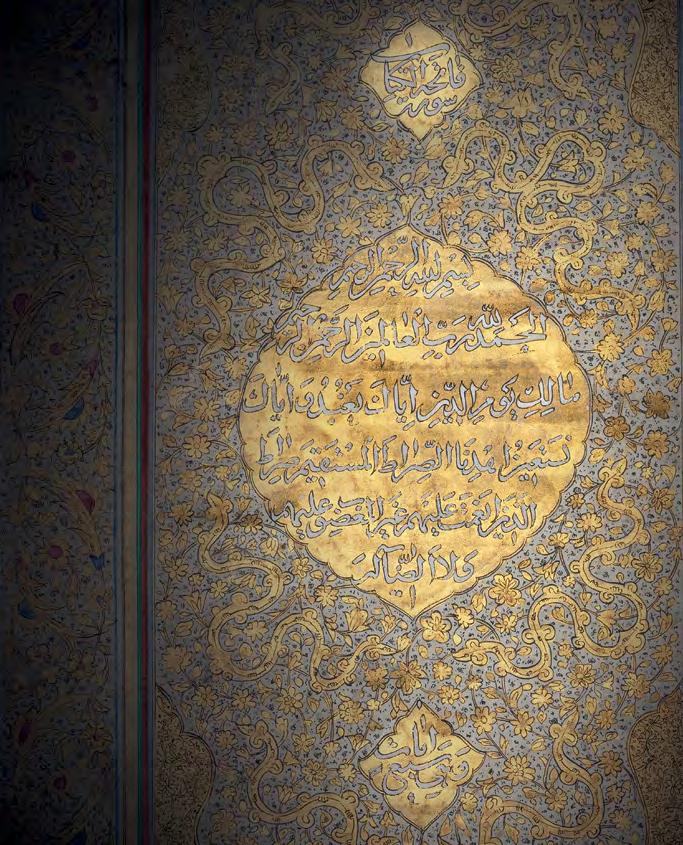
KESKINER
KENT ANTIQUES
ISLAMIC & INDIAN ART ORIENTALIST PAINTINGS



KENT ANTIQUES
ISLAMIC & INDIAN ART
ORIENTALIST
Flat 3
107 Queen’s Gate
London, SW7 5AG
England
tel. + 44 (0) 20 7370 2914
mob. + 44 (0) 7887 985951
info@kentantiques.com
www.kentantiques.com
GEOMETRY AND NATURE BETWEEN
PRESENT
HIDDEN TREASURES
PAST AND
PAINTINGS KESKINER
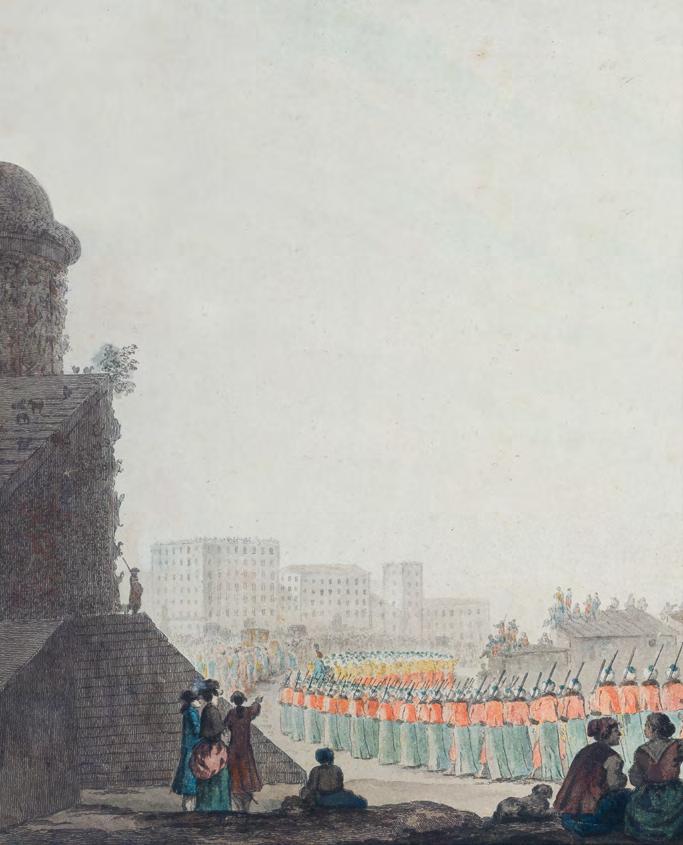
ACKNOWLEDGEMENTS
First, I would like to thank former Sotheby's Middle East Deputy Chairman and contemporary art specialist Roxane Zand, for kindly accepting to curate our stand at TEFAF Maastricht 2024. Our collaboration for a new project inspired us for the concept of our stand and this catalogue, titled: “HiddenTreasures:Geometryand Nature Between Past and Present”. I would also like to thank Conrad Shawcross, Ben Johnson, Timo Nasseri and Ebtisam Abdulaziz for their most valuable contribution to our project and consigning their works to our stand at TEFAF.
We are indebted to many distinguished experts and scholars for their assistance during the preparation of this catalogue. Special thanks are due to Dr. Julian Raby who has generously shared his opinion on various matters. We are grateful to Persian and Indian miniature painting specialist Margaret Erskine for preparing the catalogue entries of the miniature paintings. We would like to thank René Bouchara for designing our stand and emphasizing the perfect harmony and dialogue we aimed to create between the classical and contemporary art works.
I would also like to take this opportunity to express my thanks to my brother Dr. Bora Keskiner who did extensive research and wrote the texts. The effective presentation of the art works would not have been possible without the participation of Mr. Peter Keenan, Mr. Richard Harris, and fine art photographer Mr. Richard Valencia.
Mehmet Keskiner Director

PREFACE
If music is considered a universal language, so is geometric abstraction whose origins lie in the laws of nature, and which early Islamic art brought into the visual canon as far back as the 7th century CE.
Islamic-inspired geometric abstraction has long been admired for its intricate patterns and motifs that have captivated artists, scholars, and audiences around the world. Rooted in the rich traditions of Islamic culture, it draws heavily from nature and demonstrates a profound connection to the natural world. From the elaborate geometric designs adorning architectural marvels to the delicate patterns found in manuscript illustrations, there is a deep reverence for the divine order and mathematical structure that underlies this beauty. Whether in Iznik ceramics or Ottoman textiles, in Islamic metalwork or Mughal miniature painting, we witness the presence and homage to nature.
At the heart of geometric abstraction is the principle of 'unity' - a holistic worldview that has inspired artists to seek harmony and balance in their compositions. Geometric patterns, commonly featuring stars, polygons, and arabesques, are meticulously crafted to reflect the mathematical precision and infinite complexity of natural forms, not only symbolizing the eternal nature of divine order but also mirroring the repetitive patterns found in nature, from the petals of a flower to the crystalline symmetry of snowflakes, from the spiralling patterns of seashells to the tessellating formations of honeycombs. Highlighting the underlying structures and rhythms found in nature, the intricate interplay of shapes and symmetries reflects the order and balance observed in an organic environment. We see the interconnectedness
of all creation, mirroring the interconnectedness of natural phenomena and the universe itself.
The enduring legacy of geometric abstraction and its relationship to nature continues to influence contemporary art and design around the world. Artists from both Middle Eastern and Western traditions have long drawn inspiration from geometric patterns and natural motifs - we only have to look more closely at the post-War movements of Opt Art, Constructivism, De Stijl, and Kinetic Art - even Bauhaus and Cubism - to see this quiet tide of influence. The transcendent allure of this type of abstraction continues to resonate across cultures, inspiring new generations of artists to seek meaning and inspiration in it.
Kent Antiques is proud to present a curated show based on this over-arching, unifying theme that underscores cultural commonality rather than separation. We look at the extraordinary creations of British artist Conrad Shawcross RA whose emphasis on the mathematical foundations of spatial order through the measure and relationships of forms has received global acclaim. Evolving from his earlier experimentation with grids and repetition, Conrad's more recent work (Patterns of Absence (MS20D17∆) painted and mirror polished stainless steel, mechanical system 200 x 200 x 16 cm.) explores the play of refracted light, the power of negative space, and the patterns generated through the lens of reflective metals. Dialoguing with Conrad's work, is a highly intricate piece by German-Iranian artist Timo Nasseri (STUPA Sculpture, Steel, magnets 3 + 1AP Artwork size, 19.0 x 19.0 x 74.0 cm) that references the convergence of architecture, philosophy and spirituality.
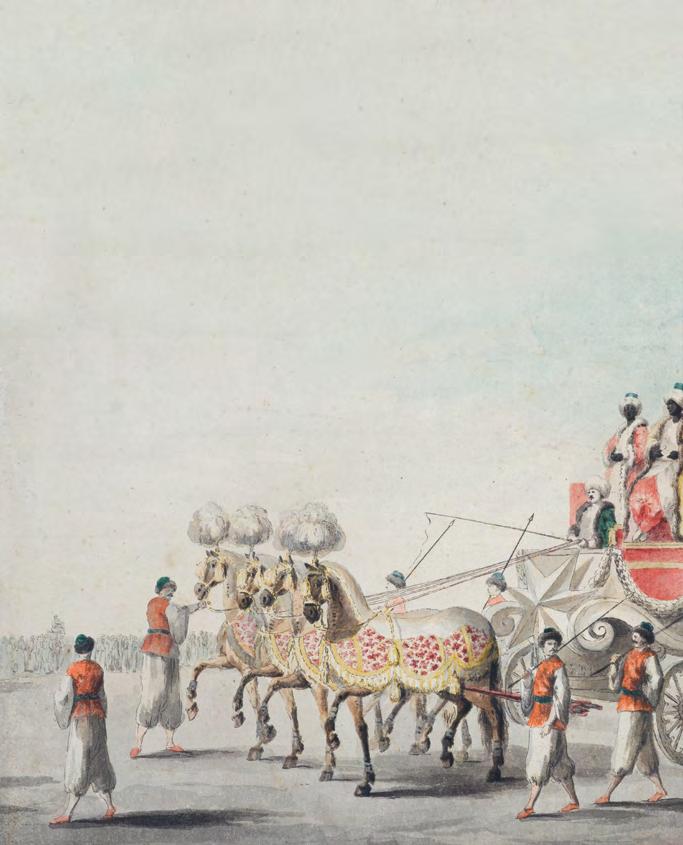
The work engages with the mystical and meditative qualities of this ancient structure, inviting viewers to contemplate impermanence, the nature of existence, and the interconnectedness of all things. Blending, yet contrasting beautifully with the former two intricate works, is a stunning bold composition in blue by US-based Emirati artist, Ebtisam Abdulaziz, that focuses on the role of colour in invoking feelings of tranquillity, depth, and infinity. Associated with the natural world's most prevalent colour (the sky and the sea), Ebtisam plays with shade and intensity with the same artistry as Vasarely, yet injects an added layer of symbolism. Another extraordinary work, this time by British artist Ben Johnson, encapsulates in its magnificent scale and stunning realism - a coup de force of hyper-realism yet with greater depth and homage to the iconic building it depicts than what we associate with hyper-realism. Known for his architectural paintings and his love of geometry and harmony, Johnson’s I'timad ud Daulah - Jaali brings to life the smallest detail, drawing in the viewer as if by 'virtual reality'. To view the threedimensionality of the STUPA 'skyscraper' against the twodimensional representation of a detail from the exterior wall of the Mughal emperor Jahangir’s grand-vizier I'timad ud Daulah’s (d. 1622) tomb, is a unique privilege which enhances the appreciation of both works.
4

Kent Antiques encourages the juxtaposition of the classical and the contemporary as the discerning way to collect and to live with artefacts. Among the classical art works specially selected for their dialogue and harmony with the contemporary works, there is a stunning Iznik pottery hexagonal blue and white tile, previously acquired from the collection of Baron Alphonse Delort de Gléon (1843-1899). An extremely fine 17th century Ottoman voided silk velvet panel with gold and silver thread, from the famous Appleby collection, has a strikingly powerful design remarkable for its geometric symmetry and stylized tulips. A rare and important panel of three Iznik tiles produced for the imperial chamber of Sultan Murad III (1574-1595), with an impeccable three-generation provenance (from the collection of Dr. Jules Froment (1878-1946) is a brilliant example of combining elements of symmetrical design and stylized nature.
The dissection of time-lines is often arbitrary, and appreciating artworks for relationships, stories and shared symbols rather than just periods is far more rewarding. Our world is composed of shared atoms, shared experiences and shared historic evolutions. What better celebration of these commonalities than to observe the journey of humanity in a holistic and over-arching way?
Roxane Zand
1 RARE AND IMPORTANT PANEL OF THREE IZNIK TILES PRODUCED FOR THE IMPERIAL CHAMBER OF SULTAN MURAD III (R. 1574-95)
Ottoman Empire
Circa 1575
Attributable to ‘Master
Mehmed of Iznik’
Dimensions: (Each Tile)
25 x 25 cm.
Panel of three Iznik tiles, painted under transparent glaze in coral red, cobalt blue and green, each finely decorated with a central composite hatayi blossom and two saz leaves emerging from their base, outlined in black, on a brilliant white background.
The present Iznik tiles are identical to those used for decorating the walls of the imperial chamber of Sultan Murad III (r. 1574-95) [Sultan III. Murad Sofası] in the Topkapı Palace, Istanbul. Please see, Ara Altun & Belgin Arlı, Tiles – Treasures of Anatolian Soil – Ottoman Period, Kale Group Cultural Publications, Istanbul, 2008, pp. 105108. This chamber, which constitutes the oldest structure preserved today within the palace, was built in 1578 by the famous Ottoman court architect Sinan on the site of the former chamber of Sultan Süleyman the Magnificent, which was previously damaged by fire.
The tiles from the privy chamber of Sultan Murad III are especially important because the name of the tile master and year of their production are known. The master’s name Mehmed is recorded in an imperial decree, dated 1575, when tiles were ordered by Sultan Murad III from Iznik (Ara Altun & Belgin Arlı, ibid, p. 107).
We find Iznik tiles featuring the same design in museum collections around the world. Among these the tile panel in the Gulbenkian Museum (Inv. No. 1663) can be mentioned. Please see, Maria d’Orey Capucho Queiroz Ribeiro, Iznik Pottery and Tiles in the Calouste Gulbenkian Museum. Lisbon, 2009, p. 118. Also see, In Harmony –The Norma Jean Calderwood Collection of Islamic Art, Harvard Art Museums, 2013, p. 197, No, 43.
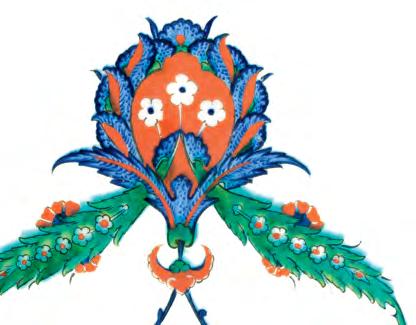
The saz leaf, seen on our tiles, is an important motif frequently used by the artists in the Ottoman court atelier. The first representative of the saz style at the Ottoman palace was Şahkulu, an artist brought from Tabriz by Sultan Selim I (r. 1512-1520). This style was a departure from the classical miniature painting, characterised by pictures drawn with a brush in black ink, featuring long pointed leaves, giving birth to the term ‘saz leaf’. Paintings in the saz style may remind a thick forest with intertwined curved leaves and khatai blossoms. In fact, the word saz, used to mean ‘forest’ in the Dede Korkut stories, that


dates back to the 10th or 11th century. For further information please see, Motif from the Sadberk Hanım Museum Collection (written by Turgut Saner, Şebnem Eryavuz and Hülya Bilgi), Sadberk Hanım Museum, Istanbul, 2020, p. 106.
There are many hypothesis about the origin of the khatai motif. One of these is that this motif was created by an artist who travelled from Herat to China, or that it was inspired by the lotus, but all agree that the name derives from Hitay, a region of China. For further information please see, Motif from the Sadberk Hanım Museum Collection (written by Turgut Saner, Şebnem Eryavuz and Hülya Bilgi), Sadberk Hanım Museum, Istanbul, 2020, p. 104.
The present tiles are rare and important examples of the art of Ottoman Iznik pottery with their perfect design, vibrant colours and brilliant firing.
Provenance
Dr. Jules Froment (1878-1946) Collection by repute.
Then by descent, Professor Roger Froment (1907-1984) Collection Ex-Odile Froment Benoit Collection
Dr. Jules Froment (1878-1946)
The first collector of the Froment family, who first owned the present three Iznik tiles, was Jules Froment, a famous French neurologist. During World War I he was stationed at Rennes, where he treated soldiers. He worked as a professor in Lyon, and he published his medical research on neurology. He died in 1946.
Professor Roger Froment (1907-1984)
Professor Roger Froment inherited the present tiles from his father’s collection. Roger, like his father, became a doctor by profession. He developed a deep interest in Islamic art in the early stages of his career. First, he was interested in Persian carpets. His interest evolved and he became fascinated by the beauty of Islamic manuscripts, ceramics, and textiles. These three fields constituted the heart of his collection. Over the years, he improved a good taste, developed firm knowledge and a good eye for fine Islamic art works. His collection expended as he followed the advice of prominent Islamic art dealers such as Jean Soustiel.
Roger managed to pass down his love and passion for Islamic art to his daughter Odile and his son-in-law. After Roger’s death, when they inherited his works of art, they cherished this collection with a similar enthusiasm. The present panel of three Iznik tiles is coming from this family collection which was lovingly collected, looked after and enjoyed by successive generations.
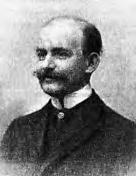

8
Professor Roger Froment (1907-1984)
Dr. Jules Froment (1878-1946)

2 IMPORTANT IZNIK BLUE AND WHITE POTTERY TILE

Ottoman Empire
Circa 1545-1550
Dimension: 26 x 26 cm.
Fritware, painted under clear glaze with cobalt blue and turquoise; the composition consists of intertwined saz leaves and khatai blossoms, each decorated with white flower heads.
The combination of cobalt blue and turquoise seen on the present tile can also be found on the famous Sünnet Odası (Circumcision Room) tiles in the Topkapi Palace Museum, Istanbul. Especially the saz leaves and khatai blossoms on the side panels of the Circumcision Room tiles feature similar use of cobalt blue and turquoise. Please see, Ahmet Ertuğ and Walter Denny, Gardens of Paradise – 16th Century Turkish Ceramic Tile Production, p. 81.
An important Iznik ‘Damascus style’ dish with similar cobalt blue and turquoise is published in our gallery’s 2017 catalogue Kent Antiques Islamic and Indian Art – Works of Art from the Islamic World and Orientalist Paintings, London, 2017, No. 18.
Comparable Iznik dishes and footed bowls similarly decorated with khatai blossoms in cobalt blue and turquoise, produced between 1545-1550, are published in Nurhan Atasoy & Julian Raby’s Iznik – The Pottery of Ottoman Turkey, Alexandria Press, London, 1994, pl. 352 and pl. 358.
Three Iznik tiles, identical to the present tile, are in the Louvre Museum (Inv. No. AD 5971/1, AD 5971/3, AD 5971/4), Paris. Please see, https://collections.louvre.fr/en/ark:/53355/cl010332784
A counterpart of the present tile is published in Couleurs d'Orient - Arts et arts de vivre dans l'Empire Ottoman, Catalogue d'exposition, Villa Empain, Fondation Boghossian, Bruxelles, 18 November 2010 - 27 February 2011, p. 47.
A similar tile decorated with saz leaves and flower heads is found in the Cincinnati Museum. Counterparts of the Cincinnati tile are found in the Rüstem Pasha Mosque in Istanbul. See, Ara Altun & Belgin Arlı’s Tiles – Treasures of Anatolian Soil – Ottoman Period, Kale Group Cultural Publications, Istanbul, 2008, p. 183, fig. 204.
This is a rare tile displaying wonderful precision in outlining and colours which is a result of masterful brushwork and excellent firing.
Provenance
A. Jacob Collection (1942-1988), Paris.
10

3 IMPORTANT IZNIK POTTERY HEXAGONAL BLUE & WHITE TILE
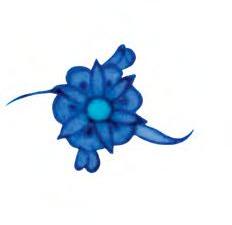
Painted under clear glaze with cobalt blue and turquoise; the composition consists of intertwined blossoms and flower heads. This tile belongs to a small group of Izniks produced around 1530 which are closely related to the famous Circumcision Room (Sünnet Odasi) tiles in the Topkapi Palace, Istanbul. Our tile bear aesthetic and stylistic similarities with the hexagonal blue and white Circumcision Room tiles. Please see, Ahmet Ertuğ and Gardens of Paradise – 16th Century Turkish Ceramic Tile Production, Ertuğ & Kocabıyık,
The present example presents a striking resemblance to a group of eight identical tiles in the Louvre Museum (inv. no. OA 7456/14, OA 7456/16, OA 7456/19, OA 7456/21, OA 7456/22, OA 7456/24, OA 7456/27, OA 7456/29), all previously in the collection of Baronne Alphonse Delort de Gléon (1843-1899). The name ‘Gouron 16’ is inscribed on the reverse of the present tile, in reference to Marcel Gouron-Boisvert, an architect involved in the designing of the Delort de Gléon villa in Cairo where Iznik tiles were used to decorate the interiors. Please see, Mercedes Volait, Antique Dealing and Creative Reuse in Cairo and Damascus 1850-1890, Brill, 2021, p.157.

becoming a dominant feature in Karahanid, Ghaznavid, Fatimid, Abbasid, Andalusian Umayyad and Mamluk art and above all becoming popular in Anatolia, also known as Rum, from which the name rumi derives. Some outstanding examples of rumi motifs are found in Anatolian Seljuk stone carving and woodwork usually combined with lotus and palmette motifs.
An identical Iznik tile is in the Ashmolean Museum (E.A. 1978.1536). Please see the link: http://jameelcentre. ashmolean.org/collection/6/653/834
Another identical example is in the Harvard Art Museums, please see the link: https://harvardartmuseums.org/collections/ object/216298?q=1960.102
The last of the recorded comparable Iznik tiles is in the Ömer M. Koç Collection. Please see, Hülya Bilgi, AteşinOyunu–SadberkHanımMüzesiveÖmerM.Koç KoleksiyonlarındanİznikÇiniveSeramikleri, Vehbi Koç Vakfı, İstanbul, 2009, p. 96, cat. no. 29.
Provenance
Ex-Private French Collection, Purchased from Galerie Moreau-Gobard, between 1960-1980.

The rumi motif has a special place in the history of Ottoman decorative elements. This motif is called rumi by the Ottomans, islimi by the Persianate dynasties and arabesque by the Europeans. There are divergent views on the origin of the motif, some regarding it floral in origin, others as zoomorphic, such as the theory that it derives from the wings of birds or mythical animals in central Asian art. The motif developed in Samarra in the 9th century and spread to the Islamic lands,
By repute acquired from the collection of Baronne Alphonse Delort de Gléon (1843-1899). The name ‘Gouron 16’ is inscribed on the reverse of the present tile, in reference to Marcel Gouron-Boisvert, an architect involved in the designing of the Delort de Gléon villa in Cairo where Iznik tiles were used to decorate the interiors. Please see, Mercedes Volait, Antique Dealing and Creative Reuse in Cairo and Damascus 1850-1890, Brill, 2021, p. 157.
Marcel Gouron-Boisvert
French architect Marcel Gouron-Boisvert was born in 1840. He graduated from the École des Beaux-Arts de Paris. He went to Egypt in 1872 to work on the construction of the equestrian statue of Muhammad Ali Pasha in Alexandria. He worked on the Zogheb Palace in Alexandria. Marcel also worked -together with his friend Charles Guimbard- on the designing of Saint-Maurice’s House in Cairo. Iznik tiles, like the present one, were reused in these interiors to decorate door frames and surroundings. See for example the photograph in ibid, p. 162, Fig. 123.
12
Portrait of Baron Delort de Gléon, 1883 Gunnar Berndtson (1854-1895),
A corner of architect Ambroise Baudry’s Studio at his house in Cairo, undated [After 1876], After Mercedes Volait, Antiques DealingandCreativeReuseinCairoand Damascus 1850-1890, Brill, 2021, p. 162.

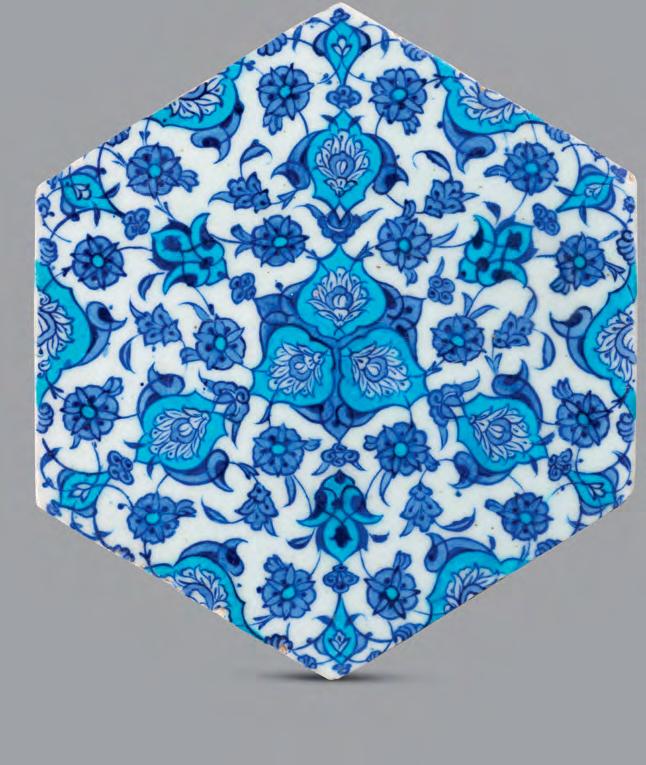
4 LARGE IZNIK POLYCHROME POTTERY TILE SPANDREL
Ottoman Empire
Circa 1580
Dimensions: 29.9 x 30.5 cm.
The cobalt-blue ground decorated under the glaze with coral red and white Chinese cloud bands, within turquoise and cobalt-blue lobed borders, intact.
Decorated spandrels were in use in Turkish interior decoration from as early as the Seljuk period, for example those from the Kubadabad Palace in Beyşehir which are in stucco and decorated with peacocks. Iznik tiles later became a popular method of decorating interiors. Iznik tile spandrels exist in several museum collections in Istanbul, New York, Copenhagen, Paris and Kuwait.
The Chinese cloud was one of the main motifs from the Ottoman decorative repertoire and its was frequently used by the court workshop during the 16th century.
A tile panel decorated with grapes and spring flowers on the east and west walls of the Takkeci Ibrahim Aga Mosque in Istanbul features corners with similar aesthetic. These corners are decorated with white Chinese cloud on a coral red ground. Please see Belgin Demirsar Arlı & Ara Altun’s Tiles: Treasures of Anatolian Soil – Ottoman Period, Kale Group, Istanbul, 2008, p. 264, Figs. 301.
The present tile is important both for its size and its jewel-like colours.
Provenance
Private UK Collection
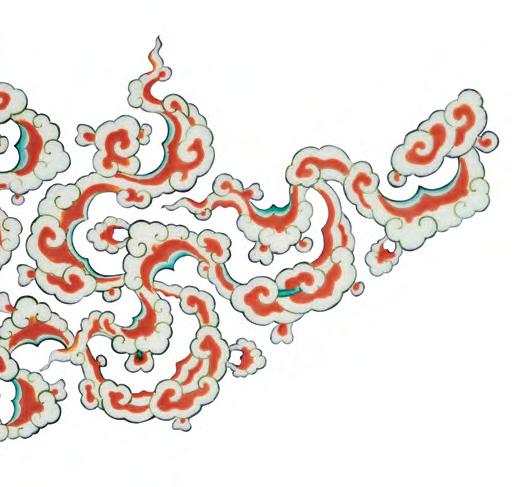
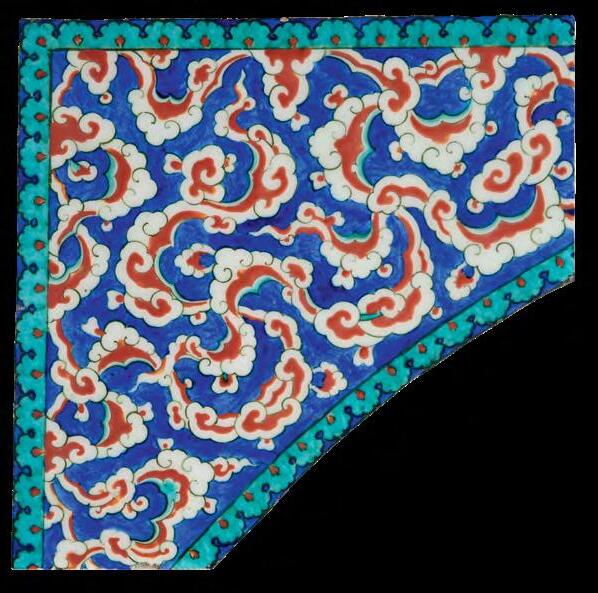

Ottoman Empire
Second Half of the 16th Century
Dimensions: 26 x 12.5 cm.
IZNIK POLYCHROME POTTERY BORDER TILE DECORATED WITH CHINESE CLOUDS
Painted under clear glaze with coral red, blue, turquoise, decorated with intertwined white Chinese clouds with coral red dots and bands on both sides. Loops of the Chinese clouds are highlighted with coral red.
The Chinese cloud or ‘stylised cloud band motif’ is one of the most favoured motifs of the Ottoman decorative repertoire; frequently used by the artist members of the palace workshop (nakkaşhâne) in the 16th century. Chinese clouds were widely used to decorate Ottoman ceramics, textiles, manuscripts, carpets, glass and woodwork. In Chinese art, this motif is primarily associated with the strength of the dragon and sometimes represents the smoke coming out of its mouth. However, in Ottoman art, it was generally interpreted as a stylized white cloud in the blue sky.
İnci Ayan Birol, “Tezhip”, TürkiyeDiyanetVakfıİslam Ansiklopedisi, vol. 41, 2012, pp. 65-68. In the present example, for instance, this appears to be the reason why the potter used blue for the background and white for the clouds.
The cloud band motifs were much favoured also by Timurid and Akkoyunlu artists. Diverse cloud motifs found in miniature paintings of the Herat and Shiraz schools, on ceramics, metalware and carpets appear to have been adopted and reinterpreted by Ottoman artists. For further information please see, Motif from the Sadberk Hanım Museum Collection (written by Turgut Saner, Şebnem Eryavuz and Hülya Bilgi), Sadberk Hanım Museum, Istanbul, 2020, p. 118.
Comparable border tiles decorated with white Chinese clouds, similarly with red in loops, can be seen in situ in the Süleymaniye Mosque, Istanbul. Please see, Ara Altun & Belgin Arlı’s Tiles – Treasures of Anatolian Soil – Ottoman Period, Kale Group Cultural Publications, Istanbul, 2008, p. 170. Iznik border tiles, decorated with similar Chinese clouds can also be found in the Louvre Museum, Paris (Inv. No. UCAD 5967/22 and UCAD 5967/28). Please see the links, https://collections.louvre.fr/en/ark:/53355/cl010332711 and https://collections.louvre.fr/en/ark:/53355/ cl010332717.
Provenance
Ex-Private French Collection. Ex-Odile Froment Benoit Collection.

16 5
Photograph of the present tile taken in 1994 with other pieces from the Odile Froment Benoit Collection.


6
RARE AND FINE IZNIK POLYCHROME POTTERY BORDER TILE
Ottoman Empire
Circa 1580
Dimensions: 26.5 x 6.5 cm.
Painted under clear glaze with coral red, blue, turquoise and green. Intertwined white Chinese clouds are decorated with coral red dots and outlining. Two loops of two Chinese clouds at both ends of the tile are highlighted with green. The design is bordered by turquoise lines running on both sides.
The Chinese cloud is one of the most favoured motifs of the Ottoman decorative repertoire; frequently used by the artist members of the palace workshop in the 16th century. Chinese clouds were widely used to decorate Ottoman ceramics, textiles, manuscripts, carpets, glass and woodwork. In Chinese art, this motif is primarily associated with the strength of the dragon and represents the smoke coming out of its mouth. However, in Ottoman art, it was generally interpreted as a stylized cloud in the sky. İnci Ayan Birol, “Tezhip”, Türkiye Diyanet Vakfı İslamAnsiklopedisi, vol. 41, 2012, pp. 65-68. In the present example, for instance, this appears to be the reason why the potter used blue for
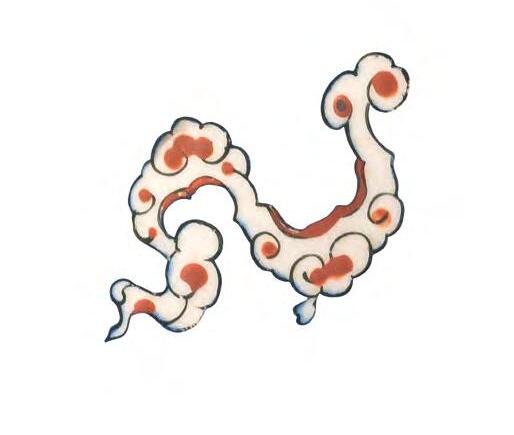

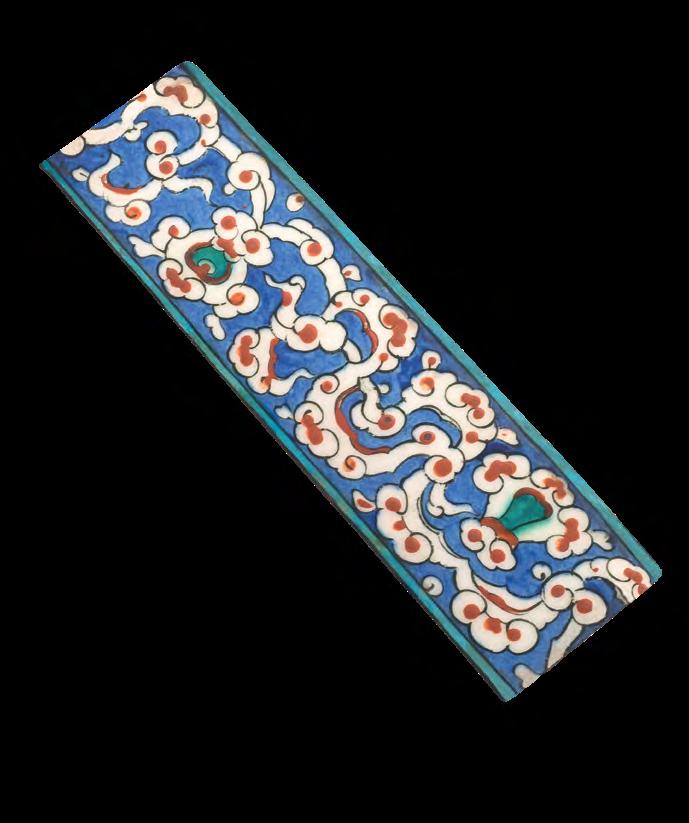
Ottoman Empire
Circa 1575-1580
Diameter: 36 cm.
A LARGE IZNIK DISH WITH FLORAL DECORATION FROM THE REIGN OF SULTAN MURAD III
IZNIK POLYCHROME POTTERY DISH DECORATED WITH RED ROSES AND BLUE SAZ LEAVES
Fritware, decorated in the ‘saz leaf and rosette’ style in coral red, blue, green, black, with a central rosette surrounded by symmetrically organized blue tulips, red roses and blue saz leaves. The rim decorated with stylized wave motifs.
Besides its exceptional size, the present dish features a very rare design which gathers different floral elements used in the Ottoman court workshop in the 16th century. Iznik dishes uniting such a variety of motifs, including tulips, roses, saz leaves surrounding a central palmette, are rare.
In the 16th century flowers gained an increasingly important role in the Ottoman decorative repertoire. Besides being a constant part of daily life, grown in gardens everywhere, from palaces to humble homes, flowers had a determining place in the decoration of Iznik ceramics, Ottoman imperial silks and velvets, manuscript illumination, miniature painting, metalwork and woodwork. Among these, tulips, roses and saz leaves became especially predominant during and after the reign of Sultan Suleyman the Magnificent (r. 1520-1566). The head of the court studio, master Shah Kulu and his successor Kara Memi introduced an extraordinary variety to the single and combined use of flowers; particularly tulips, roses and saz leaves. The design of the present dish is a perfect example of the mature phase of this evolution, under the reign of Sultan Murad III (r. 1574-1595), which displays the ideal balance and harmony created between these different elements.

A comparable Iznik dish with floral decoration in the Ex-Adda Collection (Racham Cat. 108) is published in Julian Raby & Nurhan Atasoy’s Iznik: The Pottery of Ottoman Turkey, Alexandria Press, London, 1989, pl. 482. A second comparable Iznik dish with blue saz leaves and floral decoration is in the Gulbenkian Museum, Lizbon. See, Julian Raby & Nurhan Atasoy, Iznik: The Pottery of Ottoman Turkey, Alexandria Press, London, 1989, pl. 697.
Provenance
Private Italian Collection
7 20

Ottoman Empire
Second Half of the 16th Century
Diameter: 30 cm.
IZNIK POLYCHROME POTTERY DISH DECORATED WITH BUNCHES OF SPRING FLOWERS
AND BLUE
TULIPS
Fritware, underglaze painted in cobalt blue, coral red, green, black. Decorated with bunches of red and blue spring flowers, the rim with blue double-tulip motifs and flower heads.
In the Ottoman period flowers, decorating the present dish, were a constant part of daily life, grown in gardens everywhere, from palaces to humble homes. Flowers were blessed reminders of the gardens of heaven. Foreign travellers and ambassadors who visited the empire frequently remarked about this love of flowers. The 17th century Ottoman writer and traveller Evliya Çelebi describes how vases of roses, tulips, hyacinths, narcissi and lilies were placed between the rows of worshippers in the Eski Mosque and the Üç Şerefeli Mosque in Edirne, and how their scent filled the prayer halls. As depicted in the present dish, vases of flowers adorned niches in the walls, dining trays and rows of vases were placed around rooms and pools. For further information please see, Motif from the Sadberk Hanım Museum Collection (written by Turgut Saner, Şebnem Eryavuz and Hülya Bilgi), Sadberk Hanım Museum, Istanbul, 2020, pp. 86-90.
The tulip, repeatedly used in rim of our dish, has a symbolic meaning in Ottoman art. The letters of the word tulip (Lâle [ هللا]) in Turkish and Persian are the same letters used for writing the word Allah [ الله] (God). These two words have the same numerological value in the abjad system (a decimal alphabetic numeral system in which the twenty-eight letters of the Arabic alphabet are assigned numerical values). Tulip is one of the leading decorative elements in Ottoman art; frequently used together with roses, hyacinths, saz leaves. It is also used with khatai blossoms as can be seen in the present tile. Tulip also played a role in imagery
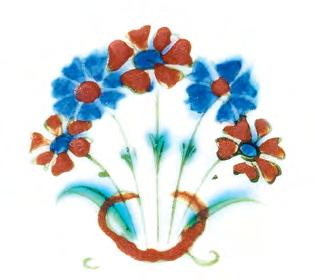
in Ottoman poetry. In many poems, tulip leaves are likened to the cheeks of the beloved. The word lāleh-khad (lâle-had), often used in Ottoman poetry, means ‘tulip-cheeked’. Tulips were among the most favoured motifs used in the Ottoman court workshops in the 16th century. The name ‘tulip’ is thought to have derived from the Turkish word tülbend (from the Persian word دنبلد [dulband]) -meaning ‘large cotton band which is used in the making of turban or headgear’- because of the fancied resemblance of the flower to a turban.
A comparable Iznik dish decorated with almost identical bunches of spring flowers, is in the Louvre Museum (Inv. No. 7880/70), Paris. Please see, Julian Raby & Nurhan Atasoy, Iznik: The Pottery of Ottoman Turkey, Alexandria Press, London, 1989, p. 234, pl 425. The present dish is a rare and important example reflecting both the high quality and awe-inspiring creativity achieved by of Iznik potters.
Provenance
Ex-Dr. Joseph Chompret Collection. (The present Iznik dish is recorded in Dr. Chompret’s personal collection register, in page 47.)
Dr. Chompret was born in Paris, in 1869. The son of a country doctor, he chose a medical career and obtained his medical degree in 1893. He specialized in stomatology, and invented the ‘syndesmotome’. For many years he was head of the Saint-Louis hospital in Paris. He was a great collector. He was interested in old cutlery, pewter, ivory and medieval enamels. However he was very enthusiastic about ceramics and his collection of French earthenware, Italian majolica and Middle Eastern ceramics is renowned. Doctor Chompret was also a great friend of museums. The Ceramic Museum of Sèvres received 280 pieces, and the Musée des Arts Décoratifs 339 pieces from Dr Chompret’s collection. Between 1931 and 1956 he was the president of the Friends of Sèvres (Amis de Sèvres) association. He died in 1956.
8 22
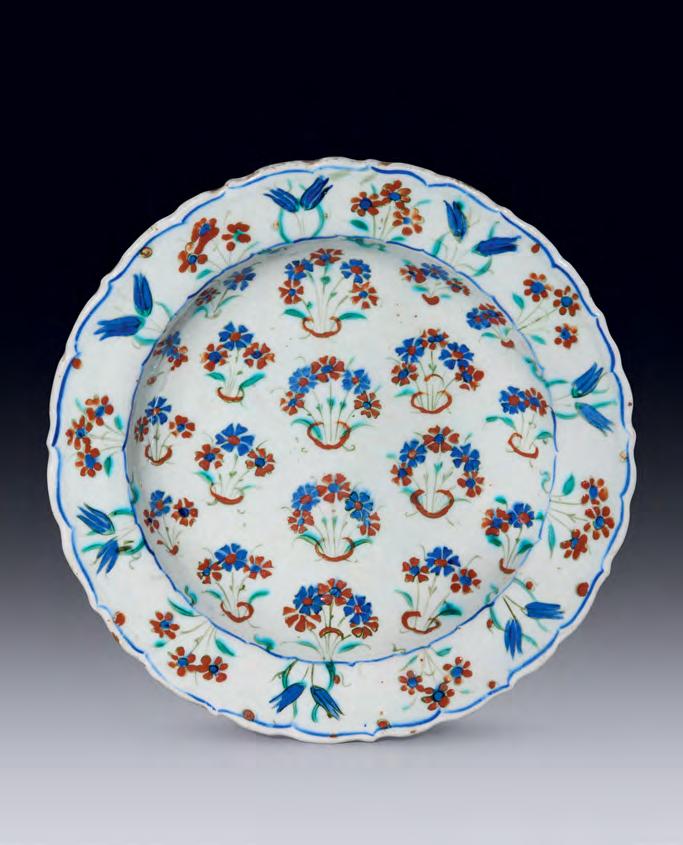
Ottoman Empire
Second Half of the 16th Century
Diameter: 26.2 cm.
IZNIK POTTERY DISH DECORATED WITH AN OWL, A DEER, A DOG, A HARE AND THREE BIRDS
Of shallow rounded form with everted rim, painted in cobalt blue, green and red with black outlines, the circular central medallion decorated with a deer, an owl, a hare, a dog and three birds interspersed with foliate motifs, the medallion encircled by a frieze of stylised petals, the rim with a frieze of alternating blue and red rosettes on a green band, the reverse with alternating stylised foliage motifs. The bold effect of the bright green ground is heightened by the potter’s decision to leave the cavetto blank, providing breathing room for the composition.
Depiction of wild animals is part of an old iconographic tradition in Anatolia and the present aesthetic can be stretched back to figural Seljuk art. In Ottoman art some of the earliest depictions of animals are found on Iznik ceramics in the 1520s and 1530s. Probably the most famous examples are those on the Sünnet Odası (Circumcision Hall) tiles, in the Topkapi Palace, Istanbul.
Nurhan Atasoy and Julian Raby in Iznik: The Pottery of Ottoman Turkey state that “the animals of the ‘greenground group’ were a collection of the exotic and the mythical. There were coursing dogs, deer, hares, ducks, monkeys, lions, horned snakes, simurghs and confronted harpies. The style has affinities with the ‘animal chase’ which was a favoured motif in Seljuk metalwork. The mixture of real and fantastic animals was, however, characteristic of the Balkan ‘teratological’ style, and although there are few precisely comparable objects, it was probably Balkan precious metalwork which inspired the Iznik potters.” For further discussion and the illustration of a closely related Ottoman silver tankard which shows dogs chasing hares please see, Nurhan Atasoy and Julian Raby, Iznik: The Pottery of Ottoman Turkey, Thames and Hudson, London, 1989, p. 276, Fig. 617.

A closely related dish is in the Musée National de la Renaissance, Ecouen (inv. no. ECL 8362), presenting an almost identical central medallion and border on a turquoise ground. Please see, Frédéric Hitzel et al. Iznik – L’Aventure d’une Collection, Musee National de la Renaissance – Chateau d’Ecouen, Paris, 2005, p. 283. A similar dish in the Benaki Museum (inv. no. 11148) follows an analogous iconographical structure with animals depicted in the medallion and a green ground. Please see, John Carswell, Mina Moraitou and Melanie Gibson’s Iznik Ceramics at the Benaki Museum, Benaki Museum - Gingko, London, 2023, p. 121.
An Iznik tankard, similarly decorated with animals on a green ground, was sold at Christie’s London, for £157,250. Please see, Art of the Islamic and Indian World sale, 6 October 2011, Lot. 319. Looking at the group as a whole, one cannot help but wonder whether not just those noted above, but indeed the majority of the group were done by the same inventive artist, with the slight differences accounted for by a development in his style over time. The small number of surviving pieces is such that it is certainly possible that these may be the work of a single individual.
Provenance

Léon-Edmond-Marie Bachelier (1862-1947). To his granddaughter Marie Lucy Giraud (b.1910), thence by descent.
Collection Guillaume Ephis (Collection Label on the Reverse).
24
9


10
FINE AND IMPORTANT IZNIK POTTERY DISH DECORATED WITH CARNATIONS, TULIPS AND
SPRING BLOSSOMS
Ottoman Empire
Second half of the 16th Century
Diameter: 32 cm.
Underglaze painted in dark lavender blue, coral red, green, black. Decorated with carnations stemming from a miniature vase, surrounded by symmetrically arranged tulips and spring blossoms; the rim with stylized wave motifs. In the colour scheme of Iznik pottery, the dark lavender blue in the present dish is very rarely used.
The tulip has a symbolic meaning in Ottoman art. The letters of the word tulip (Lâle [ هللا]) in Turkish and Persian are the same letters used for writing the word Allah [ الله] (God). These two words have the same numerological value (66) in the abjad system (a decimal alphabetic numeral system in which the twenty-eight letters of the Arabic alphabet are assigned numerical values). Tulip is one of the leading decorative elements in Ottoman art; frequently used together with roses, hyacinths, saz leaves. It is also used with khatai blossoms as can be seen in the present dish. Tulip also played a role in imagery in Ottoman poetry. In many poems, tulip leaves are likened to the cheeks of the beloved. The word lāleh-khad (lâlehad), often used in Ottoman poetry, means ‘tulipcheeked’. Tulips were among the most favoured motifs used in the Ottoman court workshops in the 16th century. The name ‘tulip’ is thought to have derived from the Turkish word tülbend (from the Persian word دنبلد [dulband] -meaning ‘large cotton band which is used in the making of turban or headgear’- because of the fancied resemblance of the flower to a turban.
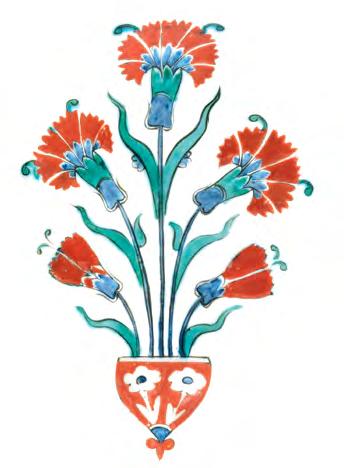
A similar Iznik dish in the Benaki Museum (inv. no. 11138) follows an analogous
iconographical structure with carnations stemming from a miniature vase. Please see, John Carswell, Mina Moraitou and Melanie Gibson’s Iznik Ceramics at the Benaki Museum, Benaki Museum - Gingko, London, 2023, p. 77. The present dish is a fine and important example of Iznik ceramic production, displaying a truly iconic aesthetic and presence with its vibrant colours and brilliant finish.
Provenance
Sir Christopher Cockerell (1910-1999), C. B. E., F. R. S., Acquired before 1962.
SIR CHRISTOPHER COCKERELL (1910-1999) CBE, FRS
Sir Christopher was born on 4 June 1910 in Cambridge, the son of Sir Sydney Cockerell, the dynamic Director of the Fitzwilliam Museum and Florence Kate Kingsford, known for her collection of illuminated manuscripts. Having read mechanical engineering at Cambridge University, Cockerell returned to research radio and electronics, later joining the Marconi Wireless Telegraph Company. At just twenty-seven he was made Technical Head of the Aircraft Research and Development Section. His next move in 1948 was to boat design and it was in December 1955 that he took out a patent, the first of 59, to cover what he described as “neither an aeroplane nor a boat nor a wheeled-land vehicle” – the hovercraft which is now used worldwide in over seventy countries. Although best remembered for the invention of the hovercraft, Sir Christopher did, in fact, have nearly a hundred patents to his name, earning him a place amongst the great British inventors and engineers of the twentieth century. Despite engineering being an allconsuming, innate part of his life, he was a man of many talents and interests which included a love for Antiquities as well as Ottoman ceramics.

26
Sir Christopher Cockerell (1910-1999)


11
IZNIK POLYCHROME POTTERY DISH DECORATED WITH TULIPS
AND SPRING
BLOSSOMS
Ottoman Empire
Second Half of the 16th Century
Diameter: 32 cm.
Fritware, underglaze painted in blue, coral red, green, black. Depicting tulips and spring blossoms on a red ground. The rim decorated with stylized wave motifs. The bold effect of the vivid coral red ground is heightened by the potter's decision to decorate the cavetto with green and blue palmettes.
The tulip has a symbolic meaning in Ottoman art. The letters of the word tulip (Lâle [ هللا]) in Turkish and Persian are the same letters used for writing the word Allah [ الله] (God). These two words have the same numerological value (66) in the abjad system (a decimal alphabetic numeral system in which the twenty-eight letters of the Arabic alphabet are assigned numerical values). Tulip is one of the leading decorative elements in Ottoman art; frequently used together with roses, hyacinths, saz leaves. It is also used with khatai blossoms as can be seen in the present dish. Tulip also played a role in imagery in Ottoman poetry. In many poems, tulip leaves are likened to the cheeks of the beloved. The word lālehkhad (lâle-had), often used in Ottoman poetry, means ‘tulip-cheeked’.

Tulips were among the most favoured motifs used in the Ottoman court workshops in the 16th century. The name ‘tulip’ is thought to have derived from the Turkish word tülbend (from the Persian word دنبلد [dulband]) -meaning ‘large cotton band which is used in the making of turban or headgear’- because of the fancied resemblance of the flower to a turban.
The present dish is rare in terms of its design. The vivid coral red, for which Iznik is so famous, is rarely used so profusely. The combination of white, light green and blue creates a graceful balance. The intertwining curves of the tulips and spring blossoms bring a sense of movement that contrasts with the still calmness of the palmettes and wave motifs in the cavetto and the rim. The small blue tulip buds, in groups of tree, symbolize the circle of life, fertility and abundance. In the Ottoman period flowers were a constant part of daily life, grown in gardens everywhere, from palaces to humble homes. Flowers were blessed reminders of the gardens of heaven. Foreign travellers and ambassadors who visited the empire, frequently remarked about this love of flowers. The 17th century Ottoman writer and traveller Evliya Çelebi describes how vases of roses, tulips, hyacinths, narcissi and lilies were placed between the rows of worshippers in the Eski Mosque and the Üç Şerefeli Mosque in Edirne, and how their scent filled the prayer halls. For further information please see, Motif from the Sadberk Hanım Museum Collection (written by Turgut Saner, Şebnem Eryavuz and Hülya Bilgi), Sadberk Hanım Museum, Istanbul, 2020, pp. 86-90.

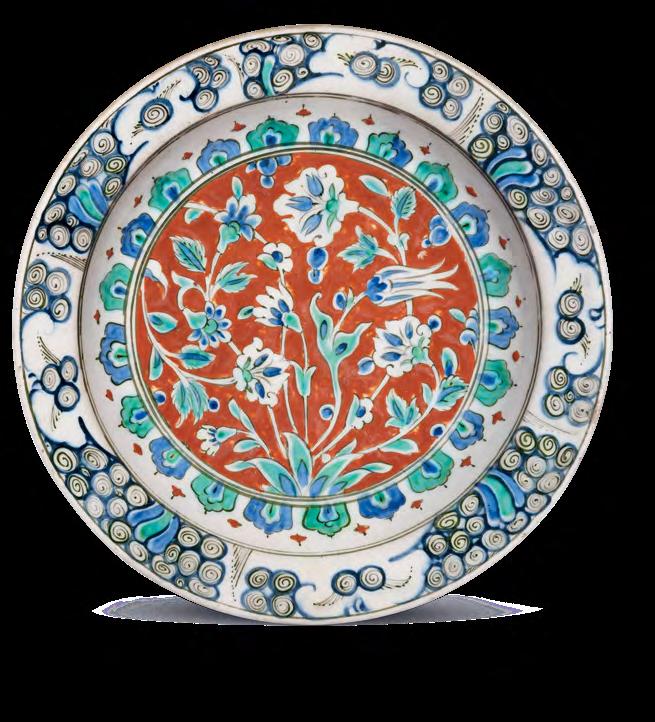
12 RARE AND IMPORTANT IZNIK POTTERY DISH DECORATED WITH ROTATING BLUE HARES
Ottoman Empire
17th century
Diameter: 26.5 cm.
Fritware, underglaze painted in blue, coral red, green, black; depicting five running blue hares. The rim decorated with stylized leaves.
Depiction of animals is part of an old iconographic tradition in Anatolia and the present aesthetic can be stretched back to figural Seljuk art. In Ottoman art some of the earliest depictions of animals are found on Iznik ceramics in the 1520s and 1530s. Probably the most famous examples are those on the Sünnet Odası (Circumcision Hall) tiles, in the Topkapi Palace, Istanbul.
Nurhan Atasoy and Julian Raby in Iznik: The Pottery of Ottoman Turkey state that the animals from this group were a collection of the exotic and the mythical. There were coursing dogs, deer, hares, ducks, monkeys, lions, horned snakes, simurghs and confronted harpies. The style has affinities with the ‘animal chase’ which was a favoured motif in Seljuk metalwork. For further discussion please see, Nurhan Atasoy and Julian Raby, Iznik: The Pottery of Ottoman Turkey, Thames and Hudson, London, 1989, p. 257.
A related Iznik vase, featuring running blue hares, is in the Benaki Museum (inv. no. 49), Athens. Please see, John Carswell, Mina Moraitou and Melanie Gibson’s Iznik Ceramics at the Benaki Museum, Benaki Museum - Gingko, London, 2023, p. 118.
An Iznik dish, similarly decorated albeit with running blue foxes, is in the Ömer M. Koç Collection. Please see, Hülya Bilgi’s AteşinOyunu–SadberkHanımMüzesiveÖmerM. KoçKoleksiyonlarındanİznikÇiniveSeramikleri
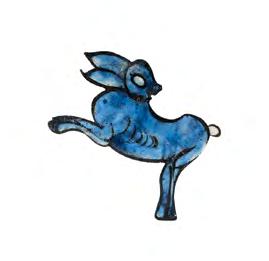
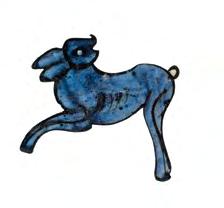

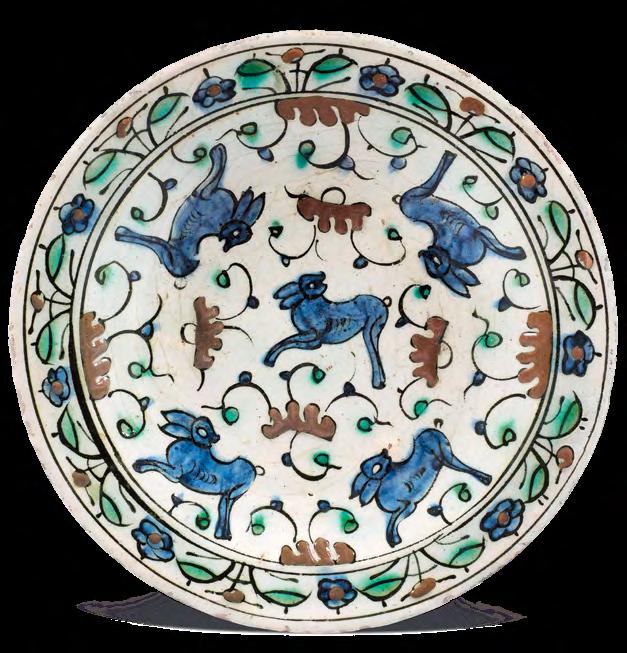

Ottoman Empire
18th Century
Height: 17 cm.
KUTAHYA POTTERY JUG DECORATED WITH CARNATIONS AND SPRING BLOSSOMS
With a globular body, long slightly flaring neck, straight cut rim and curved handle, decorated in blue, green, yellow, manganese purple and red with black outlines, with stylised carnations and spring blossoms interspersed with foliage motif, the rim decorated with a zigzag dotted band, the handle painted with a band of spring flowers, drop-shaped maker’s mark to the underside.
The city of Kütahya lies outside Istanbul, in the far north-west of Turkey. Along with Iznik, Kütahya was one of the great centers of Ottoman ceramic production. Colourful and imaginative, the tiles and vessels produced by the potters of Kütahya are highly collectible examples of Ottoman art. In the 18th century, one of the principal forms produced in Kütahya was jugs like the present one. A diverse range of these jugs were produced for the daily use of the Ottoman elite.
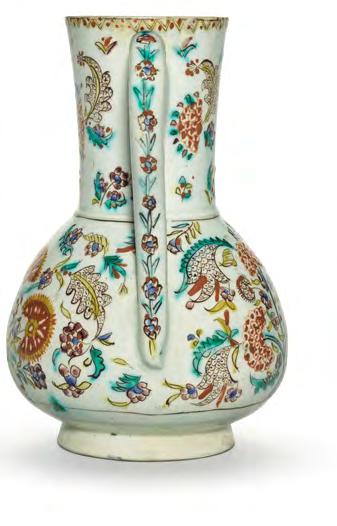
A Kütahya jug decorated with similar spring blossoms is published in Bernard Rackham, Islamic Pottery and Italian Maiolica, Faber & Faber, London, 1959, pl. 99a, no. 244.
The drop-shaped maker’s mark is published in the list of Kutahya maker marks in Garo Kürkman’s Toprak, Ates¸, Sır – Tarihsel Gelis¸imi, Atölyeleri ve Ustalarıyla Kütahya Çini ve Seramikleri, Suna ve Inan Kıraç Vakfı, Istanbul, 2005, p. 266.
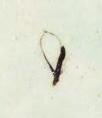
13
Maker’s Mark at the Bottom


Ottoman Empire
Signed: Hafiz Muhammad
Rashid
Dated: 1296 A.H. / 1878 C.E.
Dimensions: 19.5 x 12.5 cm.
QUR’AN RECITATION DIPLOMA WITH A PEDIGREE LINE STRETCHING BACK TO PROPHET MUHAMMAD
RARE OTTOMAN QUR’AN RECITATION ( QIRA‘AT ) DIPLOMA GRANTED AND COPIED BY HAFIZ MUHAMMAD RASHID, THE IMAM OF SULTAN ABDULHAMID II (R.1876-1909)
Arabic manuscript on paper, 11 leaves, 2 fly leaves, 15 lines to page, frontispiece illuminated in gold, red, green, purple pigments; written in naskh in black ink, ruled in gold and black, verses/sentences/phrases separated by gold roundels, in its original gilt, green leather binding.
The present manuscript is a rare Qur’an Recitation (Qira‘at) diploma granted to Hafiz Ismail Hakki b. Suleyman by Hafiz Muhammad Rashid, the imam of Sultan Abdulhamid II (r. 1876-1909), dated 1296 A.H. / 1878 C.E.
In the text of the diploma, the pedigree line of Hafiz Muhammad Rashid’s Qur’an recitation masters is listed as follows, stretching back to the Prophet Muhammad:
Hafiz Abdullah Efendi imam of the Ayasofya Mosque
Hafiz al-Hajj Mustafa Istanbuli, imam of the ShebSafa Kadin Mosque
Hafiz al-Hajj Ahmed Efendi, imam of the Nusretiye Mosque

Hafiz Ahmed al-Hifzi Khalid al-Naqshbandi Sheikh al-Qurra’
Al-Sayyid Mustafa AL-Naqshbandi al-Muwaqqit
Sheikh Omer bin Khalil al-Boluvi
Sheikh Hasan bin Hasan al-Busnavi
Al-Hajj Sheikh Ali al-Viidini
Al-Hajj Ahmed al-Sufi al-Kastamuni
Al-Sheikh al-Hajj Muhammad al-Na‘imi
Al-Sheikh al-Hajj Husayn bin Murad al-Erzurumi
Hafiz Ali al-Mansuri
Al-Sheikh al-Sultan Mizahi
Al-Sheikh Sahhaz al-Yamani
Muhammad al-Buqri
Sheikh Abd al-Rahman al-Yamani
Nasir al-Din al-Talavi
Sheikh Zakariya al-Ansari
Fakhr al-Din al-Dharir
Muhammad bin Yusuf al-Jazari
Abi Muhammad Abd al-Rahman al-Baghdadi
Abi Abdullah bin Abd al-Khaliq al-Misri
Sheikh Abi al-Hasan al-Shatibi
Abi al-Qasim al-Umavi
Imam al-Qurra Abi Umar
Abi al-Fath Faris
Qalun al-Madani
Abi Ja‘far Yazid
Ibn ‘Abbas
Abi Bin Ka‘b al-Harzaji
PROPHET MUHAMMAD
Hafiz Muhammad Rashid’s seal at the end of the colophon bears the signature of the seal-maker ‘Majdi’.
Provenance
Ex-Private French Collection.
34
14
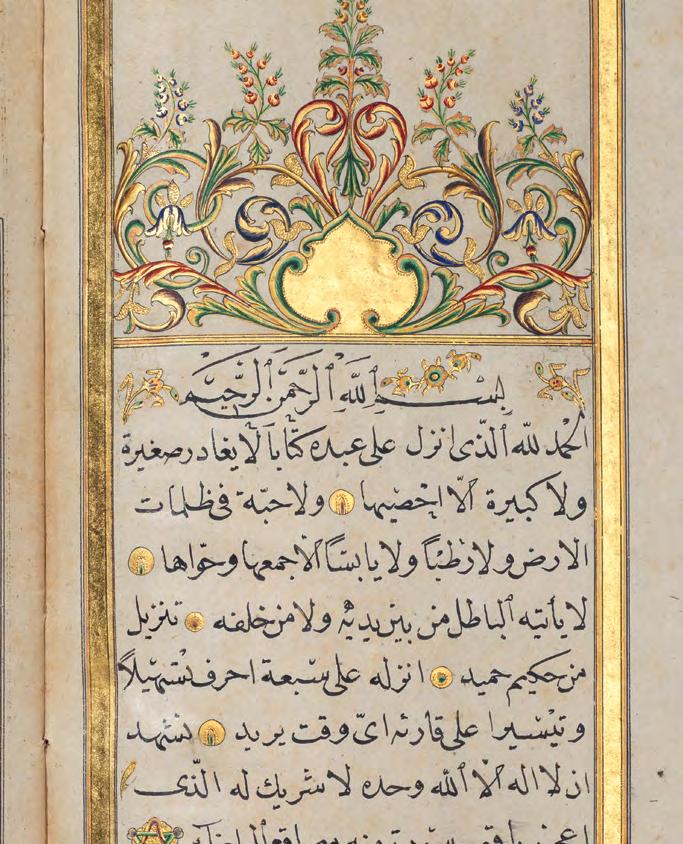
Ottoman Empire
Signed: Osman al-Uwaisi Khadim al-Khirqah al-Sharif (the keeper of the Mantle of the Prophet Muhammad)
Dated: 1196 A.H. / 1781 C.E.
Dimensions: 20 x 13 cm.
THE LIFE OF THE PROPHET MUHAMMAD (SIYAR NABI) COPIED BY OSMAN AL-UWAISI, THE KEEPER OF THE MANTLE OF THE PROPHET MUHAMMAD
DURRAT AL-TAJ FI SIRAT SAHIB AL-MI‘RAJ (THE PEARL OF THE CROWN ON THE LIFE OF THE PROPHET MUHAMMAD, THE MASTER OF ASCENSION TO HEAVEN)
Manuscript on paper, 144 leaves, 2 fly leaves, 17 lines to page, frontispiece illuminated in gold, red, green, blue, pink pigments; written in nas-ta‘liq in black and red ink, ruled in gold and black, in its original gilt, brown leather binding.
This is a rare copy of the first Siyar Nabi text written in Turkish, by the Ottoman court poet Veysi (15611628). It is copied by Osman al-Uwaisi Khadim al-Khirqah al-Sharif (the keeper of the Mantle of the Prophet Muhammad). First volume of two.
The present manuscript is the history of the Prophet Muhammad’s life, including the following sections:
The genealogy of Prophet Muhammad
The discovery of the Zam-zam well
The marriage of the Prophet Muhammad’s father
Abdullah to Aminah
The names and titles of Prophet Muhammad
The birth of Prophet Muhammad
Prophet Muhammad’s journey to Damascus
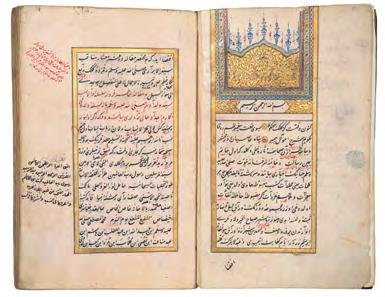
Prophet Muhammad’s marriage to Khadija
The restoration of the Holy Ka‘bah
The beginning of the revelation of the holy Qur’an
The first Muslims and Prophet Muhammad’s invitation to Islam
Caliph Umar’s convertion to Islam
The Mi‘raj of Prophet Muhammad
Prophet Muhammad’s teachings of prayer
The convertion of the Ansar to Islam
- The Hijra of Prophet Muhammad to Medina.
THE CALLIGRAPHER: OSMAN AL-UWAISI, THE KEEPER OF THE MANTLE OF THE PROPHET MUHAMMAD
Sayyid Osman al-Uwaisi b. Sayyid Muhammad Said b. Osman, better known as Osman al-Uwaisi was the Sheikh of the Hirka-i Sherif Camii (the Mosque of the Mantle of the Prophet – ar. al-Burdat al-Sharif-) in the Fatih district, Istanbul. He was the great-grand-son of Shukrullah al-Uwaisi, who brought the Burda (the mantle of the Prophet Muhammad) to Istanbul on Sultan Ahmed I’s (r. 1603-1617) order. Shukrullah al-Uwaisi was a successor of Uwais al-Qarani (d. 656) who received the mantle of the prophet as a personal gift from from Caliph Umar and Caliph Ali on the command of Prophet Muhammad. Osman al-Uwaisi was an eminent calligrapher particularly celebrated for his mastery in the nas-ta’liq script. He studied calligraphy under the supervision of master calligrapher Dedezade Mehmed Said Efendi (d. 1749). The date of his death is unknown.
Provenance
Private French Collection. The manuscript was part of the collection of a famous French orientalist bookseller founded in 1930 and active until 1977.
15
36
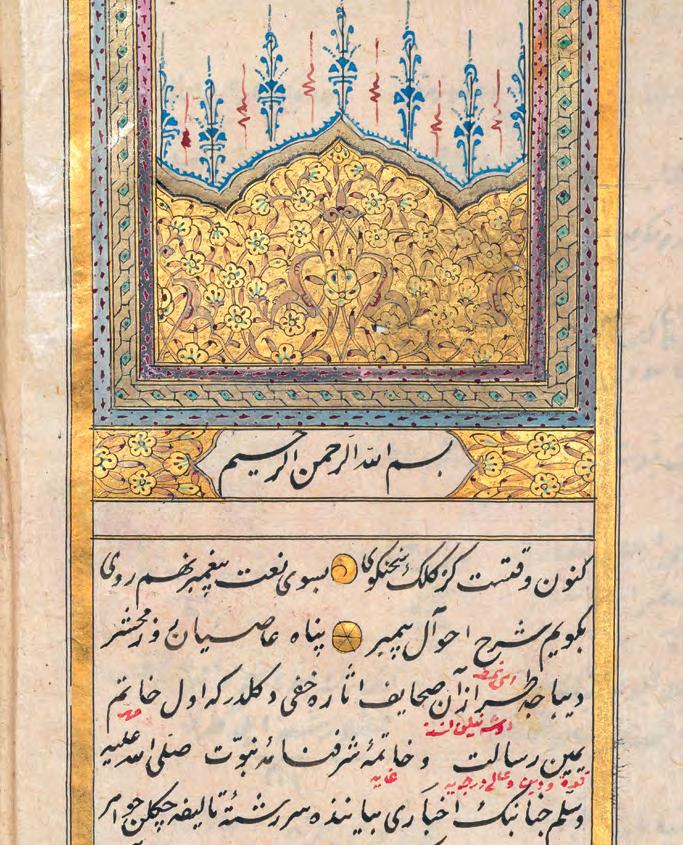
16
IMPERIAL
QAJAR QUR’AN COPIED FOR NASIR AL-DIN
SHAH’S SON-IN-LAW PRINCE MUAYYAD AL-DAVLA (D. 1912)
Qajar Persia
Signed: Ismail bin Visal
Dated: 1278 A.H. / 1861 C.E.
Dimensions: 17.5 x 10.5 cm.
Manuscript on paper, 240 leaves, 2 fly leaves, 19 lines to page, opening with three consequent double pages with the index, prayers and the Surat al-Fatiha and the beginning of Surah al-Baqara lavishly illuminated in gold and polychrome pigments; written in naskh in black ink, ruled in gold, red, green; surah headings illuminated in gold and polychrome, verses separated by gold roundels, in its original lacquered binding.
The dedication above the colophon line:
“Hasb al-amr-i Navvab-i Mustatab Ashraf-i As’ad-i Vala
Shahzadah Muayyad al-Davla Dama Jalalahu Tahrir Shud”
(Written on the command of the most esteemed and exalted Prince Muayyad al-Davla may his glory be perpetual).

Ismail b. Visal Shirazi (d. 1869)
Muhammad Ismail b. Visal was born in 1246 A.H./1830 C.E. in Shiraz. He was the fifth son of the famous Qajar court calligrapher and poet Muhammad Shafi’ Visal Shirazi. Ismail himself was also a poet and used the pen-name ‘Tavhid’. He became a master calligrapher. He was praised especially for his skill in naskh script. His calligraphic works can be found in museums and private collections around the world. He died in Shiraz in 1286 A.H./1869 C.E.
Prince Mirza Muayyad al-Davla (d. 1912)
Qajar Prince Abu al-Fath Mirza Muayyad al-Davla (d. 1912) Abu al-Fath Mirza Muayyad al-Davla was a Qajar prince who held a number of governorships. His father was Sultan Murad Mirza Husam al-Saltana, who likewise occupied a succession of government posts. He was married to Princess Afsar al-Davla, daughter of Nasir al-Din Shah by his first marriage, and was thus a brother-in-law of Kamran Mirza Naib al-Saltana, who was for many years governor of Tehran. His first appointment was to the governorship of Yazd in 1287 A.H./1870 C.E., followed by that of Isfahan a few years later; he held both these posts on behalf of his father. In 1293 A.H./1876 C.E. Husam al-Saltana was appointed governor of Kirmanshah and Kurdistan, and he delegated the administration of Kurdistan to his son. Muayyad al-Davla was transferred from Kurdistan to Zanjan in 1299 A.H./1881 C.E., where he remained for four years until a further move took him to Gilan. During his two years’ governorship of Gilan, he gave temporary refuge to the revolutionary Mirza Aqa Khan Kermani before he fled Iran for exile in Istanbul (Nazem-al-eslam Kermani, Tarikh-i bidari-i Iranian: Muqaddema, ed. `A. S. Sirjani, Tehran, 1346 /1967, p. 13). He was sporadically reappointed to the governorship of Gilan for the following five years, until in 1310/1893 when he was definitely reassigned to Khorasan. According to Muhammad Hasan Khan I’timad al-Saltana (Ruz-nama-i khatirat, ed. I. Afshar, 2nd ed., Tehran, 1971, p. 874), he established a strict government policy after his arrival in Mashhad, and the period of his governorship appears to have been marked by recurrent turbulence. Again according to I’timad al-Saltana (ibid., p. 951), he hoarded grain and imposed extortionate taxes. Despite his wife’s energetic intercession with Nasir al-Din Shah, he was dismissed from his post on 5 Muharram 1313/29 June 1895. In 1325/1907 he was appointed to the governorship of Fars. He died in 1912 and was buried in Qum.
Provenance
Property of a lady
Private French Collection. inherited from her family in the beginning of the 19th century.
38



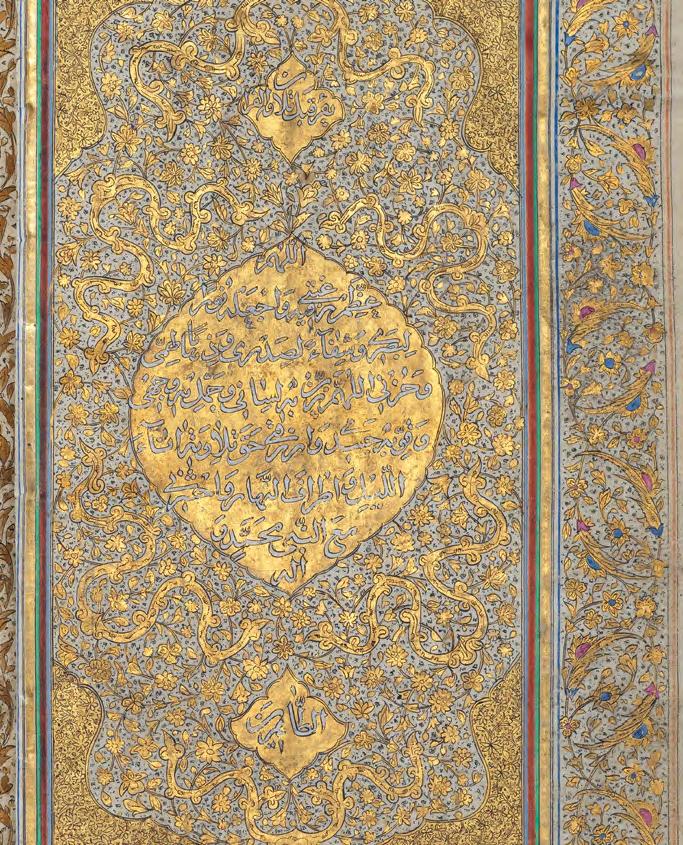

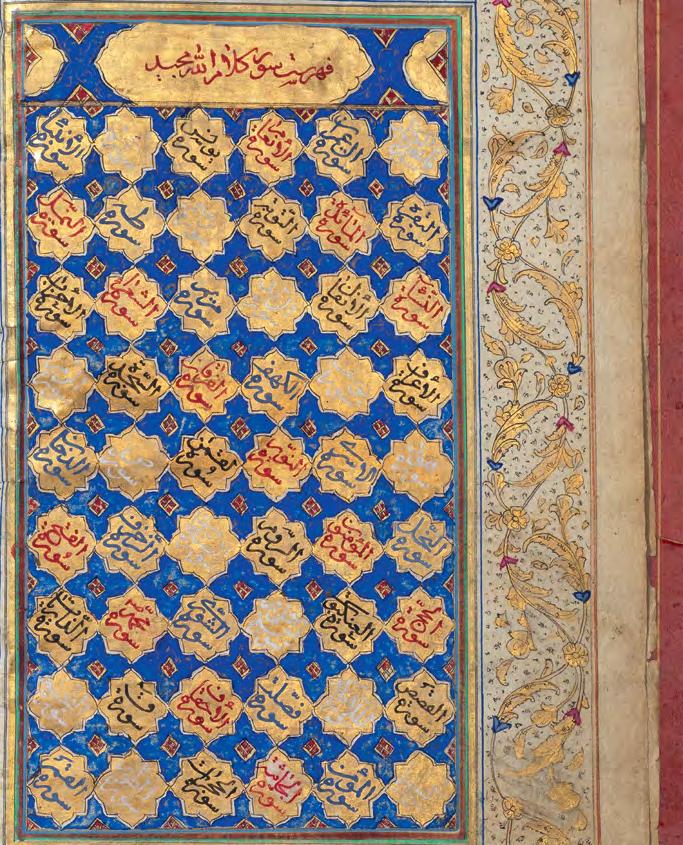
17 RARE QUR’AN FOLIO IN MAGHRIBI SCRIPT WITH GOLD SURAH HEADING
Southern Spain or Morocco
13th Century
Dimensions: 27.2 x 26.4 cm. Sepia, blue, red ink and gold on vellum.
Folio in square format vellum inscribed on both sides with seven lines, in maghribi script in sepia ink, diacritics and vocalization in red, blue and gold. The verses separated by gold and polychrome illuminated motifs in various rosettes, palms, and marginal illuminations marking the divisions of the text. The surah title inscribed in gold letters in kufic script with a marginal medallion illuminated with palmettes in the extension.
The Text:
The Qur’an, Surah al-Balad, verses: (end of) 19 and 20. Followed by Surah al-Shams verses: 1-3 and -on the reverse- Surah al-Shams verses: 3-10.
Translation:
“… In the name of God, the lord of mercy, the giver of mercy. By the sun in its morning brightness and by the moon as it follows it, by the day as it displays the sun’s glory, and by the night as it conceals it, by the sky and how He built it, and by the earth and how He spread

it, by the soul and how He formed it, and inspired it [to know] its own rebellion and piety. The one who purifies his soul succeeds.” The Qur’an, translated by M. A. S. Abdel Haleem, Oxford University Press, 2004, p. 423
The large curves of the free-flowing maghribi script bring lightness while retaining an aspect of solemnity from the formal, majestic kufic. Calligraphy in the western part of the Islamic world was not regulated by the same rules regulated in the east. The fourteenth century historian Ibn Khaldun informs us that calligraphers from the Maghrib were trained to write whole words rather than separate letters, as was the tradition in the east. They retained a freedom of interpretation while seeking an overall balance on the page through intrinsic awareness of proportion. For further discussion please see, From Cordoba to Samarqand – Masterpieces from the Museum of Islamic Art in Doha, Musée du Louvre Editions, 5 Continents, 2006, p. 162.
A folio from the same Qur’an is published in the exhibition catalogue, The Unity of Islamic Art, The King Faisal Foundation, Westerham Press, 1985, No. 11, p. 28.
Provenance
Ex-Private French Collection, Paris, formed between 1975-2000.
44

18
PORTRAIT OF PRINCE DANIYAL MIRZA AND ILLUMINATED CALLIGRAPHY MOUNTED ON A ROYAL MUGHAL ALBUM PAGE
Mughal India
Circa 1600
Page size: 30.8 x 20.4 cm.
Painting size: 13.7 x 8.3 cm.
Calligraphy size: 15.5 x 8 cm.
A portrait of Prince Daniyal (1572 - 1605) standing facing right, wearing a striped orange turban and transparent jama embroidered with gold zari, a talwar in his right hand and a katah tucked into his patka, a rondache on his left arm, sprigs of flowers in the background, drawing on paper with the use of colours and gold, Mughal or Deccan, c. 1600, mounted on a seventeenth century Mughal album page with cartouches of nasta’liq calligraphy and illumination in colours and gold, an erroneous inscription in nasta’liq script naming the subject as Abdullah Khan Uzbek at bottom, a quatrain of Persian poetry written in nasta’liq script with illumination in colours and gold signed by Muhammad Muhsin on reverse.
Prince Daniyal was the third son of the Mughal emperor Akbar (r. 1556-1605) and much favoured by his father, sharing a love of poetry which he wrote himself with many of his poems in Persian and Hindi. Daniyal was also an able general and was

made Viceroy of the Deccan in 1599, leading several Mughal campaigns having previously been appointed a governor to Allahabad in 1597. His early death from alcoholism at the age of thirty-two in 1605 was followed seven months later by the death of Akbar.
The Painting
The exact whereabouts of where this painting was executed is fascinating to ponder with Prince Daniyal’s campaigns in Allahabad and the Deccan. Jahangir, as Prince Salim and heir to Akbar’s throne, established a school of painting c. 1600 -1604 at Allahabad where his younger brother had been governor. From there we know that Prince Daniyal moved onto the Deccan. Mughal artists were certainly on the move at the turn of the seventeenth century and it is clear with the calligraphy by Muhammad Muhsin on this album page, Prince Daniyal was a keen and valued patron. Several portraits of him are known and as a son of Akbar and younger brother of the future Mughal emperor Jahangir, he would have been a popular subject for Mughal artists. One portrait with an inscription to the Mughal artist Manohar, c.16001605 is in the Kevorkian album in the Metropolitan Museum of Art, New York. A further portrait , again inscribed to Manohar, c.1600-1605 is in the Walters Art Gallery, Baltimore (W.668, fol.28). One example in the National Gallery of Canada (23557) depicts Prince Daniyal holding a bow and arrow during his time in the Deccan, c. 1603. Another is in the Bodleian Library , Oxford (Douce Or. a.1, folio 29a) and a third in the British Museum (1920,0917, O.13.34), signed by Muhammad al-Samarqandi. These latter three portraits all depict Prince Daniyal facing right and are mounted on royal album pages with borders in colours and gold.
Portraits were usually painted with the sitter facing in profile rather than directly towards the artist, giving a historical record to the subject’s presence at the Mughal court. Such fine portraits of Mughal royals and courtiers mounted in royal albums with fine specimens of calligraphy were of great significance and were frequent commissions during the seventeenth century, keeping the Mughal studios well occupied, giving vivid backdrops to the Mughal courts and the reigns of its monarchs. Generating a curiosity that lasts to this day.

The Calligraphy
It is clear from the quatrain written in fine nasta’liq script by Muhammad Muhsin that this fine album page was destined for a royal patron who might well have been Prince Daniyal.
The Persian Quatrain on the reverse reads:
دیوگ هک نخس هش رب نم زا
دیوگ هک نخس مسک هچ دوخ نم
دنتفگ هاش شیپ همه درد
دیوگ هک نم ز و متسیک نم
Translation of the Persian Quatrain: [Oh you!] the one who talks to the emperor about me...
Who I am, myself, am I someone about whom he shall speak?
And they mention my need in the presence of the emperor.
Who am I, am I someone about whom he shall speak?
The Ottoman historian Mustakimzade Suleyman Sadeddin Efendi recorded Muhammed Muhsin in his famous Tuhfe-i Hattatin (biographies of Muslim calligraphers). According to Mustakimzade, Muhammed Muhsin studied calligraphy under the supervision of the famous Shaybanid court calligrapher Mahmud b. Ishaq al-Shihabi (d. 1583) who worked for the Uzbek ruler Ubayd Khan in Bukhara, and after his death in 1539, for Shah Husayn Balkhi Shihabi. Please see, Tuhfe-i Hattatin, Istanbul, 1928, p. 724.
Muhammad Muhsin appears to have sought patronage under Prince Daniyal (1572-1605) and other members of the Mughal court in the early years of the 17th century, during which the present album folio was produced. The folio brings the portrait of Prince Daniyal and Muhammad Muhsin’s calligraphy together. The calligraphy is clearly addressed to a person who has been mentioning the calligrapher’s needs to the emperor (the word ‘shah’ is used twice).
The person whom Muhammad Muhsin addresses in his calligraphy is most likely Prince Daniyal who appears to have talked to his father, the Mughal emperor Akbar (r. 1556-1605) about the calligrapher and his poverty.
The calligraphy was probably presented to Prince Daniyal as a sign of the artist’s gratitude which made its way into a princely album from which this folio is coming from.
The last line of the quatrain, “Who am I, am I someone about whom he shall speak?”, is taken from the last chapter of the famous Timurid poet Abdurrahman Jami’s (d. 1492) Haft Avrang. Here, the use of this line from Jami’s poem is understandable since the Mughal ruling elite saw the Timurids as their ancestors and they greatly admired Timurid culture and literature.
Bibliography
M.C. Beach, The Grand Mogul Imperial Painting in India 1600-1660, Williamstown, Massachusetts, 1978, pp. 18, 19, 33, 76 and 135.
Toby Falk and Mildred Archer, Indian Miniatures in The India Office Library, London, 1981, no. 5. pp. 48 and 360.
S. C. Welch, A. Schimmel, M..L. Swietochowski and W. M. Thackston, The Emperors’ Album, New York, 1987, no. 18.
Linda York Leach, Mughal and Other Indian Paintings from the Chester Beatty Library, London, 1995, pp. 140, 152, 242, 292, 333 and 373.
E. Hannam, Eastern Encounters, Four Centuries of Paintings and Manuscripts from the Indian Subcontinent, London, Royal Collection Trust, 2018, no.15, (RCIN 1005018).
Acknowledgement
We would like to thank Margaret Erskine for writing this article on the present miniature painting.
Provenance
Private French Collection, Paris. Terence McInerney, New York, 1997.
48
Calligraphy on the reverse
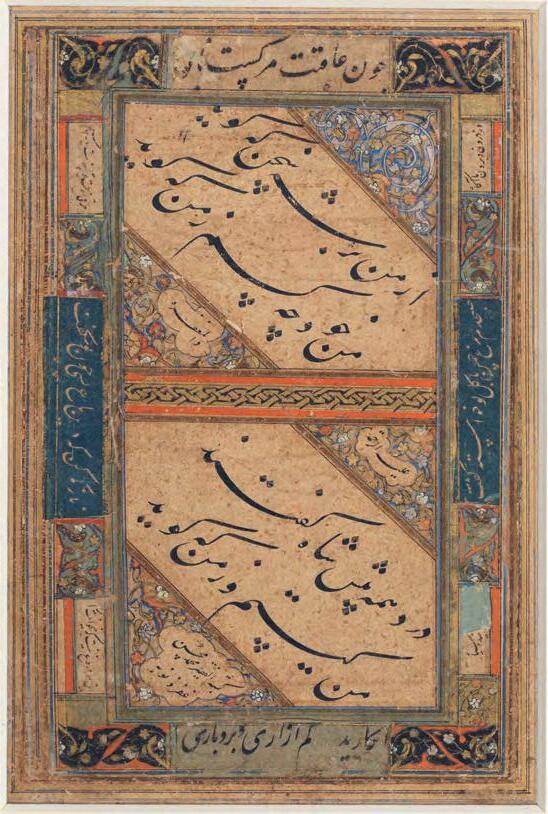
19
A MULLAH SEATED WITH MUGHAL PRINCESSES
Lucknow
Circa 1780
Dimensions: 40 x 28.8 cm.
Gouache on paper heightened with gold, blue border with white margin rules. A mullah seated in discussion with two Mughal princesses on a terrace. The mullah dressed in white writing in a text, both princesses adorned with pearls and jewels and wearing turbans decorated with jewels and an aigrette, their floral furtrimmed brocade jamas over long robes. Two female attendants kneeling in the foreground.
Patronage of the arts flourished at Lucknow under Nawab Asaf ud-Daula, the ruler of Lucknow between 1775 and 1797. Although as a ruler, Asaf ud -Daula had little real political power, owing to the tight grip of the British at this time, impressive monuments were built including a great mosque and lavish palaces during his reign in the last quarter of the eighteenth century. The thriving cosmopolitan community of Lucknow, where there was no jizya (an abolished poll-tax on non-Muslims), welcomed Europeans, native artists and calligraphers; particularly those from Delhi who sought studios away from the declining Mughal court. Terrace scenes in a traditional Mughal style, were particularly popular during the eighteenth century and this charming depiction of a Muslim mullah with his young disciples is such an example, illustrating well how painting thrived at Lucknow under Asaf ud-Daula.
Further reading
Toby Falk and Mildred Archer, Indian Miniatures in the India Office Library, London, 1981, pp. 135-188.
J. P. Losty and Malini Roy, Mughal India - Art, Culture and Empire, London, 2012, pp. 149- 201.
Acknowledgement
We would like to thank Margaret Erskine for writing this article on the present miniature painting.

50

20 A YOUNG PRINCE SEATED WITH A MYSTIC, AFTER GOVARDHAN
Mughal India
Second Half of the 17th Century
Painting: 21.2 cm x 15.6 cm.
Calligraphy on reverse:
16.4 cm. x 8.6 cm.
Album page: 52.4 x 37.3 cm.
A young prince seated with an elderly, bespectacled mullah, followers and musicians in a hut close to a lake, boatmen at work on the lake with a town in the background, the musicians playing a tambourine and a tambur, all of the group seated around the elderly mullah depicted with a long-flowing white beard, holding a scroll which bears the Arabic words “Birr-lillāh” (Benevolence belongs to God), two of the followers lounging in the foreground, drawing on paper with use of colours and gold, mounted on an 18th century Lucknow album page with gilt decorated floral borders and an inscription in black script, outer border with a bold floral decoration depicting poppies, six lines of nasta’liq calligraphy on reverse which is from the Preface of the Shah Muhammad Muzahhib Album (Dibāche-i Muraqqa‘-i Muhammad Muzahhib).
ARTIST
Govardhan was a major artist at the Mughal court with many of his works now in public and private collections across the globe including the seventeenth century Kevorkian album now in the Metropolitan Museum, New York. This miniature painting is clearly by a close follower of Govardhan with many of the painting’s attributes fitting well with his distinctive, noticeable style.
He served three generations of Mughal emperors and the Crown Prince Dara Shikoh, his career flourishing over many decades from 1595-1640. Having been born a khanazad, as one born in the Mughal palace, Govardhan trained at an early age towards the end of the sixteenth century in the studio of Akbar (r.15561605) before working at the Allahabad studio of Prince Salim, Akbar’s successor later to become the Mughal emperor Jahangir (r.1605-1626). His reputation was particularly well established during the reigns of Jahangir and Shah Jahan (r.1626-1666) earning him an important place as a Mughal master, leaving a legacy after his death for later artists to follow. This exquisite fine drawing on paper with the soft palette heightened with colours and gold with shadowing of the faces is a fine example typical of Govardhan’s style. The depiction of two devotees lounging in the foreground facing the mullah with their backs to the viewer is another particular feature. Govardhan’s ability to draw each figure in great detail and to capture the respect and regard given to religious figures is clearly shown in this particular painting, reflecting well his distinctive style and important position at the Mughal studio over three consecutive reigns of the Mughal empire. He was an able teacher to his followers. Totally captivating.

SUBJECT
A gathering of learned students including a young prince around an elderly teacher is a common theme in Indian miniature painting, clearly depicted in this Mughal work after Govardhan. The group gathered in a hut indicates the mullah’s holy status and the lakeside situation in a watery setting adds to the tranquillity of the scene.
The location may well be Dal Lake in Srinagar, Kashmir, an area occupied by Dara Shikoh during his prince hood. The two musicians depicted reflect the position of the young prince and the other figures with books, pens and scrolls, seated in earnest discussion add to the ambience of the subject.
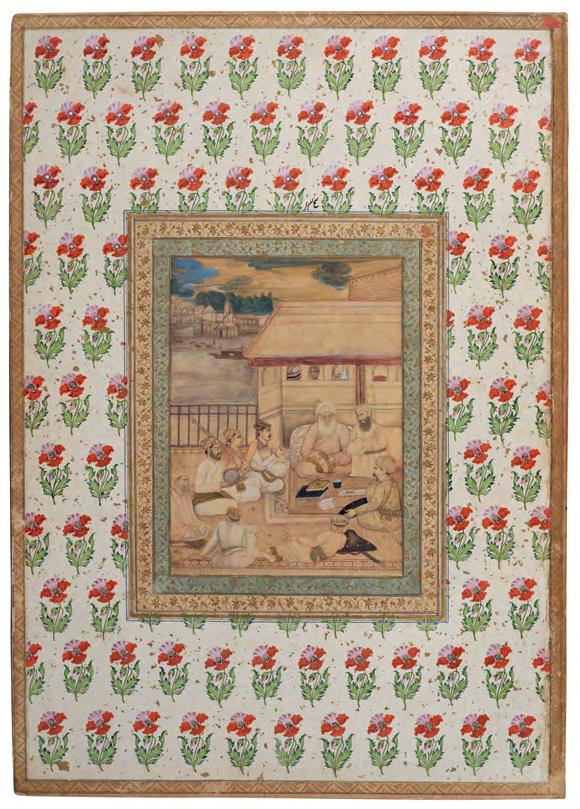
Crown Prince Dara Shikoh (1615-1659), the favourite son and heir of Shah Jahan, was an enlightened scholar interested in both the mysticism of Islam and Hinduism. His intellect cannot be underestimated and his untimely death at the hands of his ambitious brother Aurangzeb took the Mughal dynasty on a different course. From an early age Dara Shikoh had developed an interest in religion and philosophy. He later went onto study Sufism and with his sister Jahanara Begum became a disciple of the Qudi Sufi mystic Mulla Shah. He also took great interest in Hindu texts, producing a Persian translation of the Sanskrit Upanishads. Dara Shikoh was also an accomplished calligrapher and patron of the arts, giving great support to Mughal artists and their studios. The subject adds to the beauty and meaning of this painting, following well in the interest in mysticism in seventeenth century India.
BIBLIOGRAPHY
For further reading and comparisons:
R.H. Pinder-Wilson, A Persian Translation of the Mahabharata, British Museum Quarterly 20, no 3, London,1956.
E. Binney, The Mughal and Deccani Schools, Indian Miniature Paintings from the Collection of Edwin Binney 3rd, Portland, 1973, no 56.
T. Falk, Rothschild Collection of Mughal Miniatures, P&D Colnaghi & Co Ltd Exhibition Catalogue, London, 1976, no 103.
A.K. Das, Mughal Painting during Jahangir’s Time, Calcutta, 1978, pp. 75, 88,95, 125, 148, 158, 172, pl.29.
M.C. Beach, The Grand Mogul, Imperial Painting in India 1600-1660, Williamstown, Massachusetts, 1978, pp. 118-125, pls. 22, 41 and 62.
S.C. Welch, India! Art and Culture, New York, 1985, Nos 158-160.
S.C. Welch, A. Schimmel, M.L. Swietochowski and W.M. Thackston, The Emperors’ Album: Images of Mughal India, New York, 1987, no 76.
R. Crill and K. Jariwala, The Indian Portrait, London, 2010, no 21.
J.P. Losty and M. Roy, Mughal India Art, Culture and Empire, London, 2012, pp. 105, 124-128, figs. 57, 76 and 79.
M. Fraser, Selected Works from the Stuart Cary Welch Collection of Indian and Islamic Art, London, 2015, cat. 16, pp.66-67.
C. Glynn, Y. Rice and William W. Robinson, Rembrandt and the Inspiration of India, Los Angeles, 2018, pl. 6.
E. Hannam, Eastern Encounters, Four Centuries of Paintings and Manuscripts from The Indian Subcontinent, Royal Collection Trust, London, 2018, no.33.
A young prince with mystics, Aga Khan Museum, Toronto, AKM 498.
The Edith and Stuart Cary Welch Collection, Sotheby’s, London, 25 October, 2023, lot 20.
Acknowledgement
We would like to thank Margaret Erskine for writing this article on the present miniature painting.
Provenance
Ex-French Private Collection, Paris.

54

21 A PORTRAIT OF A YOUNG NOBLEMAN, POSSIBLY SAFI KHAN
Mughal India
Circa 1680
Painting: 16.5 cm. x 10.7 cm.
Including borders:
25.5 cm. x 19.6 cm.
A young nobleman standing facing left holding a rose sprig, wearing a striped, yellow jama and a yellow turban decorated with a jewelled sarpech, a sword and shield hanging from his floral patka, flowers including irises and grass at his feet, gouache on paper, mounted on an album page with gilt decorated borders, an inscription in English on reverse with a reference to the name Ibbetson.
This charming, delicate seventeenth century Mughal miniature painting of a young nobleman against a plain background with flowers at his feet is a fine example of Mughal painting executed during the reign of Aurangzeb (r. 1658-1707) with all the qualities of Mughal portrait painting established during the reign of Shah Jahan (r. 1627-1658). It bears many similarities to a likeness of Safi Khan, a mansahbdar working at the court of Aurangzeb.
For a comparable portrait of Safi Khan from the Johnson Album compiled by Richard Johnson (1753-1807) now in the British Library, formerly in the India Office Library, see, T. Falk and M. Archer, Indian Miniatures in the India Office Library, London, 1981, no. 123 (iv). Also see, Emily, Hannam, Eastern Encounters, Four Centuries of Paintings and Manuscripts from the Indian Subcontinent, The Royal Collection Trust, London, 2018, nos. 35 and 36.
Provenance
The Ibbetson Collection
The interesting inscription on the reverse of the painting connects the portrait to the Ibbetson family and possibly Sir Denzil Charles Jelf Ibbetson KCSI (18471909). The Ibbetson family moved to Australia where Sir Denzil spent part of his early life before arriving at Cambridge to take a second degree in mathematics at St John’s College. In 1870, he arrived with his bride Louisa Coulden in India, taking up a post in the Punjab. In his later career he served as Chief-Commissioner of the Central Provinces and Berar from 1898-1899. He was appointed LieutenantGovernor of the Punjab in 1907 and made a Knight Commander of the Order of the Star of India (KCSI) in the 1903 Durbars Honours List. During his time in India, he made a significant contribution to the understanding of the Indian census and caste system. He died in London, in 1909.
Acknowledgement
We would like to thank Margaret Erskine for writing this article on the present miniature painting.

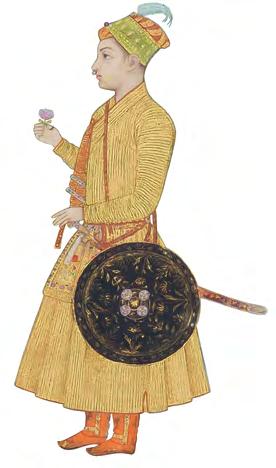
56 Inscription on the reverse
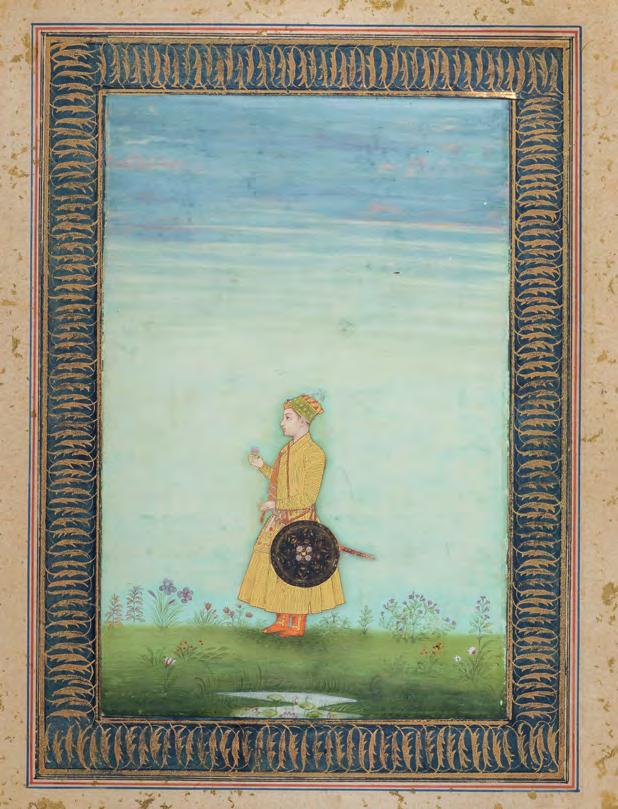
22
ALBUM FOLIO WITH A YOUTHFUL COURTIER WEARING A SAFAVID STYLE TURBAN AND A COMPOSITE LION
Deccan
Late 17th Century
Dimensions: 32 x 19 cm.
The square seal on the margin: Navvab Nasiri Sayyidi Dara Ali Bahadur
1231 A.H. (1815 C.E.)
A youthful courtier standing in a landscape, wearing a striped Safavid-style turban and a fur-trimmed floral coat over an orange jama, trees in the background, gouache on paper; verso an angel astride a composite lion made up of animals and birds led by a horned demon, drawing on paper, mounted on an album page with gilt-decorated borders and panels of nasta’liq calligraphy.
This Deccani miniature painting is an excellent example of the connections between the courts of the Deccan and Safavid Iran and the influence particularly on Deccani artists. Shah Abbas the Great of Iran moved his capital to Isfahan in 1598 establishing an important political and cultural centre frequently visited by the ambassadors of Europe and Asia, leading to a major dialogue in the seventeenth century between the continents, including at the end of the seventeenth century a brief period between Iran and Golconda in the Deccan. By turn Persian artists including Sheikh Abbasi and his sons Ali Naqi and Muhammad Taqi were influenced by Mughal and Deccani artists working in the Deccani studios. The Deccan was rich with mines of gems and cotton growing areas, enriching wealthy patrons who would have commissioned such a likeness as this youth wearing a turban taken from across the seas and lands of Safavid Iran.
Composite subjects are not uncommon in Indian miniature painting and jangling bells, horned-figures are frequently taken from Iranian inspired iconography. Demons (divs) often appear in Persian literature with composite figures as in Nizami’s Tale of the Turquoise Pavilion.
The angel riding the composite lion appears to be a pari, winged creatures renowned for their beauty. The word pari originates from Middle Persian, “parig”, and the root “par ”, which means wing. The iconography of ‘a pari riding a lion’ has a strikingly similar reflection in Western art: ‘a winged Dionysus riding a lion’. A famous example is a mosaic detail, from the House of the Faun in Pompeii. The pari holds a pomegranate, a symbol of fertility, abundance and prosperity in Persian, Turkish and Indian culture. Pomegranates are still broken in the new year as a sign of hope for prosperity.
Further Reading
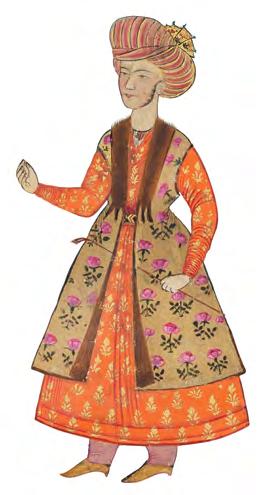
E. Sims, Five Seventeenth Century Persian Oil Paintings, P&D Colnaghi & Co Ltd Exhibition Catalogue, London, 1976, |pp. 223-232.
M. Zebrowski, Deccani Painting, London, 1983, p.195.
T. Falk and M. Archer, Indian Miniatures in the India Office Library, London, 1981, pl. 7, p. 76, no 68f.21v and p. 220, N. N. Haidar and M. Sardar, Sultans of Deccan India 1500-1700, New York, 2015, p. 23, p.291, pl. 168.
E. Hannam, Beyond the Page, London, 2023, Nos. 19 and 20.
Acknowledgement
We would like to thank Margaret Erskine for writing this article on the present miniature painting.
Provenance
Navvab Nasiri Sayyidi Dara Ali Bahadur 1231 A.H. (1815 C.E.) (His square seal is stamped on the margin).
Private UK Collection.
58

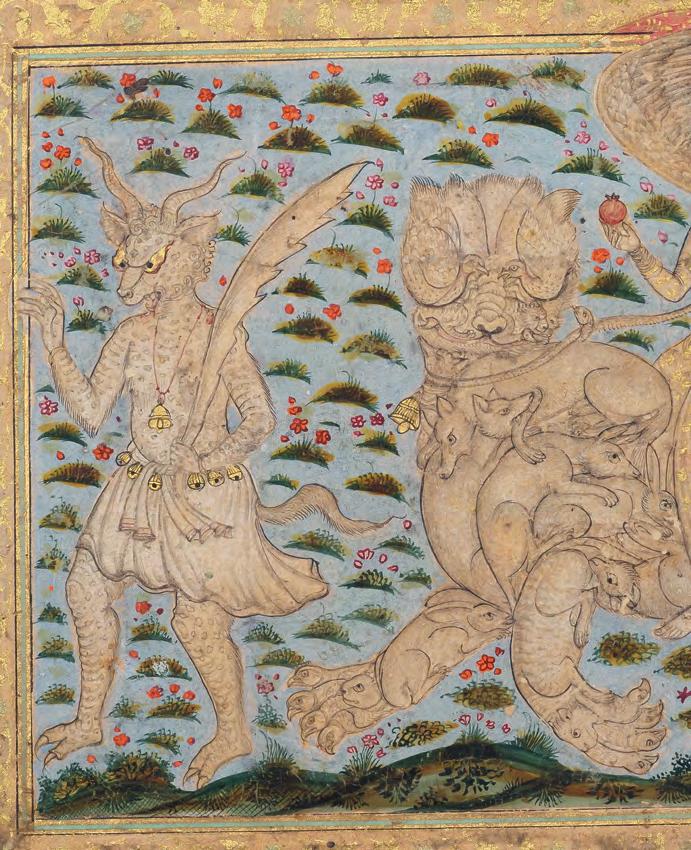

Shiraz, Persia
Second Half of the 16th Century
Dimensions: 26.2 x 17 cm.
Opaque pigments heightened with gold on paper.
AN EXTREMELY RARE EROTIC ILLUSTRATION OF A POEM BY SA‘DI SHIRAZI (D. 1292 CE)
Ink and opaque pigments heightened with gold, depicting lovers including a figure in a distinctive black hat, in various coupling positions in a brightly coloured and patterned tile interior, with two lines of Persian nasta’liq above and below within cloud bands on a gold ground, and diagonal line of the same above and below, outer border decorated in gold with animals on a floral ground.
Ostensibly, this single folio was part of a manuscript of the collected works (Kulliyāt) of the renowned Persian poet and mystic, Sa`dī of Shiraz (d. 1292 CE). The painting is partially framed by five couplets that belong to a short narrative poem (masnavī) that is found in the little-studied and unpublished collection of Sa`dīs obscene works (khabīsāt), which are featured prominently in the earliest manuscripts of the Kulliyāt (please see, D. Inge`Aesthetics of Desire in Medieval Persian Poetry).
The poem, which comprises seventy couplets, recounts the story of a handsome young man who marries an uncomely and ill-mannered woman. Upon experiencing an erotic fiasco during their first night together, the young man begs his father-in-law to allow him to divorce his wife. The father rejects this request by telling the young man that he would have to spend time in jail in order to pay back his daughter’s dowry. After thinking at length about his miserable condition, the young husband resorts to the uncanny
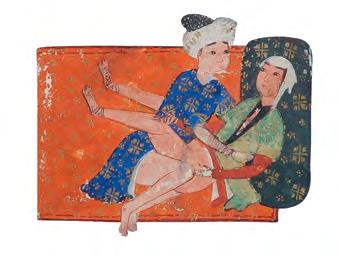
expedient of seducing and sexually subjugating his wife’s entire family and entourage, without discriminating between women and men of any age. Being the only family member who has not been assaulted by the young man, the father consents to the divorce of the couple with no further hesitation. The five couplets quoted in this folio pertain to the central part of the poem, which offers a detailed description of the orgiastic spree undertaken by the young man. As is often the case with Sa`dī’s obscene works, in these lines, explicit descriptions of sexual acts are juxtaposed with delicate similes and metaphors that are drawn from the poet’s inimitable lyric style.
Whereas the poem, line by line, offers a list of the young man’s sexual encounters with the members of his wife’s family in chronological order, the painting portrays all of them simultaneously. The young husband occupies a different timeframe in each section of the painting. While his physical features appear to be always the same, different erotic settings are distinguished by different garments.
At the centre of the painting, as a variation of the erotic scenes, the young husband appears to have a darker skin colour. Moreover, instead of having sex with a beardless male or female youth, the darker boy seems to be penetrating a bearded man. A man with similar facial features and hair appears on the top right of the painting. One could assume that this adult male is the visual depiction of the young man’s father-in-law who, in the versified plot, fears the sexual intentions of his daughter’s husband after having been made aware of the erotic tumult he has brought to his family.
Stylistic features of this painting suggest that it was produced in Shiraz between the 1560s and the 1570s CE. Visual representations of Sa`dī’s erotic verses (and, in general, of obscene poetry) are extremely rare before the 17th century. Nonetheless, a manuscript of Sa`dī’s Kulliyāt copied in Shiraz in 1566 (British Library, Add. 24944) presents a painting that is similar to the present one and illustrates exactly the same erotic poem.
A second related miniature from a Kulliyat-i Sa‘di, dated 939/1532 (Topkapi Palace Museum Library, R. 926, Fol. 22b), is published in Lale Uluc’s Turkman
62
23
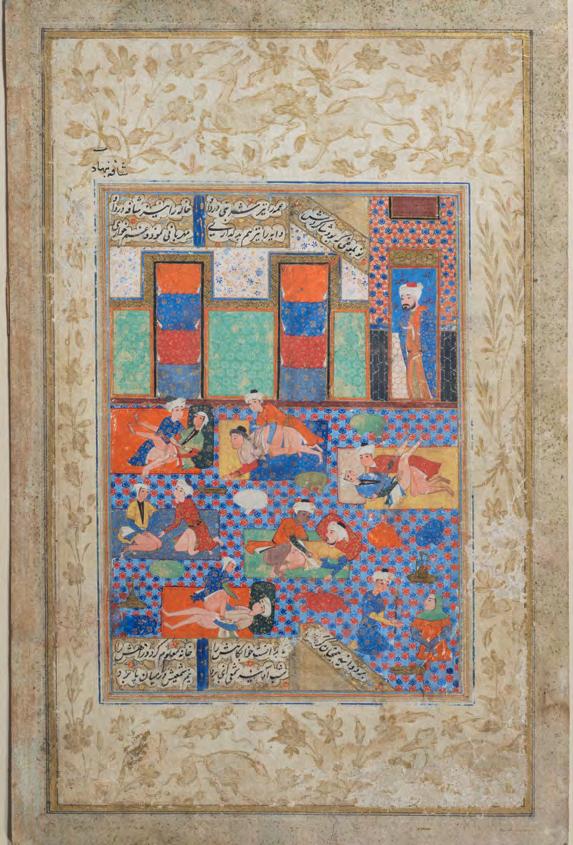
Governors, Shiraz Artisans and Ottoman Collectors: Sixteenth Century Shiraz Manuscripts, Turkiye Isbankasi Publications, Istanbul, 2006, p. 219.
Besides these two examples of the Kulliyat-i Sa‘di, there are very few other 16th century manuscripts of poetry with erotic representations. Among these, there is an interesting Khamsa (Quintet) of Ali Shir Nava’i, Herat, c.1492, in the British Royal Collection (RCIN 10050321), which contains a single miniature painting of an erotic bathhouse scene. The volumes of five poems written by Nava’i (Melody Maker), were composed c.1483-5 and this particular manuscript has exceptionally fine calligraphy and illumination by the Herati calligrapher Sultan Ali of Mashad (1453-1520).
The miniature painting executed in Bukhara, c. 1540-41 was later reworked by the Mughal master Govardhan , c.1605-1610. Originally intended to depict the Day of Judgement, this scene set in a hot bathhouse gives a sense of homoerotism in a tiled hammam, a traditional setting away from prying eyes. This particular Khamsa of Nava’i was highly prized by the Mughal emperors Jahangir and Shah Jahan. It was presented to George III , c. 1798, by Lord Teignmouth, Governor-General of India.
For further reading please see, E. Hannam, Eastern Encounters, Four Centuries of Paintings and Manuscripts from the Indian Subcontinent, Royal Collection Trust, London, 2018, Nos 21 and 22.

THE POETRY
The lines at the top:
داد رد یتبرش زین ار همع
داهنب یا هفاش زین ار هلاخ
یراد لدب نانچ مه ار هیاد
یراوخ مغ و دومن ینابرهم
The lines at the bottom:
ار شهاگباوخ تسنادب ات
ار شهار و درک مولعم هناخ
درب اجنآ یعمش هنیدآ بش
درب اپ نایم رد شیعمش مین
شدرگاش دوب هک یغولب ون
شدرک نانچمه دیناود رب
Translation:
“He gave the aunt a drink too, Made the aunt happy too. You are the same as the nanny, He showed her both kindness and sadness.
To know his own bed to sleep in, He found out the right house and his own way. At night, Adina took a candle there, Half of the candle melted away. A young man who was his student, Continued to run like him…”
Acknowledgement
This entry is partially based on the cataloguing of Domenico Ingenito (Associate Professor of Persian Literature, University of California, Los Angeles). We would like to thank Margaret Erskine for her contribution.
Provenance
Estate of costume designer Anthony Powell (1935-2021)
64

Probably Vienna
Reign of Sultan Mustafa IV, 1807-1808 (Sultan Mustafa IV is recorded as ‘regnant’.)
Oil on Canvas.
Reverse with owner’s name: ‘Amanda Sander’, dated 1842.
Dimensions: 99 x 68.5 cm.
GENEALOGICAL TREE OF THE OTTOMAN DYNASTY WITH TWENTY-NINE SULTAN PORTRAITS ATTRIBUTED TO ZENOP MANAS
Genealogical tree depicting the Ottoman sultans from the founder of the dynasty Osman Bey (r. 1299-1323) to Sultan Mustafa IV (r. 1807-1808). Each sultan depicted head and shoulders within an oval frame, each oval frame numbered, according to these numbers each sultan is identified at the bottom in French (giving each sultan’s age of demise); the portraits arranged in chronological order from top to bottom, with coloured banners against a plane tree. The portraits bear stylistic resemblances with those in the Young Album and court painter Levni’s Silsilename. Please see the exhibition catalogue, The Sultan’s Portrait: Picturing the House of Osman, catalogue of the exhibition held at the Topkapı Palace Museum between 6 June and 6 September 2000, by Serpil Bağcı, Filiz Çağman, Julian Raby, Jürg Meyer zur Capellen, Hans Georg Majer, Jürg Meyer zur Capellen, Gülru Necipoğlu, Banu Mahir, Gül İrepoğlu, Günsel Renda, Istanbul, Türkiye İş Bankası, Publishing no: 464, Art Series: 65, 2000, p. 516.

In this painting the plane tree has a symbolic meaning. According to legend, the founder of the Ottoman dynasty Osman Bey saw a plane tree in his dream which rotted in his chest and grew so large that its shadow covered continents. The dream was interpreted by learned men who said this was a sign and his state would become a world empire. The legend gave inspiration for the title of Caroline Finkel’s famous book, Osman’s Dream: The Story of the Ottoman Empire 1300-1923.
This painting belongs to a small group of Ottoman genealogical tree paintings. Among these, the first known to us -one of the earliest of this type- is from the period of Sultan Abdulhamid I (r. 1774-1789), and part of the Biby Castle - Celsing Collection, in Sweden. Please see, Günsel Renda, Padisah Portreleri – Mevlana Müzesi Albümü, T.C. Kultur Bakanligi, Konya, 1999, pl. 5, p. 17. Also see, Günsel Renda, “Osmanska Sultanträ Bilden av den Osmanska Dynastin”, Minnet av Konstantinopel – Den Osmansk Turkiska 1700 – talssamlingen på Biby, Atlantis, Stockholm, 2003, (pp. 165-178) p. 177.

The second is a genealogical tree in the Topkapi Palace Museum (inv. no. 17/133) produced during the reign of Sultan Selim III (r. 1789-1807). Please see, The Sultan’s Portrait: Picturing the House of Osman, Topkapı Palace Museum between 6 June and 6 September 2000, by Serpil Bağcı, Filiz Çağman, Julian Raby, Jürg Meyer zur Capellen, Hans Georg Majer, Jürg Meyer zur Capellen, Gülru Necipoğlu, Banu Mahir, Gül İrepoğlu, Günsel Renda, Istanbul, Türkiye İş Bankası, Publishing no: 464, Art Series: 65, 2000, p. 516.
The third is the present painting, produced under the reign of Sultan Mustafa IV (r. 1807-1808). It is the third earliest known to us, following the two paintings mentioned above.
66
24
Sultan Mehmed II the Conqueror

The fourth, presented by Sultan Mahmud II (r. 1808-1839) to King Louis XVIII’s Ambassador Duke Charles-François Riffardeau de Rivière, sold at Hotel des Ventes de Chatellerault, on 1 October 2017, was ‘préempté’ by the Louvre Museum.
The fifth, painted by Zenop Manas, under Sultan Mahmud II (r. 1808-1839), is in the Mekhitarist Monastery, Vienna. Please see, Garo Kürkman, Osmanli Imparatorlugunda Ermeni Ressamlar, Matusalem Uzmanlik ve Yayincilik, Istanbul, 2004, vol: II, p. 593.
The sixth, in the Topkapi Palace Museum (inv. no. 17/135), was produced under Sultan Abdülmecid (r. 1839-1861). Please see, The Sultan’s Portrait: Picturing the House of Osman, Topkapı Palace Museum between 6 June and 6 September 2000, by Serpil Bağcı, Filiz Çağman, Julian Raby, Jürg Meyer zur Capellen, Hans Georg Majer, Jürg Meyer zur Capellen, Gülru Necipoğlu, Banu Mahir, Gül İrepoğlu, Günsel Renda, Istanbul, Türkiye İş Bankası, Publishing no: 464, Art Series: 65, 2000, p. 518.
For further discussion please see, Serpil Bağcı, Filiz Çağman, Günsel Renda, Zeren Tanındı, Osmanlı Resim Sanatı, T.C. Kültür ve Turizm Bakanlığı Yayınları, Istanbul, 2006, p. 283. Also see, Günsel Renda, "Osmanlı Sultanlarının Soyağacı", P Sanat Kültür, Antika Dergisi, II, 1996, pp. 8-92.
The technical and compositional features of the present painting bear striking similarities with the fifth painting mentioned above, in Vienna, painted by Zenop Manas under Sultan Mahmud II (r. 1808-1839). In addition, their resemblance of style and brushwork makes the present painting attributable to Zenop Manas. Manas produced our painting just before the Vienna painting, within the short reign of Sultan Mustafa IV (r. 1807-1808). The only difference between the two paintings is that the inscriptions in the Vienna painting are in Ottoman Turkish and those in the present painting are in French. This is understandable, given the fact that Zenop Manas was fluent in both languages since he was working as the first interpreter and secretary at the Ottoman embassy in Vienna. See, Garo Kürkman, Osmanli Imparatorluğunda Ermeni Ressamlar, Matusalem Uzmanlik ve Yayincilik, Istanbul, 2004, vol: II, p. 593.
Provenance
Collection of Amanda Sander in 1842 (Name and date inscribed on the reverse).
Private Greek Collection
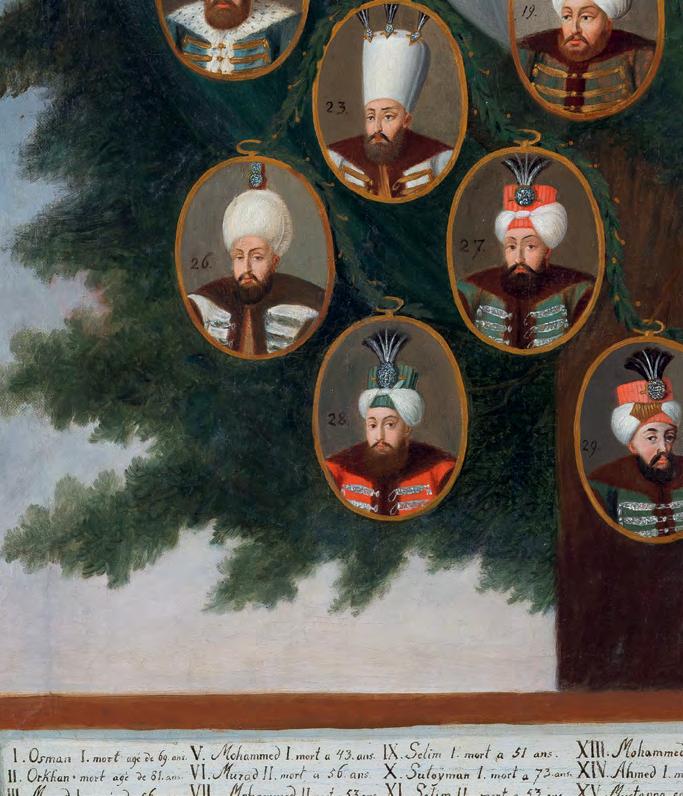

 Zenop Manas, the painter
Zenop Manas, the painter


 Genealogical tree of the Ottoman dynasty painted by Zenop Manas, under Sultan Mahmud II (r. 1808- 1839), the Mekhitarist Monastery, Vienna. After Garo Kürkman, Osmanliİmparatorluğunda Ermeni Ressamlar, İstanbul, 2004, vol:II, p. 593.
Genealogical tree of the Ottoman dynasty painted by Zenop Manas, under Sultan Mahmud II (r. 1808- 1839), the Mekhitarist Monastery, Vienna. After Garo Kürkman, Osmanliİmparatorluğunda Ermeni Ressamlar, İstanbul, 2004, vol:II, p. 593.
Italy
Consisting of 12 leaves of plates in total, each 29 x 45 cm.
All plates signed R. Morghen del. et inc. (Drawn [delineavit] and engraved [incidebat] by Raffaello Morghen.)
All plates hand-coloured.
Dated: 1778
MUSLIM PILGRIMAGE (HAJJ) IN EUROPEAN PERCEPTION
THE JOURNEY OF THE GREAT LORD TO MECCA BY RAFFAELLO MORGHEN (1761-1833)
The Title
Celebre Mascherata Fatta Nella Splendidissima Citta di Napoli in Campagna Felice nel Carnavale dell’ anno 1778 Rapresentante nella Verita Della Sua Maestosa
Comparsa Il Viaggio del Gran Signore alla Mecca Opera Ripartita in Undici Divisioni ed Esemplarizzata in Dodici Rami.
(Famous Masquerade Made in the Splendid City of Naples in the Happy Countryside in the Carnival of the Year 1778 Representing the Truth of His Majestic Appearance the Journey of the Great Lord to Mecca Work Divided into Eleven Divisions and Exemplified in Twelve Labels).
The present panoramic hand-coloured engravings are a rare expression of European perception on the Muslim pilgrimage (Hajj). It documents Europe’s fascination with the splendour of the Muslim pilgrimage to the holy city of Mecca. Some compositional features -such as the quadriga -in part VIII- bear similarities with Italian Renaissance ‘procession series’ such as The Triumphs of Caesar painted by Mantegna. The use of such classical Greek and Roman elements in the representation of a Muslim pilgrimage is art-historically very interesting.
The depictions of the banner of Prophet Muhammad -in part IV-, the camel carrying the cover of the tomb of Prophet Muhammad -in part VI- and the Sultan on horseback -in part VII- are the highlights of the procession.
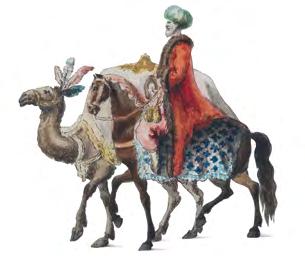
A set of The Journey of the Great Lord to Mecca is in the Yale University Library. Please see the following link, https://collections.library.yale.edu/ catalog/2018995
The individuals participating the procession are identified and each scene is explained as follows:
Part I Prima Divisione, Contiene il Cominciamento della Mascherata, cioe la Banda di sefsantuno strumenti da fiato, composta di Oboe, clarnetti, trombe, fagotti, piattini, e tamburi. A cui feguoni il Capo de giannizzeri, a cui seguono ottantaquattro soldati.
(First Division, beginning of the Masquerade, Band of sixty-one wind instruments, composed of oboe, clarnets, trumpets, bassoons, cymbals, and drums. Leader of the Janissaries, followed by eighty-four soldiers.)
Part IISeconda Divisione. Continua la Comparsa l’Aga de Giannizzeri, ed in seguito la banda a cavallo, composta di otto trombe, e fra di questi un timpano. (Second Division. Here it represents the Aga of the Janissaries, and the rest of the band on horseback, composed of eight trumpets, and between these a timpani.)
Part III Terza Divisione. Segua il capo degli Spahi ed appresso una parte di questi soldati. (Third Division. In which the sipahi are represented at the head and soldiers on horseback).
Part IV Quarta Divisione. Succede il resto degli spahi il porta insegna collo stendardo di Maometto, il Bassa di tre code, ed il Gran Visir. (Forth Division. The rest of the sipahis succeed the standard-bearer with the banner of Muhammad, the three-feathered pasha and the grand-vizier.)
Part V Quinta Divisione. Continua l’accompagnamento il Bassa di Egitto, il Bassa di Qaramania, e dietro a questi dodici schiavi con i vasi dei profumi in mezzo a quali quattro schiavi che portano il gran vaso de presenti. (Fifth Division. The accompaniment continues the pasha of Egypt, the pasha of Qaramania, and behind these, twelve slaves with the vases of perfumes in the midst of which four slaves carry the large vase of presents.)
Part VI Sesta Divisione. Viene il Mufti, ed indi il Camelo, che porta la coltre della tomba di Maometto, le di cui punte son portate del capo degli Indiani dall’iman della moschea, dal prete della legge, e dall Emir Bacha, a quali succede il capitan delle guardie ed il capo de chiaus, ossia il maestro di ceramonie.
(Sixth Division. The Mufti comes, and then the camel, who carries the cover of the tomb of Mohammed, the tips of which are carried by the head of the Indians (black eunuchs) and by the imam of the mosque, by the priest of the law, and by the Emir Bacha, who succeeds the captain of the guards and the cavush, i.e. the master of ceremonies.)
70 25
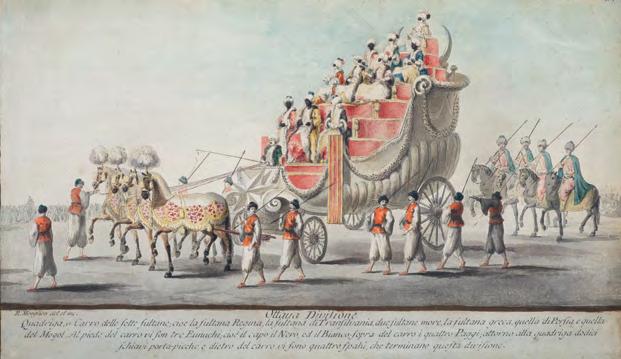

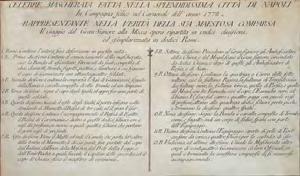



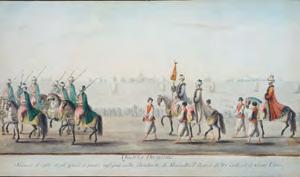

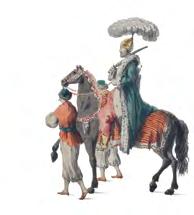
72
Part I
Part II
Part IV
Part V
Part III
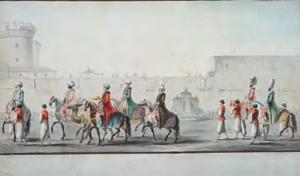
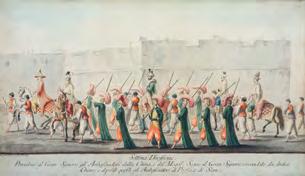
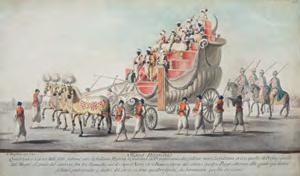
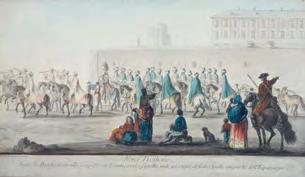

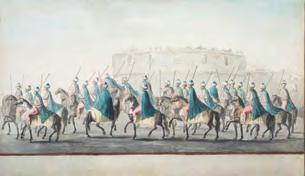
 Part VI
Part VII
Part VIII
Part X
Part XI
Part IX
Part VI
Part VII
Part VIII
Part X
Part XI
Part IX
Part VII Settima Divisione. Precedono al Gran Signore gli ambasciadori della China, e del Mogol. Segue il Gran Signore circondato da dodici chiaus, e dopo di questi gli Ambasciadori di Persia, e di Siam.
(Seventh Division. The ambassadors of China and the Mogul precede the Great Lord (the Sultan). The Great Lord follows surrounded by twelve cavush, and after these the ambassadors of Persia and Siam.)
Part VIIIOttoua Divisione. Continua la Quadriga, o carro delle sette sultane, cioe la sultana Regina, la sultana di Transilvania, due sultane more, la sultana Greca, quella di Persia e quella del Mogol; con tre eunuchi, cioe il capo, l’Eunucho Nero, ed il Bianco, Vi sono sul carro i quattro paggi con piccolo vasi di profumi attorno alla quadriga dodici schiavi portapicche, e terminano quattro spahi.
(Eighth Division. Quadriga, or chariot of the seven sultanas, that is, the Queen sultana, the sultana of Transylvania, two Moorish sultanas, the Greek sultana, that of Persia and that of the Mogul. At the foot of the chariot there are three eunuchs, that is, the chief, the black, and the white, on top of the chariot are the four pages, around the quadriga twelve pike-bearing slaves, and behind the chariot there are four sipahis, who complete this division.)
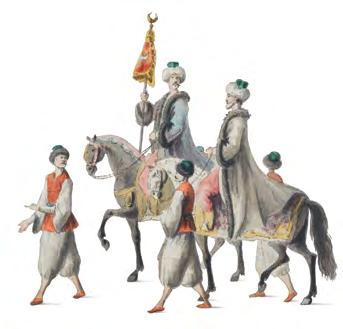
Part IX Nona Divisione. Segue la banda a cavallo composta di trombe, corni e fagotto, indi un corpo di sedici spahi con parte dell’Equipaggio.
(Ninth Division. Followed by the mounted band composed of trumpets, horns and bassoon, followed by a body of sixteen sipahis with part of the crew.)
Part X Decima Divisione. Continua l’equipaggio coperto di pelle di tigre con some da corico e quattro schiavi per la custodia di esso.
(Tenth Division. The crew continues, covered in tiger skin, with a bed load and four slaves to look after it.)
Part XI Undecima ed ultima divisione. Chiude la mascherata altro corpo di ventiquattro giannizzeri co loro offiziali co quali e terminata la maestosa comparsa di si numeroso accompagnamento.
(Eleventh and final division. Closing the masquerade is another body of twenty-four janissaries with their officers with whom the majestic appearance of such a numerous accompaniment ended.)
RAFFAELLO MORGHEN (1761-1833)
He was born in Naples to a German family of engravers. He received his earliest instructions from his father, himself an engraver; but, to obtain more advanced training, he was placed as a pupil under the celebrated Giovanni Volpato. He assisted this master in engraving the famous pictures of Raphael in the Vatican City, and the print which represents the miracle of Bolsena is inscribed with his name. He married Volpato's daughter, Domenica, in 1782, and being invited to Florence to engrave the masterpieces in the Uffizi Galleries, he moved there with his wife in the same year. His reputation now became so great as to induce the artists of Florence to recommend him to the Grand Duke as a fit person to engrave the Last Supper of Leonardo da Vinci. Morghen's fame soon extended over Europe; and the Institute of France, as a mark of their admiration of his talents, elected him an associate in 1803. In 1812 Napoleon invited him to Paris and paid him the most flattering attentions.
A list of the artist's works, published at Florence in 1810, comprised two hundred compositions; the number was afterwards considerably increased. A series of eight prints by Morghen after Louis Ducros was published between 1784 and 1786. The most notable include his engravings of: Raphael's Transfiguration, a Mary Magdalene by Murillo, a Head of the Saviour by Leonardo, Guido Reni's Aurora, Poussin's A Dance to the Music of Time and The Flight into Egypt Domenichino's Archery Contest of Diana and her Nymphs, Van Dyck's Portrait of Francesco de Moncada and anonymous portraits of Dante, Petrarch, Leonardo, Ariosto, Tasso and other famous men; Antonio Canova's Theseus and the Minotaur and the same sculptor's monument to Pope Clement XIII. Giovanni Folo of Bassano and Giovacchino Cantini are among Morghen’s famous pupils. Morghen died in Florence, in 1833, and was buried in the Church of Santa Croce.
74
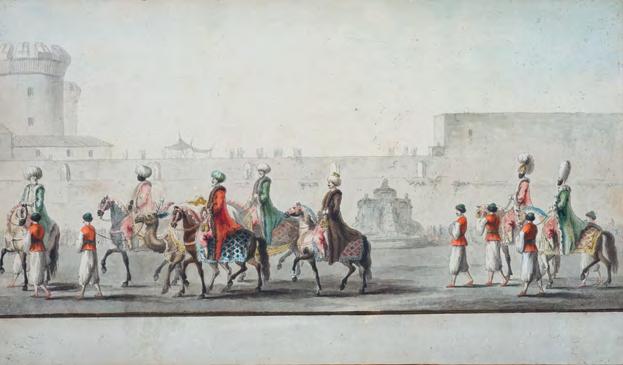
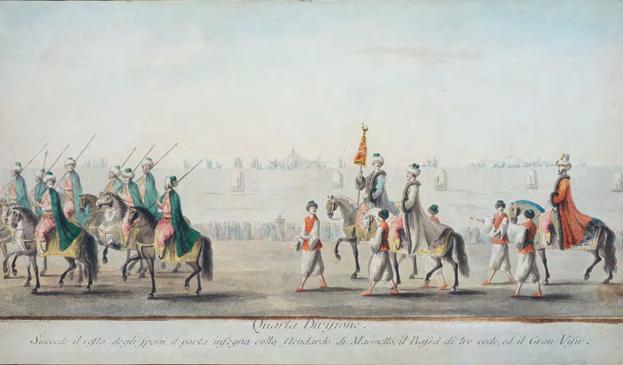 The camel carrying the cover of the tomb of Phophet Muhammad
The standard-bearer carrying the banner of Prophet Muhammad
The camel carrying the cover of the tomb of Phophet Muhammad
The standard-bearer carrying the banner of Prophet Muhammad
Venice or the Middle East
Circa 1600
Heigth: 14.3 cm.
Diameter: 28.3 cm.
FINE VENETO-SARACENIC BRASS BUCKET
The body is decorated overall with an intricate arabesque design. The handle in the form of serpent’s heads on either side holding the central section in their mouths.
Scholarly debate over the group of metalwork known as “Veneto-Saracenic” wares has seen them being attributed to both Venice and the Middle East. A number Veneto-Saracenic works are signed by the artist Mahmud al-Kurdi (Mahmud the Kurd) adding intrigue to the question.
Mahmud al-Kurdi presents a particularly interesting and enigmatic figure in this debate, his signature appearing both in Arabic (or Persian) and transliterated Roman script. Although a small number of signed works are securely attributed to the master himself, there remain many more works which could possibly be ascribed to him.
The bucket in hand belongs to a group of rare, Veneto-saracenic metalwork which are very finely executed, manifesting plural influences and speaks of the extensive trade network between Renaissance Europe and the Islamic worlds during the 16th century.

For further discussion on Veneto-saracenic pieces please see; S. Auld, Renaissance Venice, Islam and Mahmud the Kurd: A metalworking enigma, London, 2004.
For a charger with similar decoration in the Bargello Museum in Florence please see Marco Spallanzani’s Metalli Islamici a Firenze nel Rinascimento, Florence, 2010, p. 160, no. 45.
Provenance
Michael Dunn, New York.
The Longridge Collection (acquired from the above). Christie’s ‘Syd Levethan: The Longridge Collection’

26

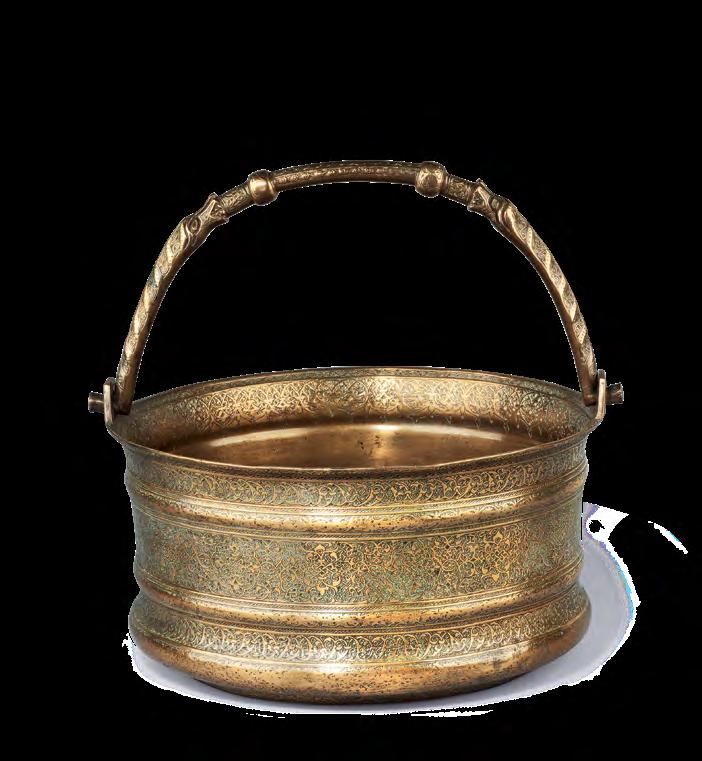
27
RARE AND IMPORTANT OTTOMAN TOMBAK WATER FLASK
Ottoman Empire
Height: 27cm. 16th-17th Century
Of deep baluster shape, raising in two small, curved shoulders with suspension loops and terminating in a narrow facetted cylindrical neck, with short, curved spout on one side, resting on a short, splayed foot ring, decorated with large engraved palmette medallions with stippled ground, filled and surrounded with scrolling floral patterns.
This water flask was designed to mirror the shape of traditional leather flasks carried in the Ottoman Empire whilst travelling or during military campaigns. This piece’s engravings, consisting of a stippled ground decorating palmette cartouches and dotted outlines used to form arabesques, were most likely intended to imitate stitchings on grained leather. The form was even repeated in ceramic, as attested by Iznik pottery water flasks.
Tombak, the technique whereby a gilt and mercury amalgam is applied to copper, and burnt off, leaving gold fused to the substrate, was very much prized in Ottoman times. According to teachings [hadith] of Prophet Muhammad, the use of gold in daily objects represented extravagance and wastefulness. For this reason tombak (gilt copper) was regarded as a legitimate alternative to gold in elite circles.

While it originated on the plains of Central Asia as the water flask of horsemen, the present water flask suggests the prestige and sophistication this object achieved under the Ottomans. This is a refined example of a type of vessel that was used by the Ottoman ruling elite during the 16th century. Its form is similar to that of the water flasks produced for court circles in the reign of Sultan Süleyman the Magnificent (r.1520-1566). Supreme among all Ottoman water flasks is the gold vessel which survives in Topkapi Saray Treasury (inv. no. 2/3825, please see Esin Atil, The Age of Suleyman the Magnificent, 1987, p.123). Overlaid with flowers and set with fabulous jewels, this was a royal commission made for Sultan Suleyman. The flask held the Sultan’s drinking water and was carried in court processions. Following this, comes a flask of gilded and appliquéd leather, presented around 1590 by Sultan Murad III (r.15741595) to the Holy Roman Emperor Rudolf II (r.15761612), now in the Kunsthistorisches Museum, Vienna (inv. no. C.28).
The present water flask’s incising technique and floral motifs compare with some of the highest quality Ottoman metalwork of the sixteenth century, when metalwork attained remarkable opulence and

78
Gold flask made for Suleyman the Magnificent (r. 1520-1566). After the exhibition catalogue
TheAgeofSüleymantheMagnificent, National Gallery of Art, Texts by Esin Atıl, Washington, 1987, p. 123, fig. 54.
Gilded and Appliquéd Leather Flask presented by Sultan Murad III (r. 1574-1595) to the Holy Roman Emperor Rudolf II (r. 1576-1612). After the exhibition catalogue TheAgeofSüleymanthe Magnificent, National Gallery of Art, Texts by Esin Atıl, Washington, 1987, p. 165, fig. 105.

refinement. One of these comparable pieces is a 16th century Ottoman tombak lidded jug in the Düsseldorf Kunst Museum (inv. no. 16160). Please see, Nazan Ölçer, “Türkische Metallkunst”, Türkische Kunst und Kultur aus Osmanischer Ziet, vol. II, Verlag Aurel Bongers Recklinghausen, 1985, p. 290.
The decoration of the present piece is closely related to that of Iznik ceramics produced in the second half of the 16th century. The branches with spring blossoms, for example, are repeated on the lunettes of the mihrab wall, in the Takkeci Ibrahim Aga Mosque, Istanbul, built in 1591/1592. Please see, Arlı, Belgin Demirsar et al. Tiles – Treasures of Anatolian Soil – Ottoman Period, Kale Group Publications, Istanbul, 2008, pp. 263-264, Figs. 299, 301.
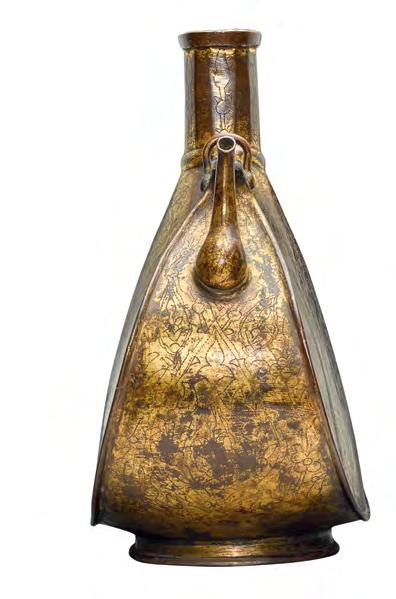
There are two similar Ottoman tombak water flasks in museum collections which are closely related to the present piece. The first is in the British Museum (inv. no. 1897,0320.1), published in Julian Raby & James Allan, “Le Métal”, L’art Décoratif Ottoman - Tulipes, Arabesques et Turbans, ed. Yanni Petsopoulos, Denoël, 1982, p. 35, dated to the 16th century. Please see the link, https://www.britishmuseum.org/ collection/object/W_1897-0320-1
The second one is in the Metropolitan Museum of Art (inv. no. 1984.100) - published in S. C. Welch, The Islamic World, New York, 1987, p.125 - is dated to the 17th century. Please see the link, https://www. metmuseum.org/art/collection/search/453238 Flasks of this form were presented as diplomatic gifts. A leather flask in similar form, dated to the first half of the 17th century and embellished with silver, gold and precious stones, travelled to Russia, where it was presented to Tsar Alexei Mikhailovich by Tsarevich Seid-Burkhan Arsalanovich in 1653 (inv. no. TK-2882, see Levykin, A., The Tsars and the East: Gifts from Turkey and Iran in the Moscow Kremlin, Washington, D.C., 2009, pp. 66-7). These imperial gifts indicate the significance of these water flasks in the eyes of the Ottoman elite. A further example is in the National Museum in Warsaw (inv. no. SKAZsz 2270, please see, the cover of the exhibition catalogue War & Peace: Ottoman-Polish Relations in the 15th19th centuries, Istanbul, 1999). And lastly, two more recorded examples are in the Furusiyya Foundation Collection (inv. nos. R-731 and R-733, please see, Bashir Mohamed, The Arts of the Muslim Knight: The Furusiya Art Foundation Collection, 2007, pp. 280-1).
80
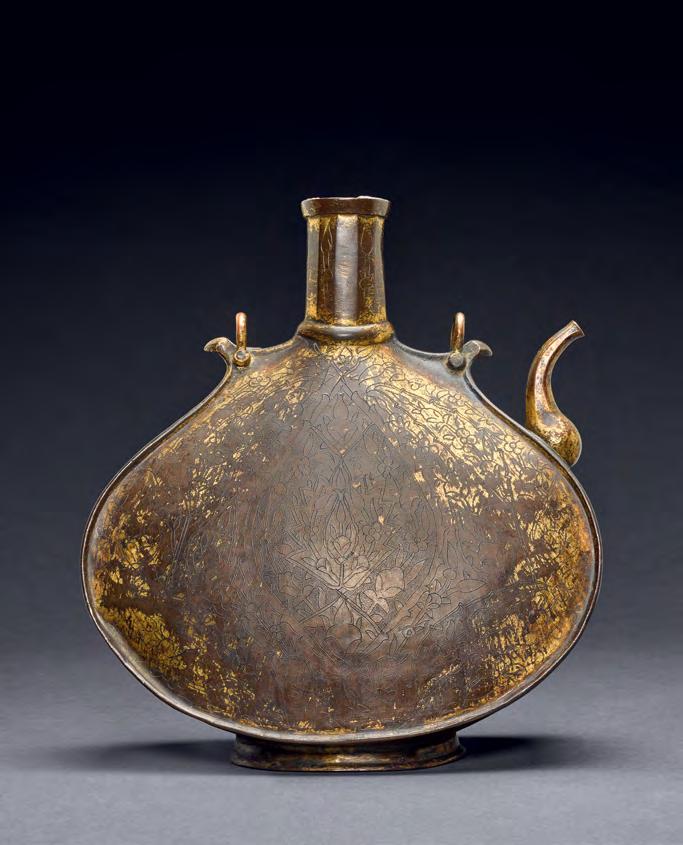
28
SAFAVID TINNED COPPER FOOTED BOWL DECORATED WITH INTERTWINED ISLIMI MOTIFS AND PALMETTES
Persia
Second Half of the 17th Century
Diameter: 30 cm.
Height: 13,5 cm.
Copper cast and turned footed bowl, engraved and filled with black composition over tinned surface. Decorated with inscriptions in nas-ta‘liq script, intertwined islimis and palmettes.
INSCRIPTIONS
The roundel at the end of the calligraphic band encloses a Persian inscription stating the name of the patron who ordered the bowl: Bandah-e Shāh-e Vilāyat Ni‘mat
The Servant of the King of Vilayat (Caliph Ali) Ni‘mat
A plausible patron’s name, who might have ordered this bowl, that springs to the mind is that of the famous Safavid scholar Al-Sayyid Ni‘mat Allah al-Jaza’iri (16401701).
The patron’s name is similarly recorded in some fine examples of 17th century Safavid metalwork. For example, the patron’s name ‘Muhammad Saleh’ is recorded on a closely related Safavid tinned copper wine bowl in the Victoria & Albert Museum (Inv. no. 788-1901). Please see, Assadullah Souren Melikian-Chirvani, Islamic Metalwork
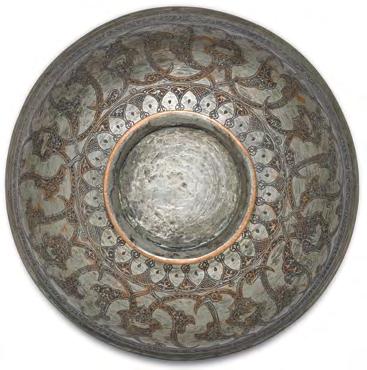
from the Iranian World – 8-18th Centuries - Victoria and Albert Museum Catalogue, London, 1982, p. 335.
Arabic Prayers
The inscriptions in the upper band, in nas-ta‘liq script, read the following prayer in Arabic:
لوتبلا و ىلع ىضترملا و دمحم یفطصملا یلع یلص مهللا
ىلع دابعلا نیز ىلع لص و نیسحلا و نسحلا نیطبسلا و ةمطاف
ىلع اضرلا و ىسوم مظاكلا و رفعج قداصلا و دمحم رقابلا و
لص و نسحلا ىركسعلا ىكزلاو ىلع ىقنلا و دمحم ىقتلا و بحاص ىدهملا دمحم ماما حلاصلا فلخ مئادلا مئاقلا ةجحلا ىلع نامزلا و رصعلا
“Oh God! May Thy blessings descend upon al-Mustafa Muhammad, al-Murtada ‘Ali, the Virgin Fatima, the grand-sons al-Hasan and al-Husayn! May Thy blessings descend upon Zayn al-‘Ibad ‘Ali, al-Baqir Muhammad, al-Sadiq Ja‘far, al-Kazim Musa, al-Rida ‘Ali, al-Taqi Muhammad, al-Naqi ‘Ali, al-Zaki al-‘Askari al-Hasan! May Thy blessings descend upon the Eternal Guide, Imam Muhammad Mahdi, the Lord of time.”
A comparable Safavid tinned copper bowl, sharing the same form and dimensions with the present piece, decorated with a similar Arabic prayer in nas-ta‘liq script, dated 1017 A.H. / 1608 C.E., is in the Victoria and Albert Museum (Museum No. M.50-1956), London. Please see, Assadullah Souren Melikian-Chirvani, Islamic Metalwork from the Iranian World – 8-18th Centuries - Victoria and Albert Museum Catalogue, p. 328, Cat. No. 149. A second comparable piece is the above-mentioned wine bowl in the Victoria and Albert Museum (Museum No. 788-1901), London, which is also decorated with intertwined islimis and palmettes. Please see, ibid, p. 335, Cat. No. 154.
82

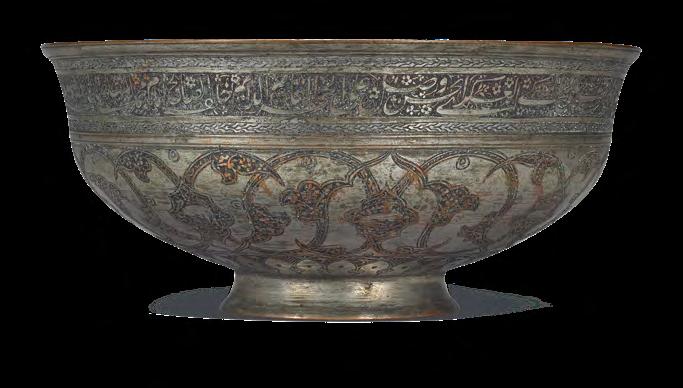
Ottoman Empire
Signed: ‘Amal-i Vani Hacik (Work of Hacik from the city of Van)
Dated: 1311 AH / 1893 C.E.
Length: 54 cm.
OTTOMAN SILVER DAGGER MADE BY ARMENIAN MASTER SILVERSMITH HACIK OF VAN
IMPRESSIVE OTTOMAN SILVER DAGGER DECORATED WITH NIELLO INSCRIPTIONS, THE TUGHRA OF SULTAN ABDULHAMID
II (R.
1876-1909), THE SHEER O
KHORSHID (LION AND SUN) IMPERIAL EMBLEM OF PERSIA AND VIEWS OF FIVE MOSQUES IN ISTANBUL
Silver hilt and scabbard -richly decorated with niello- with double edged steel blade.
The front of the scabbard is decorated with the tughra (imperial insignia) of Sultan Abdulhamid II (1786-1909) at the top, and depictions of five famous Ottoman mosques in Istanbul, each in a roundel: (from top to bottom) the Yildiz Mosque, the Sultan Ahmed Mosque, the Ayasofya Mosque, the Bayezid Mosque, the Yeni Mosque.
The depictions of the five mosques are surrounded by an Arabic poem from the diwan (collected poems) of Caliph Ali (Ali b. Abi Talib, d. 661), a cousin of Prophet Muhammad and the fourth righteous caliph.
The poem reads:
يل الله مسق امب تیضر
يقلاخ ىلإ يرمأ تضوفو
ىضم امیف الله نسحأ امك
يقب امیف نسحی كلذك
Translation:
“I was satisfied with what God had given to me as my share.
I delegated my command to my creator. Just as God did good in the past, It also improves for the rest.”
On the reverse, at the top, under the name ‘Najaf’, the date reads 1311 A.H. / 1893 C.E. In the top roundel there is the Qur’anic verse (Surat al-Fath 1) “Indeed, we have granted you a clear triumph (Oh Prophet)”. This is followed by a second roundel with another Qur’anic verse (Surat al-Saff 13)
“The help from God and imminent victory”. In the third roundel there is an Arabic prayer which reads “Oh [God, you are

the one] whose benevolence is disguised, save us from what we fear”. In the fourth roundel there is the sheer o khorshid (the lion and the sun), the imperial emblem of Persia. The fifth and last roundel at the bottom includes the artist’s signature: Amal-i Vani Hacik (Work of Hacik from the city of Van). These roundels are surrounded by the following couplet which consists of one line in Persian and one line in Turkish.
Cang o sulh bimahal nayad be-kar jay-i gul gul bash.
Olur merhem-i cerahat sinana ilac, olmaz veli zahm-i lisana.
(If war and peace have no place, the rosegarden (of prosperity) shall be surrounded by roses.
Applying ointment may cure an arrow’s wound, but it will be useless to try to cure a wound in one’s heart inflicted by harsh words).
The name ‘Ibrahim Pashu’ is incised in the roundel with the depiction of the Yildiz Mosque.
On the hilt there is a talismanic formula beginning with a star and ending with the letter waw (v). This is a well-known protective, prophylactic formula which is also found on talismanic shirts. The same formula can be seen on Morali Hasan Pasha’s (Ottoman sultan Mehmed IV’s daughter Princess Hatice’s husband) talismanic shirt in the Topkapi Palace Museum (Inv. No. Padisah Elbiseleri, 13/1170), Istanbul. Please see, Hulya Tezcan, Topkapi Sarayi Müzesi Koleksiyonundan Tilsimli Gömlekler, Timas, Istanbul, 2011, Cat. 10, p. 75.
84
29



30
Egypt
Second Half of the 13th Century
Height: 18,5 cm.
EARLY MAMLUK SILVER-INLAID BRASS CANDLESTICK
Inscriptions on the shoulder and neck: مئادلا زع [al-‘izz al-daim…] (perpetual glory…).
The base of truncated conical form, the projecting shoulder leading to a concave drip-tray, the narrow tapering cylindrical neck ending with a conical socket, the body decorated with a figural frieze of musicians and three roundels with horse riders and a figure riding an elephant, the drip-tray and neck with bands of calligraphy.
This candlestick belongs to an important group of early Mamluk cast brass examples produced in Cairo within the first century of Mamluk rule. One of their distinctive features is a domical openwork bracket inside the base, also visible on our candlestick. Please see, Toby Falk, Treasures of Islam, London, 1985, p. 277, no. 286.
In a discussion of these candlesticks, Dr. Rachel Ward establishes their provenance based on the inscription of an example in the Cairo Museum of Islamic Art (inv. no.1657), [published in the 1981 exhibition catalogue Renaissance of Islam: Art of the Mamluks, (Texts by Esin Atil) Washington, pp. 57-58] dated in 1269 AD, attributing it to a Cairene workshop. The present candlestick is closely related to a piece in the Nuhad Es-Said Collection (please see, James Allan, Islamic Metalwork: the Nuhad Es-Said Collection, 1982, pp. 80-83, no. 13), which was also ascribed to a Cairene workshop circa 1270. This makes these objects some of the earliest known pieces of Mamluk metalwork from Cairo.
Their design inherited from the figural tradition of earlier thirteenth century Ayyubid metalworks. Similar roundels with a cheetah sitting behind a mounted rider can be found on the Nuhad Es-Said candlestick, and on a thirteenth-century example from Syria (please see, E. Baer, Metalwork in Medieval Islamic Art, New York, 1983, p. 233), while a roundel showing three figures riding an elephant is on a basin in the Victoria & Albert Museum, dated 1250-1350 (inv. no. 2734-1856). Its catalogue entry states that figural scenes on Mamluk metalwork were common until 1300, after which they were replaced by benedictory inscriptions.
86
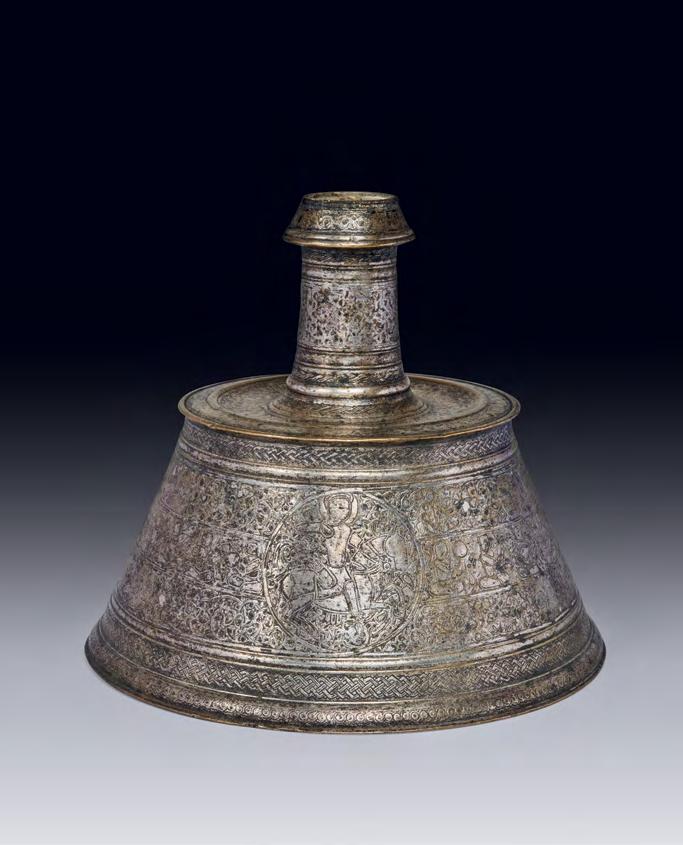
The tradition of depicting people and animals has always been alive in regions where the Muslim faith spread. The tradition of depicting people and animals has deep roots in Seljuk, Ayyubid and early Mamluk art. Especially in Seljuk art cosmological and mythological human and animal figures come to the fore. But in general, figures were not just used for a decorative purpose but also to convey religious, cultural and political messages. The most frequent themes are a ruler seated on a throne as a symbol of sovereignty; battle scenes, scenes of palace life showing activities such as shooting with a bow and arrow on horseback, hunting with hawks, playing polo, figures of musicians, dancers, servants offering wine in a cup which represent palace entertainments. For further information please see, Motif from the Sadberk Hanım Museum Collection (written by Turgut Saner, Şebnem Eryavuz and Hülya Bilgi), Sadberk Hanım Museum, Istanbul, 2020, pp. 146-147.
This candlestick’s decoration is also characteristic of a style attributed to the ‘Mosul School’. In the Cairo Museum of Islamic Art, the aforementioned candlestick (inv. no.1657) and another comparable piece with a band of musicians, dated 1269-70 (Please see, Jonathan Bloom & Sheila Blair, The Art and Architecture of Islam 1250-1800, London, 1995, pp. 97-98, no. 126) both bear an 'Al-Mawsilī' (from Mosul) nisba. Based on the conjecture attaching all Mawsili artists to the same Cairene studio, these candlesticks thus provide a rare opportunity to study the stylistic and technical development of a single workshop between about 1269 and 1330, while documenting the transitional period of early Mamluk metalwork. For other published examples, see the appendix in Dr. Rachel Ward’s article “Tradition and Innovation: Candlesticks made in Mamluk Cairo” in Islamic Art in the Ashmolean Museum, Oxford Studies in Islamic Art, vol: 10, Part II, edited by J. W. Allan, 1995, pp. 147-158.
Provenance
Ex-Private French Collection
88
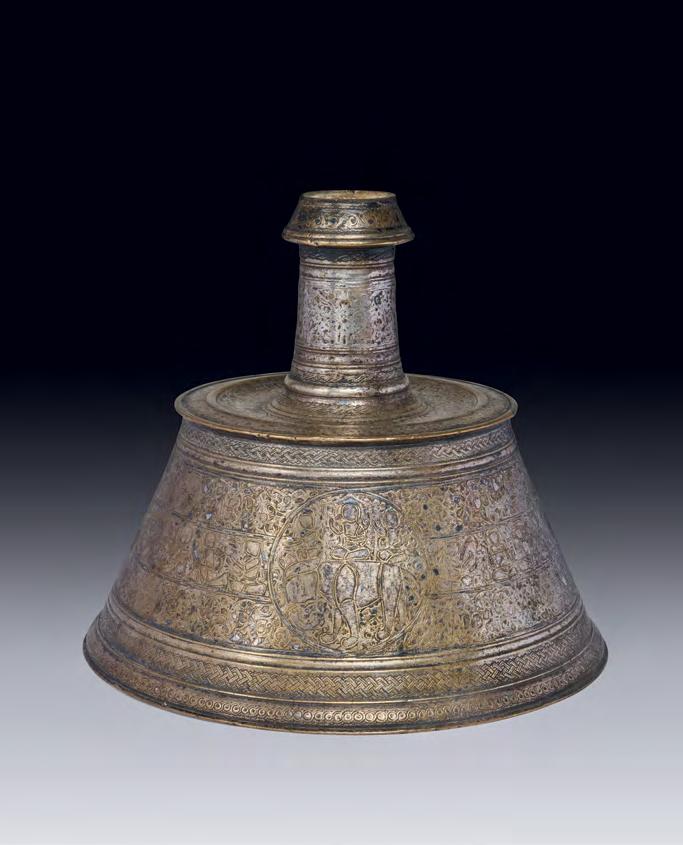
Geneva
Circa 1830-1840
Length: 8.5 cm.
Gross weight: 190 gr.
SWISS ENAMELLED GOLD SNUFF BOX DECORATED WITH
VIEWS OF CONSTANTINOPLE
Of polylobed oval form with enamelled decoration on a translucent red background and on an opalescent pink background of bouquets of flowers, music trophies and military trophies on the hinged lid.
On the top of the lid is a view of the Kasim Pasha shipyard (Kasım Paşa Tersanesi) in the Golden Horn, the sides depicting scenes from the Bosphorus, alternating with bouquets of flowers.
The inside of the lid applied to the view of the Mihrimah Sultan Mosque in Üsküdar and enamelled on a pink opalescent background framed by a translucent red enamelled band between two opaque white borders, the gold lining subsequently struck with English hallmarks, in a green leather box.
At the bottom is a view of the Sepetciler Kasri (Basketmakers’ Mansion) with the trees of the Gülhane Park in the background.
The three views of Constantinople chosen to decorate the present snuff box all appear to have symbolic meanings. The Kasim Pasha shipyard symbolizes the modernization of the Ottoman imperial navy. The Mihrimah Sultan Mosque in Üsküdar, on the other hand, represents the glory of the empire’s classical age. Lastly, the Basket-makers’ Mansion is one of the iconic buildings of the Bosphorus; the first major sea-side mansion seen by the ships entering the city’s harbour from the Marmara Sea.
There are three comparable enamelled gold snuff boxes (SHM 18391-Z.642, SHM 15104-Z.576, SHM 15106-Z.578), with similar form and decoration, in the Sadberk Hanim Museum, Istanbul. Please see the exhibition catalogue, Cevher Sadberk Hanim Müzesi Koleksiyonundan Mineli ve Murassa Eserler / Enamelled and Jewelled Objects from the Sadberk Hanim Museum Collection, (Authored by Hülya Bilgi, Idil Zanbak), Sadberk Hanim Museum, Istanbul, 2015, pp. 224-229.
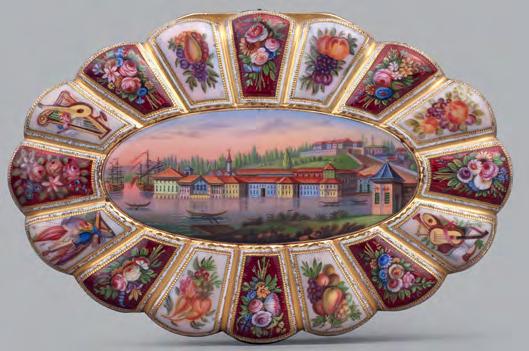
31 90
Cover of the Box



The Base
32
EXQUISITE OTTOMAN SANCAK QUR’AN BOX SET WITH JEWELS
Ottoman Empire
17th Century
Dimensions:
9.5 cm x 8 cm x 4.1 cm
The silver gilt body engraved with foliate tendrils (rumis). The jade lid set with four emeralds, four pink sapphires, surrounded by plaques set with thirteen emeralds and thirteen rubies. The ‘lion and sun’ in the centre is set with diamonds, rubies and emeralds. The sides decorated with scrolling tendrils, and set with eighteen emeralds and twenty-three rubies. Velvetset interior, underside engraved and punched with interlacing scrolling tendrils. Thirty-five emeralds, thirtysix rubies, four pink sapphires in total.
The ‘lion and sun’ emblem set with rose cut diamonds in the centre of the jade lid is the royal symbol of the Persian Empire, ‘sheer o khorsheed’ in Persian. The lion, in front of the sun, holds a sword. This symbol may indicate that the box was sent from the Ottoman Empire to Persia as a diplomatic gift.

The base is decorated with an intricate design of masterfully executed rumi scrolls. The settings of the sapphires, emeralds and rubies are particularly Ottoman in style. Jewelstudded courtly objects including Qur’an covers, Chinese porcelain and other courtly objects comparable to the present box circulated among the Ottoman elite as gifts.
Sancak means banner in Turkish. Sancak Qur’ans were very small manuscripts (usually with a diameter of 4 cm.) which were intended to be carried on the finial of a banner, hence called a ‘sancak Qur’an’. The present box belongs to a small group of bejewelled, ornate boxes produced for protecting sancak Qur’ans. For a further discussion on a similar Ottoman jewel-studded
case for a miniature Qur’an please see, Sheila Blair, Islamic Calligraphy, Edinburgh University Press, 2006, pp. 482-3.
For Ottoman courtly art works similarly decorated with set-jewels from the Topkapi Palace Museum see, Emine Bilirgen et al, Topkapi Palace: The Imperial Treasury, Istanbul, 2001, pp. 40-44 and 51. An octagonal jewel-set Qur’an box in the Topkapi Palace treasury bears the inscription “Mushaf-i Sherif” (the Nobel Book [Qur’an]). See, J.M. Rogers, Topkapi: The Treasury, London 1987, nos: 78, 80. For a comparable jewel-set sancak Qur’an box in the Topkapi Palace Museum see, Emine Bilirgen et al, Topkapi Palace: The Imperial Treasury, Istanbul, 2001, pp. 112-3.
Provenance
Ex-Virginia House Museum Collection
Ex-Collection of Ambassador and Mrs. Alexander Weddell, Richmond, Virginia, U.S.A.

92
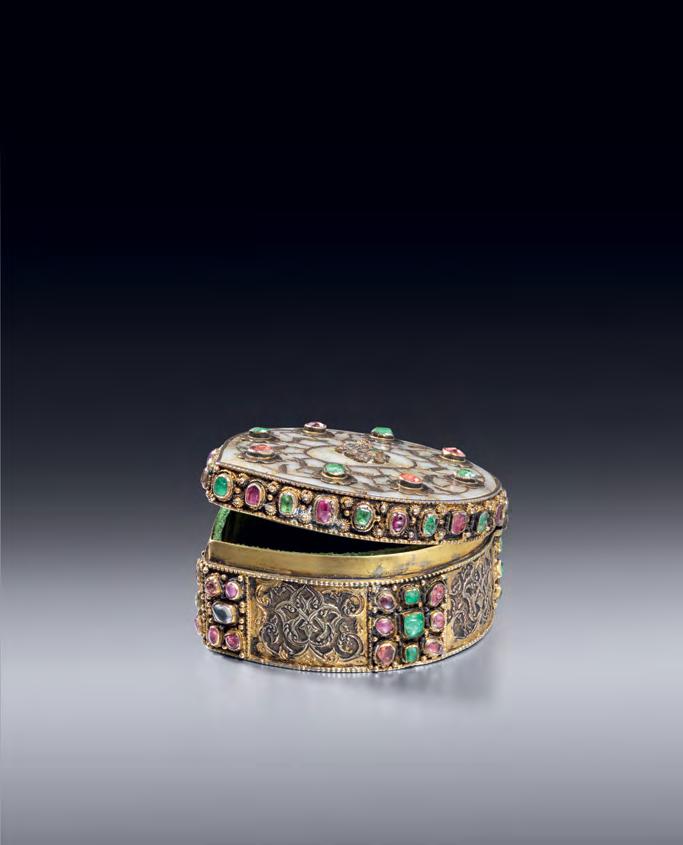
Ottoman Empire
Circa 1600
Height: 21 cm.
RARE EARLY OTTOMAN TOMBAK INCENSE-BURNER
Gilt-copper, with hemispherical body and pedestal foot, curved handle and hinged, domed lid decorated with stylised palmettes and arabesques in open work technique, surmounted by a round finial.
Incense-burners were used at ceremonial events and religious gatherings. Incense was believed to purify the air and have protective powers against the evil eye.
Tombak, the technique whereby a gilt and mercury amalgam is applied to copper, and burnt off, leaving gold fused to the substrate, was prized in Ottoman times.
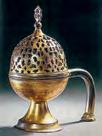
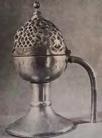
According to teachings [hadith] of Prophet Muhammad the use of gold in daily objects represented extravagance and wastefulness. For this reason tombak was regarded as a legitimate alternative to gold.
One of the key aspects of Ottoman metalwork is its sculptural form. Prime examples are monumental, often plain tombak candlesticks, originally placed either side of the mihrab in imperial mosques of the 16th and 17th century, please see J. M. Roger’s Empire of the Sultans: Ottoman art from the collection of Nasser D. Khalili, 1995, no. 7, pp. 38-39.
The present incense-burner follows this sculptural aesthetic. The handle acts as a supporting foot, and facilitates the incense-burner to be carried around during ceremonies and the incense to be spread around the room.
The form of the incense-burner stretches back to late antiquity, early Islamic period. For an example of one of these in the David Collection, Copenhagen, and a discussion of the origin of the form, please see Joachim Meyer’s Sensual Delights: Incense Burners and Rosewater Sprinklers from the World of Islam, The David Collection, Copenhagen, 2015, fig. 6, and pp. 28-29.
Only a handful of this type of incense-burner are known. Foremost is an example from the collection of the late Dr Zia Sofu (1918-1994), a descendent of Ali Pasha of Ioannina (d.1822), renowned collector and connoisseur of Ottoman silver and tombak, published in Tulips, Arabesques and Turbans – Decorative Arts from the Ottoman Empire, London, (ed. Yanni Petsopoulos),1982, pl. 50, (Fig. 1), and a second example also sold at Sotheby’s Arts of the Islamic World, 8 October 2008, lot 265, (Fig. 2).
Another tombak incense-burner in the Topkapi Palace Museum (inv. no. 16/1564), has a poem about incense engraved on the lid which reads “misk u anber dimağa gider” implying the beneficial effect of musk and ambergris on the mind, please see The Anatolian Civilisations: Seljuk/Ottoman, exhibition catalogue Topkapi Palace Museum, Istanbul, 1983, p. 258, E. 261 (Fig. 3).
A silver incense burner of almost identical form, dated in the Museum of Turkish and Islamic Arts (inv. no. 16) in Istanbul which bears the name “Sultan Mehmed Khan” (Mehmed III) in thuluth script indicating that it was owned by the sultan, confirmed by the fact that it was found in Mehmed III’s mausoleum please see The Anatolian Civilisations: Seljuk/Ottoman, exhibition catalogue Topkapi Palace Museum, Istanbul, 1983, p. 258, E. 260.
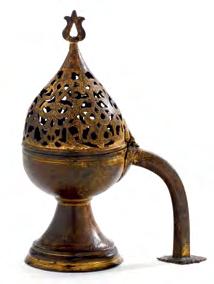
Furthermore a tombak ewer and basin in the Topkapi Palace Museum in Istanbul, with openwork arabesque medallions on the sides, virtually identical to the present piece, is inscribed with the name of the Valide Sultan, the mother of Sultan Mehmed IV (r. 1648-1687), please see Tulay Gungen et al, Tombak, Golden Grace, Yapi Kredi Publications, Istanbul, 2018, p. 67.
Provenance
Private UK Collection
33 94
Fig. 1: Tulips, Arabesques and Turbans – Decorative Arts from the Ottoman Empire, London, (ed. Yanni Petsopoulos), 1982, pl. 50
Fig. 2: Sotheby’s Arts of the Islamic World, 8 October, 2008, lot 92
Fig. 3: Topkapi Palace Museum (inv. no. E. 261), After The Anatolian Civilisations: Seljuk/ Ottoman, Istanbul, 1983, p. 258
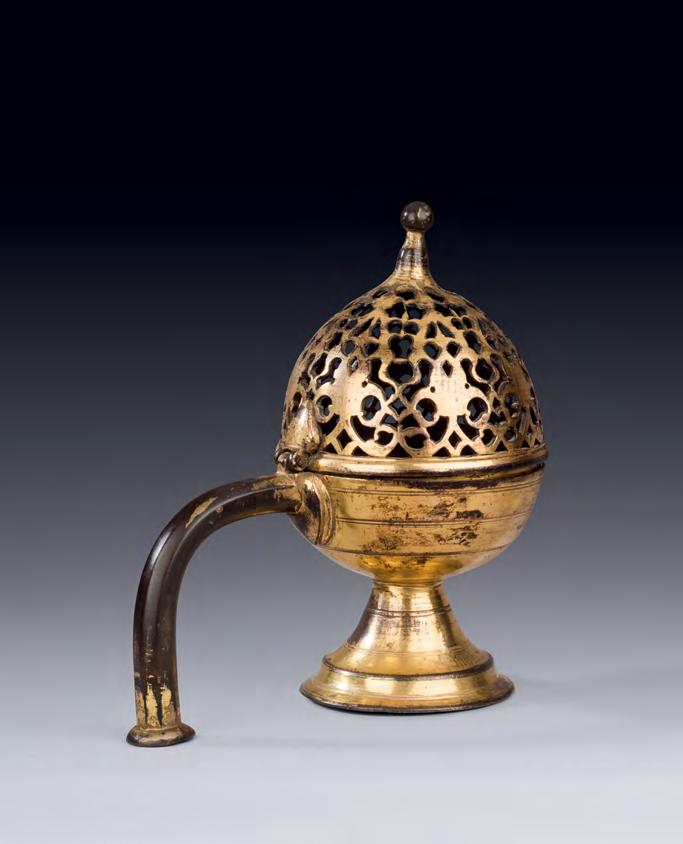
34 EXTREMELY FINE OTTOMAN VOIDED SILK VELVET PANEL WITH GOLD & SILVER THREAD
Ottoman Empire
Bursa
Circa 1650
Dimensions: 158 x 130 cm.
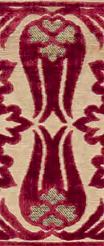
Cut crimson velvet on a silk warp-faced cream ground with six stacked vertical rows of eight-lobed blossoms emanating further foliate details, with gold and silverthread highlights in central flowerheads; the border with en-suite motifs and confronting tulips. This design stands out for its geometric symmetry and the almost abstract quality of the spring flowers and tulips. The vertical and horizontal symmetry in this design is based on the use of a repeated unit.
The large confronting tulips in the border are replaced with smaller confronting tulips in the centre of the composition. This creates an illusion and gives the centre a feeling of depth.
Tulip has a symbolic meaning in Ottoman art. The letters of the word tulip (Lâle [ هللا]) in Turkish are the same letters used for writing the word Allah [ هللا] (God). These two words have the same numerological value in the abjad system (a decimal alphabetic numeral system in which the twenty-eight letters of the Arabic alphabet are assigned numerical values). Tulip is one of the leading decorative elements in Ottoman art, frequently used together with roses, hyacinths, saz leaves, for decorating ceramics, textiles, metalwork, woodwork and manuscript. Tulip is also used in imagery in Ottoman poetry. In many poems tulip leaves are likened to the cheeks of the beloved. The word lāleh-khad (lâle-had), means ‘tulip-cheeked’.
An identical velvet cover is in the Los Angeles County Museum of Art (inv. no. M.73.5.686). It is illustrated in Nurhan Atasoy et al, J. Raby, A. Effeny (eds.), Ipek, The Crescent and the Rose, Imperial Ottoman Silks and Velvets, Azimuth Editions, London, 2001, p. 318, fig. 349, where it is described as a design of "stacked eightlobed medallions", woven in Bursa during this period (ibid p. 319).
In terms of its design the present panel is also related to a second example in the Musée des Arts Decoratifs (inv. no. 8356), Paris, see, Nurhan Atasoy et al, J. Raby, A. Effeny (eds.), Ipek, The Crescent and the Rose, Imperial Ottoman Silks and Velvets, Azimuth Editions, London, 2001, pp. 318-9, fig. 352.
Imperial velvet panels such as the present one were highly favoured by the Ottoman elite. These were produced in workshops in Istanbul and Bursa,
working for imperial commissions. They were used as ceremonial covers as well as wall hangings during celebrations and festive gatherings.
This velvet panel is an excellent example of imperial Ottoman textile production in the first half of the 17th century. It is particularly rare to find a velvet panel of this kind in such remarkably good condition.
Provenance:
Ex-Collection of William R. (1915-2007) and Elinor (1920-2020) Appleby, London and New York. The present Ottoman velvet came from the Applebys’ Upper East Side home.
Raised in New York, Elinor Appleby attended Julia Richmond High School and graduated from Barnard College. She married William Meyer and later William Appleby. Vivacious to the end, Elly loved bridge, travel, art, opera, golf. Elinor Appleby died on 9 January 2020 in New York. William Appleby lead a distinguished life and is remembered for his elegant style – never without a bowtie- and gentle nature. William R. Appleby died on 14 June 2007 in New York.
The Applebys’ enthusiasm for collecting art, which they mainly acquired through auctions whilst living in both London and New York, is testified through their continuous and generous support to the Metropolitan Museum of Art, notably the Asian Art department. Elinor and William Appleby’s taste was eclectic. It is interesting to compare a British late 16th-early 17th century Valance tapestry which they gifted to the Metropolitan Museum of Art (inv. no. 1991.316) that belongs to the same period as the present Ottoman velvet panel. Please see, https://www.metmuseum.org/ art/collection/search/229990
96
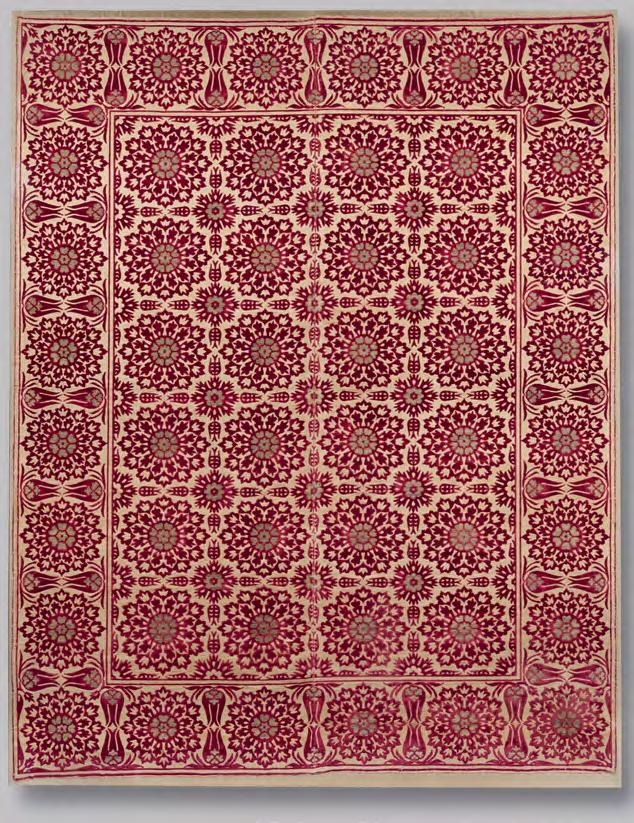
35 OTTOMAN BROCADED AND VOIDED SILK VELVET DECORATED WITH DATE PALMS, TULIPS AND CARNATIONS
Ottoman Empire
First Half of the 17th Century
Dimensions: 63 x 64 cm.
Brocaded and voided silk velvet with gilt and silver thread, with a design of date-palms within an ogival lattice.
The motif of the date palm is one of the most ancient in Islamic art and indeed in earlier times it served as a kind of icon of the Middle East. Under the Ottomans the motif continued in popularity, appearing in velvets and silks. Tulips, on the other hand, were among the most favoured flowers in the Ottoman decorative repertoire. The tulip has a symbolic meaning. The letters of the word tulip (Lâle [ هللا]) in Turkish and Persian are the same letters used for writing the word Allah [ الله] (God). These two words have the same numerological value in the abjad system (a decimal alphabetic numeral system in which the twenty-eight letters of the Arabic alphabet are assigned numerical values). Tulip is one of the leading decorative elements in Ottoman art; frequently used together with roses, hyacinths, saz leaves. It is also used with khatai blossoms as can be seen in the present tile. Tulip also played a role in imagery in Ottoman poetry. In many poems, tulip leaves are likened to the cheeks of the beloved. The word lāleh-khad (lâle-had), often used in Ottoman poetry, means ‘tulip-cheeked’. Tulips were among the most favoured motifs used in the Ottoman court workshops in the 16th century. The name ‘tulip’ is thought to have derived from the Turkish word tülbend (from the Persian word دنبلد [dulband]) -meaning ‘large cotton band which is used in the making of turban or headgear’- because of the fancied resemblance of the flower to a turban.
This velvet belongs to a small group of imperial Ottoman velvets which were produced in special workshops, in Istanbul and Bursa, attached to the Ottoman court. Such velvets were used for producing imperial kaftans, ceremonial costumes as well as wall hangings and divan covers to be used and gifted by the Ottoman elite. In vertical and horizontal rows and infinitely repeated designs they created a highly decorative effect which was embraced both at home and abroad, especially in Eastern Europe and Russia. Apart from kaftans and furnishing fabrics produced for the court, these velvets were also used as ecclesiastical garments, a proof of their versatility and cultural exchange. A Russian Orthodox chasuble (sakkos) made of an almost identical Ottoman silk velvet, decorated with date-palms, tulips and carnations, is in the Sergiev Posad Museum Preserve Zagorsk (Inv. No. 2404). Please see, Nurhan Atasoy, etal.İpek–TheCrescent&theRose: Imperial Ottoman Silks and Velvets, Azimuth Editions, London, 2001, p. 153, pl. 106.
For other, crimson, and blue examples in the Topkapi Palace Museum Istanbul, Calouste Gulbenkian Foundation Lisbon, State Historical Museum Moscow see, ibid, pp. 306-307.
Provenance
Private French Collection, Lyon.

98
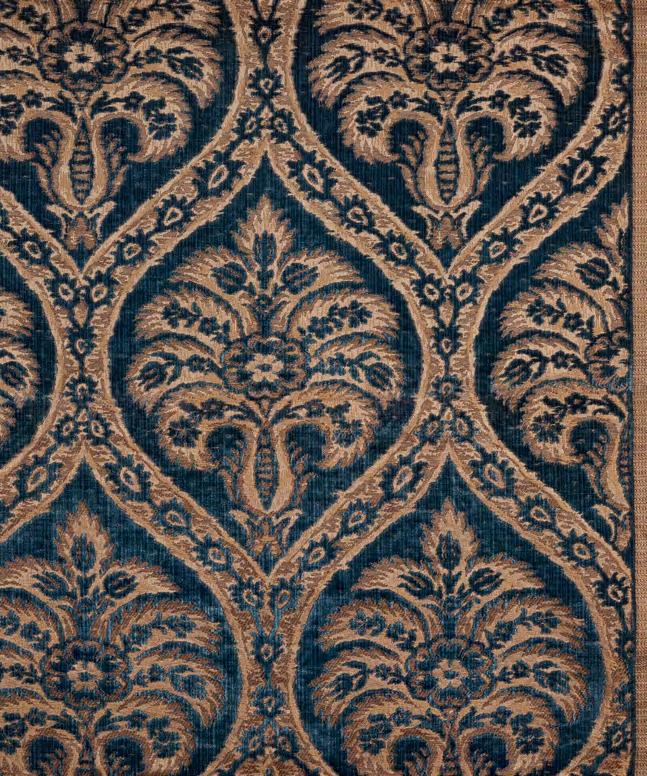
Ottoman Empire
First Half of the 17th Century
Dimensions: 63 x 58.5 cm.
OTTOMAN BROCADED AND VOIDED CRIMSON SILK VELVET DECORATED WITH DATE PALMS, TULIPS AND CARNATIONS
Brocaded and voided crimson silk velvet with gilt and silver thread, with a design of date-palms within an ogival lattice.
The motif of the date palm is one of the most ancient in Islamic art and indeed in earlier times it served as a kind of icon of the Middle East. Under the Ottomans the motif continued in popularity, appearing in velvets and silks. Tulips, on the other hand, were among the most favoured flowers in the Ottoman decorative repertoire. The tulip also has a symbolic meaning. The letters of the word tulip (Lâle [ هللا]) in Turkish and Persian are the same letters used for writing the word Allah [ الله] (God). These two words have the same numerological value in the abjad system (a decimal alphabetic numeral system in which the twenty-eight letters of the Arabic alphabet are assigned numerical values). Tulip is one of the leading decorative elements in Ottoman art; frequently used together with roses, hyacinths, saz leaves. It is also used with khatai blossoms as can be seen in the present tile. Tulip also played a role in imagery in Ottoman poetry. In many poems, tulip leaves are likened to the cheeks of the beloved. The word lāleh-khad (lâle-had), often used in Ottoman poetry, means ‘tulip-cheeked’. Tulips were among the most favoured motifs used in the Ottoman court workshops in the 16th century. The name ‘tulip’ is thought to have derived from the Turkish word tülbend (from the Persian word دنبلد [dulband]) -meaning ‘large cotton band which is used in the making of turban or headgear’- because of the fancied resemblance of the flower to a turban.
This velvet belongs to a small group of imperial Ottoman velvets which were produced in special workshops, in Istanbul and Bursa, attached to the Ottoman court. Such velvets were used for producing imperial kaftans, ceremonial costumes as well as wall hangings and divan covers to be used and gifted by the Ottoman elite. In vertical and horizontal rows and infinitely repeated designs they created a highly decorative effect which was embraced both at home and abroad, especially in Eastern Europe and Russia. Apart from kaftans and furnishing fabrics produced for the court, these velvets were also used as ecclesiastical garments, a proof of their versatility and cultural exchange. A Russian Orthodox chasuble (sakkos) made of an almost identical Ottoman silk velvet, decorated with date-palms, tulips and carnations, is in the Sergiev Posad Museum Preserve Zagorsk (Inv. No. 2404). Please see, Nurhan Atasoy, etal.İpek–TheCrescent&theRose: Imperial Ottoman Silks and Velvets, Azimuth Editions, London, 2001, p. 153, pl. 106.
For other, crimson, and blue examples in the Topkapi Palace Museum Istanbul, Calouste Gulbenkian Foundation Lisbon, State Historical Museum Moscow see, ibid, pp. 306-307.
Provenance
Private French Collection, Lyon.

36
100

Painted and mirror polished stainless steel, mechanical system 200 x 200 x 16 cm
CONRAD SHAWCROSS PATTERNS OF ABSENCE (MS20D17 ∆ )
Imbued with an appearance of scientific rationality, Conrad Shawcross’ RA (b. 1977) often monumental sculptures explore subjects that lie on the borders of geometry and philosophy, physics and metaphysics.
Inspired by different technologies, the artist's structures may retain in appearance the authority of machines – yet their raison d’être remains elusive, filled with paradox and wonder. Some have a melancholy feel, while others tend to the sublime, substituting the purely functional for phenomenological experience.
Over two decades, Shawcross has paid tribute to some of the great pioneers and analysts, and considered specific moments or figures from the past. Shawcross’ art dons a cloak of rationality in order to conceal its more poetic heart. Interrogating what we take for granted and encouraging us to see beyond the physical and remember how limited our perception envelope really is.
Shawcross has completed numerous monumental public commissions across the world, including Paradigm (2016) outside the Francis Crick Institute in London, the 50 metre tall The Optic Cloak (2016) in Greenwich, the 18-metre tall Exploded Paradigm (2018) inside the atrium of the Comcast Technology Center in Philadelphia, Schism (2020) at Château La Coste in Provence, France, the 4.5-metre tall Enwrought Light Fracture in honour of the poet W.B. Yeats in Chiswick (2022), and Manifold 5:4 (2023) at the Liverpool Street Entrance to the Elizabeth Line. He has exhibited at institutions across the world, including Palais de Tokyo in Paris, Mori Art Museum in Tokyo, the Museum of Old and New Art in Tasmania, Wadsworth Atheneum in Connecticut, USA, the National Gallery in London, ARTMIA in Beijing, Château La Coste in France, the Mathematical Institute in Oxford, and MICAS in Malta.
102 37

Acrylic on Canvas
Dimensions: 160.8 x 100 cm.
2023.
BEN JOHNSON I'TIMAD UD DAULAH - JAALI
Ben Johnson was born in Llandudno, Wales, in 1946. He studied at the Royal College of Art and has lived and worked in London since 1965.
His first solo exhibition was at the Wickesham Gallery, New York, in 1969 immediately after graduating from the Royal College. He is best known for his paintings based on architectural spaces (some almost forensically accurate, others heavily manipulated) and his large-scale, intricately detailed cityscape paintings, which include panoramas of Hong Kong, Zürich, Jerusalem, Liverpool and his view of London which was completed as part of a residency at the National Gallery, London, in 2010. Over the past 46 years he has exhibited widely in galleries and museums across the world, including the Institute of Contemporary Arts, London; the Walker Art Gallery, Liverpool; the Art Institute of Chicago; Kunsthalle Tübingen; and the Museo Thyssen-Bornemisza, Madrid. At the first Venice Architecture Biennale in 1991, Norman Foster portrayed his work solely through Johnson's images and he included him again in his installation there in 2012. His work was part of a travelling exhibition which toured museums in Europe from 2012 - 2017 with several venues achieving record visitor numbers, and the first retrospective exhibition of his paintings opened in September 2015 at the Southampton City Museum and Art Gallery. Johnson has for years been an Honorary Fellow of the Royal Institute of British Architects for his contribution to the public’s understanding of contemporary architecture and, in 2015, was made an Honorary Fellow of Glyndwr University, Wales, for services to the public appreciation of the Arts. In 2017 he was made a Member of the Royal Cambrian Academy in Wales.
In 2023 five of his works were shown at the Centre Pompidou, Paris as part of the exhibition "Norman Foster". From January to March this year he will be exhibiting in the international competition “The Architecture Drawing Prize” at the Sir John Soane’s Museum, London, as the winner of the Hand-Drawn category.
He has undertaken commissions for the Royal Institute of British Architects, the British Museum and National Museums Liverpool as well as for IBM, HSBC, JP Morgan, British Steel, Hong Kong Telecommunications and many others.
His work is included in the permanent collections of museums worldwide, including the Victoria & Albert Museum, London; the Centre Georges Pompidou, Paris; the Museum of Modern Art, New York; the Regional Services Museum, Hong Kong; and the Government Art Collection.
38
104

39 EBTISAM ABDULAZIZ UNTITLED 2023 (3)
Acrylic on canvas.
Dimensions: 91.5 x 122 cm.
Ebtisam Abdulaziz is a multidisciplinary artist and writer. She explores issues of identity and culture through installation, performance, mixed-media, painting and works on paper. Combining the scientific with the arbitrary, Abdulaziz draws from her training in science and mathematics, methodically exploring subconscious states and the expansiveness of daily life. She creates codes, systematic structures, graphic language, and performative gestures to force viewers to question their assumptions about rules in the natural and formulaic world. The intimate juxtapositions of these concepts center awareness on our surrounding environment and the issues that perplex and shape us.
Ebtisam Abdulaziz work has been exhibited at the 53rd Venice Biennale as part of the United Arab Emirates and Abu Dhabi Pavilions, Venice, Italy; at the 7th and 10th Sharjah Biennial, Sharjah, United Arab Emirates; Dubai Next, Basel; The Institut du Monde Arabe, Paris, France; The Kunst Museum, Bonn, Germany; The Mori Art Museum, Tokyo, Japan; Benin Biennial 2012, Kora Centre, Benin; FotoFest Biennial, Art in Houston, Texas; Cara Gallery; Smack Mellon gallery in New York; NYUAD Art Gallery; Guggenheim Abu Dhabi, The Florida Museum of Photographic Arts; Tampa; American University Museum at the Katzen Arts Center. In 2014, her work was part of the touring exhibition of Past Forward: Contemporary Art from the Emirates, which took place across several American cities and is included in international collections. Her installations, paintings, works on paper and videos are held in numerous public and private collections. Her video work, Autobiography 2007, was purchased for the Guggenheim Museum collection, Abdu Dhbai, UAE. Abdulaziz was named as one of 100 powerful Arab Women of 2013 list. She has been living between Abu Dhabi and Washington, D.C. since 2014.
106
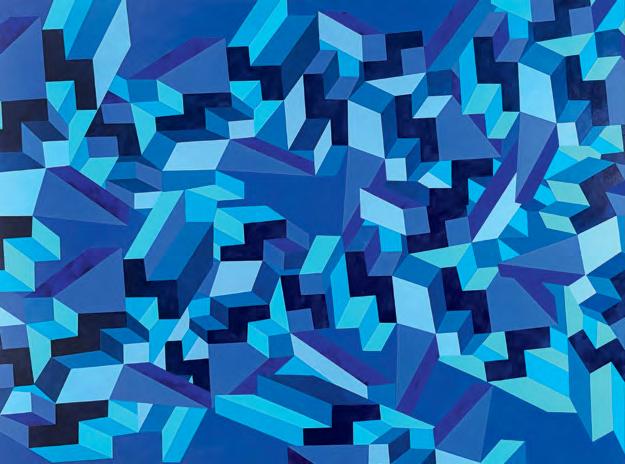
Steel, magnets 3 + 1AP
Dimensions:
19.0 x 19.0 x 74.0 cm
TIMO NASSERI STUPA
Timo Nasseri (b. 1972, Berlin, Germany) lives and works in Berlin. He received his diploma in photography from the Lette-Verein, Berlin in 1997. Nasseri's work is a captivating exploration of geometry, mathematics, architecture, calligraphy, and, most recently, camouflage. Combining elements from Islamic and Western cultural heritages, Nasseri's art is a unique blend of specific memories, religious references, and universal archetypes, all described through the lens of mathematics and language. His creations delve into the inner truths of form and rhythm, transforming these elements into metaphysical explorations.
One notable facet of Nasseri's oeuvre is his exploration of Islamic architecture and patterns, infusing his work with a metaphysical quality. Integrating Islamic and Western cultural heritages, Nasseri's art becomes a tapestry woven from specific memories, religious references, and universal archetypes described by mathematics and language. His drawings and sculptures not only visually represent Islamic art but also delve into the inner truths of form and rhythm, exploring the metaphysical implications of these intricate patterns.

Beyond his engagement with Islamic architecture, Nasseri's work delves into the profound connection between mathematics and spiritual ideas. Referencing literature and mathematical concepts, Nasseri explores themes of infinity, transcendence, and metaphysics. His artistic practice becomes a tool to unravel historical mysteries and embark on explorations via mathematical theorems, seeking an overarching order within the chaos of existence.
These multifaceted explorations offer a unique perspective on the relationship between mathematics, literature, and spirituality. Nasseri's creations are a testament to his commitment to opening up new ways of seeing and understanding the world, bridging the gap between the empirical and the metaphysical. His artistic journey is a captivating odyssey into the realms of natural science, mathematics, and poetry. His ability to seamlessly intertwine these disciplines results in a body of work that is not only visually stunning but also intellectually profound, inviting viewers to contemplate the interconnectedness of the empirical and the imaginative.
108
40

BIBLIOGRAPHY
Akalın, Şebnem et al. Yadigar-ı KütahyaSunaveİnanKıraçKoleksiyonundanKütahya Seramikleri, Akdeniz Medeniyetleri Araştırma Enstitüsü, İstanbul, 1997.
Alexander, David. The Arts of War – Arms and Armour of the 7th to 19th Centuries, The Nour Foundation, Azimuth Editions and Oxford University Press, London, 1992.
Allan, James. Islamic Metalwork: the Nuhad Es-Said Collection, London, 1982.
Alpaslan, Oktay. Arça S.‘Osmanlı sarayında İtalyan İpeklileri/I tessuti in seta italiani nel Palazzo ottomano’ In Bellingeri G., Ölçer N. & Romanelli G. (Eds) Osmanlı Döneminde Venedikveİstanbul/VeneziaeIstanbulinEpoca Ottomana, Electa, Milan, 2009, pp. 210-225
Arlı, Belgin Demirsar et al. Tiles – Treasures of Anatolian Soil – Ottoman Period, Kale Group Publications, Istanbul, 2008.
Atasoy, Nurhan & Julian Raby Iznik: The PotteryofOttomanTurkey, Thames & Hudson, London, 1989.
Atasoy, Nurhan, etal.İpek–TheCrescent& the Rose: Imperial Ottoman Silks and Velvets, Azimuth Editions, London, 2001.
Atasoy, Nurhan, A Garden for the Sultan: Gardens and Flowers in the Ottoman Culture, Aygaz, Istanbul, 2002.
Baer, Eva. Metalwork in Medieval Islamic Art, New York, 1983.
Balakrishnan, U.R. & M. Sushil Kumar, Dance ofthePeacock:JewelleryTraditionsinIndia, Bombay, 2001.
Ballian, Anna-Rosa & Mina Moraitou, Maria Sardi. Benaki Museum – A Guide to the Museum of Islamic Art, Athens, 2006.
Bayani, Manijeh. “A Note on the Content and Style of Inscriptions” in Oya Pancaroğlu, Perpetual Glory – Medieval Islamic Ceramics fromtheHarveyB.PlotnickCollection, The Art Institute of Chicago, Yale University Press, New Haven, 2007, pp. 154-155.
Belger, Krody Sumru. Flowers of Silk & GoldFourCenturiesofOttomanEmbroidery, Merrell & The Textile Museum, Washington D.C., 2000.
Bilgi, Hülya. Ateşin Oyunu – Sadberk Hanım MüzesiveÖmerM.KoçKoleksiyonlarından İznikÇiniveSeramikleri, Vehbi Koç Vakfı, İstanbul, 2009.
Bloom, Jonathan & Sheila Blair. The Art and Architecture of Islam 1250-1800, London, 1995. Boppe, Auguste. Les Peintres du Bosphore au XVIIIe Siècle, ACR Edition, Paris, 1989.
Born, R., Dziewulski M. & Messling G. The Sultan’s World: The Ottoman Oriental in Renaissance Art, Bozar Books, Brussels, 2015.
Carswell, John & Mina Moraitou and Melanie Gibson, Iznik Ceramics at the Benaki Museum, Benaki Museum - Gingko, London, 2023.
Carswell, John. KütahyaTilesandPotteryfrom the Armenian Cathedral of St. James, Jerusalem, Volume I-II, Clarendon Press, Oxford, 1972.
Degeorge, Gérard et al. The Art of the Islamic Tile, Flammarion, 2002.
De Jonghe et al. The Ottoman Silk Textiles oftheRoyalMuseumsofArtandHistoryin Brussels, Brepols, Turnhout, 2004.
Denny, Walter B. Iznik:TheArtistryofOttoman Ceramics, London, 2004.
Derman, Çicek et al. “Şahkulu”, TDV Islam Ansiklopedisi, Vol. 38, 2010, pp. 283-284.
Erber, Christian. A Wealth of Silk and Velvet: Ottoman Fabrics and Embroideries, Edition Temmen, Bremen, 1993.
Falk, Toby. Treasures of Islam, London, 1985.
Haja, Martina & Günther Wimmer. Les Orientalistes des Écoles Allemande et Autrichienne, ACR, Paris, 2000.
Hanaway, William N. “Eskandar-nāma”, Encyclopaedia Iranica, Vol. VIII, Fasc. 6, pp. 609-612.
Hitzel, Frédéric et al. Iznik – L’Aventure d’une Collection, Musee National de la Renaissance –Chateau d’Ecouen, Paris, 2005.
Grube, Ernst. IslamicPotteryoftheEighthto theFifteenthCenturyintheKeirCollection, Faber & Faber, London, 1976.
Grube, Ernst. Cobalt and Lustre, The Nour Foundation, Ed. Julian Raby, Azimuth Editions, Oxford University Press, 1994.
Gürsu, N. The Art of Turkish Weaving: Designs through the Ages, Redhouse Press, Istanbul, 1988.
Jones, Owen. The Grammar of Ornament –A Unique Collection of Classical Designs from Around the World, Girard & Steward, 1856.
110
Kayaoğlu, Gündağ. Tombak, Dışbank, 1992.
Krahl, Regina & John Ayers. Chinese Ceramics in the Topkapı Saray Museum – Istanbul –A Complete Catalogue III – Qing Dynasty Porcelains, Sotheby’s Publications, London, 1986.
Kadoi, Yuka. “On the Timurid Flag”, Beiträge zur Islamichen Kunst und Archäologie, Band 2, Weisbaden, 2010, p. 140-151.
Lane, Arthur. EarlyIslamicPottery, London, 1947.
Leach, Linda York. Mughal and Other Indian Paintings, Dublin, 1995.
Lings, Martin. TheQur’anicArtofCalligraphy and Illumination, Westerham, 1976.
Mackie, Louise W. SymbolsofPower–Luxury TextilesfromIslamicLands7th–21stCentury, Ed. Daniel Shaffer, The Cleveland Museum of Art, Yale University Press - New Haven and London, 2015.
Melikian-Chirvani, Assadullah Souren. Victoria and Albert Museum Catalogue – Islamic Metalwork from the Iranian World – 8th-18th Centuries, London, 1982.
Mohamed, Bashir. The Arts of the Muslim Knight – The Furusiyya Art Foundation Collection, Skira, 2007.
Monnas, L. Renaissance Velvets, V&A Publishing, London, 2012.
Watson, Oliver. Ceramics of Iran – Islamic PotteryfromtheSarikhaniCollection, Yale University Press, London, 2020.
Ölçer Nazan, et al. Museum of Turkish and Islamic Art, Akbank, Istanbul, 2002.
Petrasch, Ernst et al. Die Karlsruher Turkenbeute, Hirmer Verlag Munchen, München, 1991.
Phillips, A. Everyday Luxuries: Art and Objects in Ottoman Constantinople, 1600-1800, Verlag Kettler, Berlin, 2016.
Pitarakis, Brigitte et al. A Treasured Memory –Ecclesiastical Silver from Late Ottoman Istanbul in the Sevgi Gönül Collection, Sadberk Hanim Müzesi, Istanbul, 2006.
Piotrovsky, Mikhail. Beyond the Palace Walls –Islamic Art from the State Hermitage Museum, NMS, 2006.
Porter, Venetia. Arabic and Persian Seals and Amulets in the British Museum, The British Museum, London, 2011.
Rackham, Bernard. Islamic Pottery and Italian Maiolica, London, 1959.
Ribeiro, Maria Queiroz. Iznik Pottery – Museo Calouste Gulbenkian, Lisboa, 1996.
Rogers, J. M., Hülya Tezcan, Selma Delibaş. Topkapı - Costumes, Embroideries and other Textiles, Thames and Hudson, London, 1986.
Rogers, J.M. Topkapı: The Treasury, Thames & Hudson, London 1987.
Safwat, Nabil F. Understanding CalligraphyThe Ottoman Contribution: From the Collection of Cengiz Çetindoğan, Azimuth Editions, London, 2014.
Saner, Turgut. “Lale Devri Mimarlığında Hint Esinleri: Çinihane”, Sanat Tarihi Defterleri, Vol: III, Istanbul, 1999, pp.35-49.
Soudavar, Abolala. Art of the Persian Courts, Art and History Trust Collection, Rizzoli, New York, 1992.
Stanley, Tim. Palace and Mosque: Islamic Art from the Middle East, V&A Publications, London, 2004.
Shu-Ping, Teng et al. Treasures from Across the Kunlun Mountains: Islamic Jades in the National Palace Museum Collection, National Palace Museum Taiwan, Taipei, 2008.
Taylor, Roderick. Ottoman Embroidery, Studio Vista, London, 1993.
Tezcan H., Delibaş S. & Rogers J. M. The Topkapı Saray Museum, Costumes, Embroideries and other Textiles, A New York Graphic Society Book, Little, Brown and Company, Boston, 1986.
Voigt, Friederike. “Equestrian Tiles and the Rediscovery of Underglaze Painting in Qajar Iran”, Revealing the Unseen: New Perspectives on Qajar Art, Edited by Gwenaëlle Fellinger & Melanie Gibson, Gingko – Louvre Editions, Paris, 2021, pp. 151-161.
Walter B. Denny, Iznik:TheArtistryofOttoman Ceramics, London, 2004.
Ward, Rachel. “Tradition and Innovation: Candlesticks made in Mamluk Cairo”, Islamic Art in the Ashmolean Museum, Oxford Studies in Islamic Art, Vol: 10, Part II, Edited by J. W. Allan, Oxford, 1995, pp. 147-158.
Watson, Oliver. Ceramics From Islamic Lands – Kuwait National Museum – The Al-Sabah Collection, Thames & Hudson, London, 2004.
EXHIBITION CATALOGUES
Alexandria 1925 - Exposition d’Art Musulman, Les Amis de l’Art, Alexandrie, 1925.
Oregon 1973 - Indian Miniatue Paintings fromTheCollectionofEdwinBinney,3rd,The Mughal and Deccani Schools with Some Related Sultanate Material, an exhibition at the Portland Art Museum, December 2, 1973-January 20, 1974, Portland Art Museum, Oregon, 1973.
Washington 1981 - Renaissance of Islam: Art of the Mamluks, Texts by Esin Atil, the National Museum of Natural History, Washington, 1981.
Lisboa 1982 - Museu Calouste GulbenkianCatalogo, Fundaçao Calouste Gulbenkian, Lisboa, 1982.
Istanbul 1983 - The Anatolian Civilisations–Seljuk/Ottoman, vol. III, Turkish Ministry of Culture and Tourism, Istanbul, 1983.
Washington 1987, Chicago 1987, New York 1988
- TheAgeofSüleymantheMagnificent, National Gallery of Art, Texts by Esin Atıl, Exhibition dates: National Gallery of Art, 25 January-17 May 1987, the Art Institute of Chicago, 14 June-7 September 1987, the Metropolitan Museum of Art, New York, 4 October 1987-17 January 1988, Washinton, 1987.
London 1988 - SüleymantheMagnificent, texts written by J. M. Rogers & R. M. Ward, British Museum Publications, London, 1988.
Venice 1993 - Guardi – Quadri Turcheschi, 28 August – 21 November 1993, Vol: I-II, Fondazione Giorgino Cini, Istituto di Storia dell’Arte, Venice.
Budapest 1994 - Nagy Szulejman Szultan Es Kora, Magyar Nemzeti Muzeum, Budapest, 1994.
New York 1998 - Royal Persian Paintings – The Qajar Epoch 1785-1925, Edited by Layla S. Diba and Maryam Ekhtiar, I. B. Tauris Publishers in Association with Brooklyn Museum of Art, New York, 1998.
Istanbul 2000 - The Sultan’s Portrait: Picturing the House of Osman, catalogue of the exhibition held at the Topkapı Palace Museum between 6 June and 6 September 2000, by Serpil Bağcı, Filiz Çağman, Julian Raby, Jürg Meyer zur Capellen, Hans Georg Majer, Jürg Meyer zur Capellen, Gülru Necipoğlu, Banu Mahir, Gül İrepoğlu, Günsel Renda, Istanbul, Türkiye İş Bankası, Publishing no: 464, Art Series: 65, 2000.
Paris 2000 - Splendeurs de la Ceramique OttomanedesCollectionsSuna-İnanKıraçetdu Musée Sadberk Hanım, Musée Jacquemart- André – Institut de France, Istanbul, 2000.
Istanbul 2001 – Topkapı Palace – The Imperial Treasury, texts by Emine Bilirgen & Süheyla Murat, MAS, Istanbul, 2001.
Indianapolis 2002 - Gifts to the Tsars: 1500-1700, Treasures from the Kremlin, texts by Shifman, B. and G. Walton, Indianapolis Museum of Art, Indianapolis, 2002.
Istanbul 2003 - Lale Devrinin bir Görgü Tanığı Jean-Baptiste Vanmour, Texts written by Eveline Sint Nicolaes et al, Koçbank, İstanbul, 2003.
Alabama 2004 - Ottoman Treasures: Rugs and Ceramics from the Collection of Dr. and Mrs. William T Price, Birmingham Museum of Art, Alabama, 2004.
Istanbul 2005 – Asırlar Sonra Bir Arada: Sadberk Hanım Müzesi’nin Yurtdışından Türkiye’ye Kazandırdığı Eserler, 4 December 2005 – 28 February 2006, Sadberk Hanım Museum, Istanbul, 2005.
Amsterdam 2006 - Istanbul: The City and the Sultan, exhibition catalogue, December 16, 2006 - April 15, 2007, organised by Stichting Projecten De Nieuwe Kerk, Amsterdam, 2006.
Istanbul 2006 - Sandıklarda Saklı Saray Yaşamı, Exhibition held in the Dolmabahçe Palace, TBMM Milli Saraylar, Mas Matbaası, İstanbul, 2006.
Paris 2006 - From Cordoba to Samarqand –Masterpieces from the Museum of Islamic Art in Doha, Exhibition held between 30 March – 26 June 2006, Musée du Louvre Editions, 5 Continents, 2006.
Hong Kong 2007 - Crossroads of Ceramics –Turkey, where the East and the West Meet, World of Ceramic Exposition Foundation, Joseon Royal Kiln Museum, Kwon Doo Yhun, 2007.
Istanbul 2007 - Çatma & Kemha – Ottoman Silk Textiles, Texts written by Hülya Bilgi, Exhibition held between 14 April – 10 June 2007, Sadberk Hanım Museum, Istanbul, 2007.
Istanbul 2008 - Istanbul, Isfahan, Delhi. 3 Capitals of Islamic Art. Masterpieces from the Louvre Collection, exhibition catalogue, 2008.
Istanbul 2008 - The Lure of the East – British Orientalist Painting, Ed. Nicholas Tromans, Tate Publishing, Tate – Pera Museum - Sharjah Museum, 2008.
Paris 2008 - Le Chant du Monde L’Art de l’Iran Safavide 1501-1736, text by Assadullah Souren Melikian-Chirvani, Musée du Louvre, Paris, 2008.
Seville 2008 - OttomanCalligraphyfromthe Sakip Sabancı Museum, Real Alcazar, Seville, 4 April – 15 June 2008, Sakip Sabanci Museum, 2008.
Istanbul 2009 – BirReformcu,ŞairveMüzisyen: Sultan III. Selim Han, Topkapı Palace Museum, TC. Kültür ve Turizm Bakanlığı, Istanbul, 2009.
Istanbul 2010 - Âb-ıHayat–Geçmişten Günümüze İstanbul’da Su ve Su Kültürü, Istanbul, 2010.
Abu Dhabi 2009 - Islam – Faith and Worship, Abu Dhabi Culture and Heritage, Abu Dhabi, 2009.
Athens 2010 - Aspects of Armenian Art: The KalfayanCollection, Museum of Byzantine Culture Thessaloniki, June 11 – October 10, 2010, Athens, 2010.
Copenhagen 2015 - Sensual Delights: Incense Burners and Rosewater Sprinklers from the World of Islam, Joachim Meyer, Catalogue of an exhibition held at the David Collection, March 20-September 6, 2015, The David Collection, Copenhagen, 2015.
Lens 2018 - L’Empire des Roses: Chefs-d’œuvre de l’Art Persan du XIXe Siècle, Snoeck, Louvre Lens, Paris, 2018.
Istanbul 2020 - Motif from the Sadberk Hanim Museum Collection, written by Turgut Saner, Şebnem Eryavuz and Hülya Bilgi. Sadberk Hanim Museum, Istanbul, 2020.
Paris 2021 - Cartier Et Les Arts De L’Islam Aux Sources De La Modernité, Musée des Arts Décoratifs, DMA, Paris, 2021.
COPYRIGHT KESKINER KENT ANTIQUES LIMITED DESIGNED BY PETER KEENAN PHOTOGRAPHY BY RICHARD VALENCIA REPRO BY RICHARD HARRIS PRINTED BY GRAPHIUS

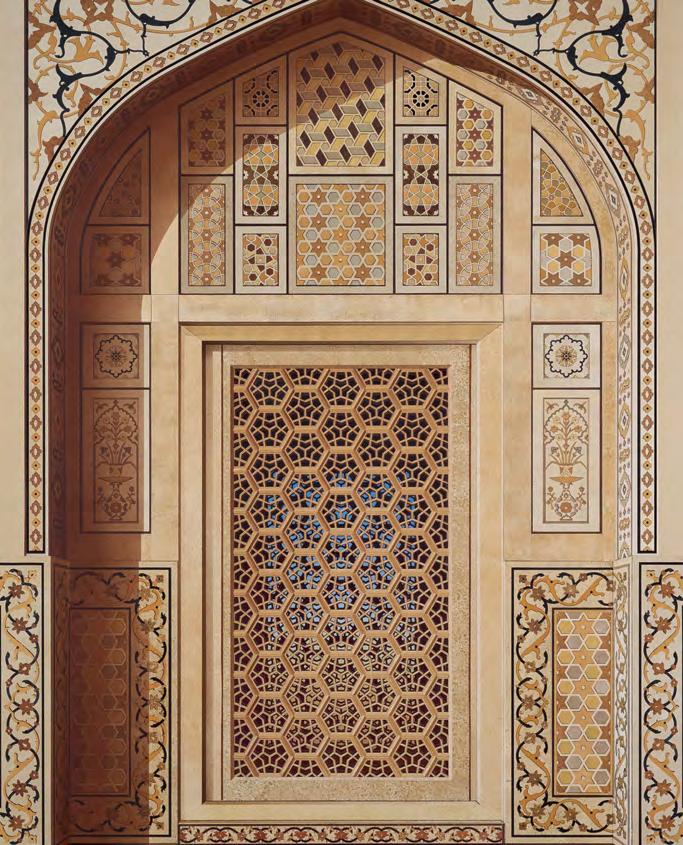
KESKINER KENT ANTIQUES
ISLAMIC & INDIAN ART ORIENTALIST PAINTINGS





























































































 Zenop Manas, the painter
Zenop Manas, the painter


 Genealogical tree of the Ottoman dynasty painted by Zenop Manas, under Sultan Mahmud II (r. 1808- 1839), the Mekhitarist Monastery, Vienna. After Garo Kürkman, Osmanliİmparatorluğunda Ermeni Ressamlar, İstanbul, 2004, vol:II, p. 593.
Genealogical tree of the Ottoman dynasty painted by Zenop Manas, under Sultan Mahmud II (r. 1808- 1839), the Mekhitarist Monastery, Vienna. After Garo Kürkman, Osmanliİmparatorluğunda Ermeni Ressamlar, İstanbul, 2004, vol:II, p. 593.
















 Part VI
Part VII
Part VIII
Part X
Part XI
Part IX
Part VI
Part VII
Part VIII
Part X
Part XI
Part IX


 The camel carrying the cover of the tomb of Phophet Muhammad
The standard-bearer carrying the banner of Prophet Muhammad
The camel carrying the cover of the tomb of Phophet Muhammad
The standard-bearer carrying the banner of Prophet Muhammad









































